知识与问题的张力,从你这里展开。
#思考 昨天看到书里的一段内容讲:“女人是男人的肋骨做的 ,里面还提到了 在权力不平等的状态下,女人用自己的身体网住男人从而控制住男人,街上的商品饰品大部分都是为了女人生产的(女人,情侣,孩子 也是),女人奴役着劳动,就好像犹太人用金钱的势力来报复对自己的压迫一样“。 但是我想到女人在这里似乎是起到装饰品的作用。即使现在提倡的性别平等,似乎也是从男人的视角发展出来的。 里面还有一段话很有意思 ”短期的妓女让人唾弃,长期的妓女受人尊敬“,当然现在的审美也是为了满足男人的性趣。里面还提到一点,”只要思想上对看到的女人起了淫念,那么就已经跟这个女人发生了关系", 并且不知道什么时候开始站在女人旁边就已经无法很平静的交流没有其他念头升起。此时我想到的确是贾宝玉,他似乎就是那一个纯净的人。终究还是男人内心笔下的女人,女人如何深刻的描写女人呢?西蒙·德·波娃 的第二性预备着了,看不完根本看不完 —托尔斯泰《克莱采奏鸣曲》
#碎碎念 我是真喜欢已读乱回啊,且喜欢凑热闹。看得出阅读理解是存在很大的问题的,但这个问题可以追溯到小学每天被语文老师留下来做阅读理解题目开始算起了。时至今日似乎没见的长进多少,也算是硬伤之一。( 重新翻看 PMP 大佬们的聊天内容,注意到的一点,即使时常会撒泡尿照照自己,也只是沉浸在尿里,见不得自己。)
#思考 人们会因为游戏的规则自觉地竞争对抗起来,规则真是个神奇的东西,那么的有趣,那么的有力量
#思考 看到很多信息上说错的越多约接近真理,早上问了一个问题:”百分之 99% 无法生存,只有 1% 存在这生命 这是什么?“ GPT 给出了精子这个答案,当然这个概率是存在问题的,其实想问的是 为什么 大部分空间内都没有发现生命生物或者可以被定义有活的物体。如果这样子的话生命本身不就是真理吗?(生命是化学秩序的一个高阶分支,但信息秩序和物理秩序同样能产生极端精密的结构。)
#思考 现实世界 与 精神思维 无论如何都会存在间隙,意识本身是真实存在,但是 思维 跟 现实 存在 天然的隔离。根据 思维 和 现实 的不一致思维 不断地学习调整,来实现 自我的生存。 是让现实贴合自己的思维认识,还是调整 思维 重新 认识 现实 这里也存在问题,如果一致 思维认识现实 那么是没啥变化的,只有 思维 和 现实的冲突可以让生活变得更美好,我看到的是 无数个“世界” 对 这个现实 的不断 “认识 ”和 “不断冲突 (来源于思维和现实的间隙)” (“有效的共在”就是:在人与人之间鸿沟无法消除的前提下,找到一种能让彼此仍然生活在一起的方式。)
A collection of viewpoints, mindset, common sense, psychology, approaches and other random notes.
The qualified investor, are you qualified?
-
我这里有一点很重要的就是认为大多数人其实不碰股票就是最好的投资,除非你认为自己确实有了解的好公司处在便宜的价钱。
那些把投资股票当作赌博的人,幻想一夜暴富,不惜动用大量资金,甚至加杠杆。运气好时确实能短期内获利,但只要市场稍有波动,杠杆的放大效应就会让他们瞬间倾家荡产。
这与真正的投资背道而驰,投资本应是基于理性分析、稳健布局,追求长期价值增长。
因此
对于很多人来说,不碰股票可能就是最好的投资,起码能保证不亏本金。— 段永平 -
你要对生意感兴趣,对公司感兴趣,多过对赚钱感兴趣。如果你只是对赚钱感兴趣,那你不适合做投资。— Charlie Munger
点评:很多人所谓的喜欢“投资”,其实只是喜欢投资中“赚钱”的那部分,至于长期跟踪研究,以及亏钱的那部分则没有心理准备。 -
上班 vs. 投资?
标普500长期年化收益率是10%,如果没有分红再投入,则年化收益率只有6%~7%,这还没有计算通货膨胀对购买力的影响。
而普通投资者的年化收益率长期下来很难战胜标普500,
也就是说,算上通货膨胀,长期下来可能是白忙一场,前提是散户投资人真正做到了“长期投资”,如果追涨杀跌,则结果会更糟。可能这也解释了为什么没有太多人通过投资致富,而绝大多数人选择上班吧。 -
价值投资者最重要的特质是坚定的信念不受情绪干扰,独立思考和耐心。— 安东尼 波顿
点评:坚定的信念不意味着固执或赌性坚强,而是
有一套经历过时间锤炼的稳定的投资框架。这正是新手不具备的,也是新手亏钱的一大原因。
在投资框架打磨成熟之前,不建议个股仓位过重。
5. 成功不在于做出惊天动地的事,而是不断地把简单的事情做好(simple, but not easy)。
6. Live a conservative life: as an investor, buy assets, act broke.
7. Keep learning, find great investors and pay attention to what they’re doing.
Investing vs gambling, know what you are doing
-
投机有个问题就是不知道什么时候卖。涨了10%就想卖,卖了之后就又要投入到下一场未知的赌博中去。随着手上的筹码越来越多,一招不慎可能就回到解放前,连本带利全部赔回去。所以商业分析是真正投资是必由之路。
-
不要把投资玩成了由多巴胺驱动的短期刺激反馈循环的赌博上瘾游戏。
-
看得清收益就是投资,看不清就是赌博;“模糊的正确”前提是正确。
-
你对中国人了解不深刻,宁肯节衣缩食也要做一夜暴富的白日梦。一辈子没做过生意,不了解商业却认为自己能搞投资。这样的中国人很多。— 彭瑶
-
股票市场是个测谎仪,它永远会用腰斩、脚踝斩来测试投资者是否真的懂他所投资的公司,还是只是“碰碰运气(赌博)”?
Patience, the power of time and a long-term mindset -
The biggest thing about making money is time. You don’t have to be particularly smart — you just have to be patient. — Warren Buffett
-
“滴水石穿”,要相信时间的力量;坚持大于努力。
-
Your feeling is facts multiplied by your attention. Staying away from the market is not an option, it is a must for a long-term investor.
-
不要盯着股价看,容易被牵着鼻子走,变得短视,被动,迷茫。
-
股市就像嘈杂的菜市场,乱哄哄的,绝大多数的声音是噪音,需要自动过滤掉。
-
股市市场就是个乱哄哄,臭醺醺的菜市场,充满需要被自动过滤掉的噪音。
-
做投资,与其想抓住那些变化,不如想清楚哪些是不变的,在那些不变的地方抓住机会。
-
Checking your account more frequently won’t make your money compounding faster.
-
Investing should be more like watching paint dry or watching grass grow. If you want excitement, take $800 and go to Las Vegas. — Paul Samuelson
-
In the end, what counts is buying a good business at a decent price, and then forgetting about it for a long, long, long time. Some people can do it and some people can't. — Warren Buffett
-
In investing, a thick stomach is more important than a bright brain.
-
Checking your account won’t make your investment compounding any faster.
-
知道和懂不是一回事,“懂”需要一个把知识“内化”的过程,这个过程往往需要很长时间。
-
“The thesis underlying everything, whether you’re an actively managed fund or a passive fund, is that the U.S. will be OK. If you don’t believe that, you shouldn’t be in the stock market.” — Peter Lynch
-
What’s safe in the short-term, might be risk in the long-term (consider saving money versus investing money).
-
If you don’t plan to hold it for 10 years, don’t bother hold it for 10 minutes. — Warren Buffett
-
Save more, invest wiser, wait longer.
-
Try to get a little smarter every day and read as much as possible. — Charlie Munger
-
Being able to execute a long-time strategy is the single most advantage of retail investors over institutions.
-
Investing once won’t make you rich, investing consistently might.
Exercising once won’t make you fit; exercising consistently might; Reading once won’t make you smart, reading consistently might.
Consistency of action is the key to getting everything done. -
Accept the facts that: Sometimes, stocks give you nothing.
S&P 500 number of days without reaching prior high varies from 200 days to 1800 days based on history from 1950 to 2022. -
Valuation (P/E Ratio) rules the short-term, while revenue and profit growth create value in the long-term.
-
It's a mistake to invest in long-term assets with a short-term mindset.
-
The longer the investor holds, the higher the chance to have positive return.
-
In investing, patience is gold; (Warren Buffett) never acts in a hurry, or over work.
-
"Read 500 pages every week. That's how knowledge works. It builds up, like compound interest. All of you can do it, but I guarantee not many of you will." — Warren Buffett
本分,行稳才能致远 -
舍不是为了得。我曾经用“有借有还、再借不难”这句话来说明本分的意思。其中“有借有还”就是本分,但“再借不难”其实是功利。当你不再想着“再借不难”时,你就真的“本分”了。
点评:这是我看到的关于“本分”的解释的最好的版本了,做一件事情,因为它是正确的,而不是因为它是可能带来回报的,就是“本分”。
2. 不赚认知外的钱也是一种“本分”;想不通它的商业模式别买,想不通它的估值也别买。
3. 投资不是总想着赚取最大收益,而是追求在长时期内赚取合理收益。点评:这其实是一种“本分”。
4. 市场变幻无常,不要有侥幸心理;投资是赚耐心的钱,不是赚交易的钱。
5. Not greedy, not in a hurry.
6. Being rich is the exact opposite direction of being wealthy.
7. The point is: Successful investing is not making a lot of money quickly, but what it really about is earning reasonable returns over a long period of time — look, that’s Berkshire Hathaway, that’s the success of long-term investing.
Independent, critical thinking, first principles
-
做投资一定要独立思考,不然你不可能懂任何东西,哪怕再努力地“学习”。独立思考,你会发现世界上有太多的“一本正经地胡说八道”。
-
要分得清观点和事实;很多人把观点当事实,于是只看得见自己想看到的东西。
-
学习不要追求“多”,要追求真的“懂”;真的懂了就能举一反三,大道至简,大道理不需要太多,真传一句话,假传万卷书。
-
The key is to understand, not to learn.
-
多摆数据、讲事实,少输出或者不要输出观点。
-
任何一个理论,它的前提条件比结论更值得关注。看到任何一个结论,不要盲目相信,想想它成立的条件有哪些,不成立的情况有哪些。
-
做投资,不要人云亦云,不要说些似是而非的话,要自己想清楚。— 彭瑶
-
My idea of group decision is look into the mirror. — Warren Buffett
-
今天刷YouTube视频,刷着刷着有一个感受:
做二级市场投资两年,不仅没有变成上通天文下晓地理,古今中外侃侃而谈的样子,反而觉得要关心的事越来越少,很多事情都是“与我何干”。 -
贵出如粪土,贱取如珠玉。”一致“很贵,分歧才有机会。
-
投资不是认知变现,是认知差变现,人之差来源于独立思考。
-
Market does not tell an investor anything, public opinion pool does not make you rich in Wall street either, what matters is only if your judgements are factually right. And facts are easy to get in today’s society. — Warren Buffett
-
Maintain a healthy level of skepticism.
-
Think for yourself, avoid herd behavior.
-
Avoid first-level thinking, embrace second-level thinking.
Risks, we don’t know that we don’t know -
If you think you can predict the market, you are a fool. — Howard Marks
-
It’s not what you don’t know gets you into trouble, it’s the things that you’re sure about turns out not true. — Mark Twine
-
Respect what I don’t know.
-
If you think you can predict the market, you’re a fool. — Howard Marks
-
Risk comes from not knowing what you are doing. — Warren Buffett
-
It's technically harder to climb back up even after losing money.
-
Respect what I don’t know;there are two types of investors losing money, one is knowing nothing, the other is knowing everything.
-
Always have more questions than answers.
-
过于依赖对未来的预测的人,通常都会死的很惨。
-
Respect what I don’t know.
-
In the business world, the rear-view mirror is always clearer than the windshield. — Warren Buffett.
-
Instead of thinking how to make money when making a deal, think about how not to lose money.
Disciplines, what should stick do -
Discipline is nothing but self-respect at the highest level.
-
True wisdom in investing isn’t just knowing what to do—it’s having the discipline to do it when everyone else is doing the opposite. — Warren Buffett
-
Even the intelligent investor is likely to need considerable willpower to keep from following the crowd. — Benjamin Graham
-
If I know where I’m going to die, I won’t go there; If I know something is bad for me, I’m not going to do it.
-
Investing requires qualities of temperament way more than it requires qualities of intellect. You must supply the emotional discipline. — Warren Buffett
-
Losing money in investing? The problem might be You!
Let's assume you're investing, not speculating. The problem might not be the company you're buying, the problem might be You! You don't know the company well enough before buying it, then, you sell them on bad news because you are not prepared!
So, don’t only pay attention to the company you’re investing in, pay attention to yourself, too.
-
“Not doing anything” becomes the best option when there is no obvious long-term opportunities. Opportunity is also a cost.
-
你控制不了市场的行为和情绪,但你可以控制自己买什么,什么时候买,买多少。
-
如果我知道我会死在哪里,我不会去那里。 — 如果我知道做什么事情有什么不好的后果,我就不应该做。比如,我知道投机会亏钱,我就不应该投机;我知道吃快餐对身体不好,就不该吃快餐。
-
Limit your tries to areas of competence. If you try to predict the future of everything, you attempt too much. — Charlie Munger
-
Good investing is not necessarily about making good decisions. It’s about consistently not screwing up. — Morgan Housel
-
Operate only in your own area of competence, always stick to your own investing strategy; don’t work against yourself.
-
There was a popular saying: Don't just sit there; do something. But for investing, I'd invert it: Don't just do something; sit there. -- Howard Marks
-
Be patient and learn how to sit on your hands. — Charlie Munger
-
It doesn’t matter how often you trade, how much principal you have, it’s all about doing it right.
Cycles, the world runs on circles -
The worst feature about real estate in a depression is that it is illiquid and cannot be sold at any price. If it is free of mortgage the owner may hold on until normal times — but in most cases it is subject to mortgage — he cannot collect his rent from the tenants — and cannot pay on his mortgage or taxes and eventually loses his equity by the foreclosure route.
-
一两年的投资收益说明不了任何问题,它大概率只是股市波动的一个片段。
-
There are times, in a depression when cash money is king and many good investments can be purchased at a big discount.
-
股价涨的时候你要知道它会跌的,股价跌的时候你要知道它会涨的;市场情绪悲观的时候你要知道它会乐观起来的,市场情绪乐观的时候你要知道它会悲观下去的。总之,市场的行为和情绪都是无法预测的,非理性的,你要利用它,而不是被它影响,甚至情绪被它放大。
-
When we feel safe, we behave more dangerously; when we feel cautious, we behave in a safer manner. — Howard Marks
-
很多投资大师都是逆向投资者,逆向投资也就是在周期谷底附近买入,周期顶峰附近卖出。
-
Market moves in cycles, so does investors’ emotion.
Accounting and Finance, you really shouldn’t pick stocks if you’re not into it -
净利润是一种会计观点,它是调节出来的,不是算出来的。
-
多看财务,打好基础,少天马行空;多学习,少出手,做到这一点,就赢过90%的人了。— 彭瑶
A business mind, that’s how you think about investing -
If you understand business, you understand investments. — Warren Buffett
-
不要张口闭口“护城河”,商业模式都没搞懂谈什么护城河;也不要随随便便说“安全边际”,不懂估值哪有什么安全边际。大多数人都是鹦鹉学舌,保持谦逊,不要成为其中一个。
-
财务数据一定要结合具体的业务看才有意义。
比如,营收,费用和利润分别是如何计算的,这些数据的变动反应出公司的业务竞争力是增强了还是削弱了,是短期还是长期的。
拿电商来说,有的拿GMV作营收,例如京东,有的拿服务费所得作营收,例如拼多多;费用,同一笔费用,有的公司把它当作开支,有的公司把它转化成资本;利润,利润是可以调节的。而之所以京东和拼多多计算营收的方式不同又是由它们的业务不同而决定的,所以财务数据一定要结合具体的业务看才有意义。 -
It is the business behind the numbers that make sense, numbers alone don’t tell anything.
-
投资能力在精不在多,不在于总共投了多少家公司,而在于理解得最深的那家公司有多深。
-
我判断一个人投资水平如何,主要是看他对于生意的理解。如果能够对某些生意的要点信手拈来,那么我认为他是可以的,而不是听人吹自己收益率多少、赚了多少钱。如果讲很多逻辑,甚至天马行空的大话,基本上这种我是不交流的。 — 彭瑶
-
Beta and modern portfolio theory and the like none of it makes any sense to me; We're trying to buy businesses with sustainable competitive advantages at a low, or even a fair, price. — Charlie Munger
Strategy, be a professional because you are competing with them -
要么跟紧市场,不断提高踩对节奏的概率,要么彻底不管市场,只做自己认为正确的事。
跟紧市场比较难,市场是由人群组成的,而人群的行为是很难预测的,而且经验似乎很难积累。所以我选择后者,
彻底不管市场,只做自己认为正确的事。 -
不要试图预测市场,市场是由人群的情绪推动的,而人群的情绪是瞬息万变、无法预测的。If you think you can predict the market, you’re a fool. — Howard Marks
-
不因为“涨”所以买,才能不因为“跌”而卖。初心对结果的影响是决定性的。
-
The worst reason for buying a stock is because its price went up.
-
For most investors, making tactical investment is not the best thing they can do, they’ll do that badly. In institutions, we spend millions probably billions of dollars just try to have an edge. — Ray Dalio
A deeper discussion regarding
Strategic investing vs. Tactical investing -
每把武器都有用,但首先你要会用,而且要用对地方。
-
市场对公司往往是全员投票、充分定价的,这里面有大量专业机构和聪明人;想赚钱要么比别人挖得更努力,找到蒙尘遗珠,要么比大家更有耐心,等到市场恐慌时低价接盘,并通过长期持有来增加胜率。随大流的一个问题就是容易高位接盘,一有点小风浪自己的船就翻了,一朝回到解放前,没有安全边际。
-
寻找“非对称”的投资机会,即收益远大于风险的机会。
-
在能力圈内投资就像从装满鱼的水桶里钓鱼。
-
投资就是对世界观的投票,要选择适合自己价值观的投资方式,投资方法没有对错之分。— 大卫翁
-
公司股票的最终买家只有一个,就是是公司自己,别总想着互掏口袋的事儿。
-
交易记录拉出来,买点卖点不能像打醉拳一样,密集,又摇摇晃晃,毫无章法。每次操作都应该默认看作一次扣分。
-
Invest with preparation, not prediction. — Howard Marks
-
不要买劣质公司、不要参与不严肃的讨论;和猪摔跤只会滚得一身泥。
-
面对一个无法赢的局或毫无把握的局,最优选择是不参与。
-
我发现我适合一次持有一两只股票,拿多了会失去重心。同时持有十几二十支股票不适合我。
-
We’re all debt’s slaves.
-
Change, as in the case of the Internet, can be a friend of society. But it is the absence of change that is often the friend of the investor.
While the internet will change many things, it will not likely change the brand of gum people chew. — Warren Buffett -
越简单的题才越看得清,找简单的题解。
-
We try to stick to businesses we believe we understand—that means they must be relatively simple and stable in character. — Warren Buffett
-
回看交易记录,频繁进出几乎都是亏。频繁进出是一个危险信号!说明还没准备好这笔投资。
-
It takes just a few winners to work wonders.
-
投资不是一个能力越强收益越高的领域,而是一个对自我认知越真实、思考问题越客观才能取得较高收益的领域。
-
We don’t do startups, they don’t exist. There’s lots of territory we can handle. — Charlie Munger
-
Directional call buying, when consume as a steady appetite, is a mug’s game and often a path to the poorhouse.
-
The best offense is defense in the investing world. Once succeeded in defense, capital will compound itself by nature.
-
It's not so much about one approach being better than the other. The approach needs to match the investor's temperament. And to do that—above all else—you need to be honest with yourself about who you are.
-
Active Management is a Loser’s Game in Bull or Bear Markets.
-
Try to buy stocks at cheap valuation levels.
-
Generally speaking, to achieve market-beating returns over the long term, you need to invest in companies that grow both revenues and cash flows faster than the market.
-
After more than 25 years of investing professionally and after 9 years of teaching at an Ivy League business school, I am convinced of at least two things: If you really want to “beat the market,” most professionals and academics can’t help you, and that leaves only one real alternative: You must do it yourself.
Valuation, know what you are buying, don’t be a fool -
一家公司的合理价格不是套用公式一秒钟算出来的,是长期跟踪得来的。
-
不懂不要看价格,对于不懂的东西,价格是无意义,因为你根本不知道那是便宜还是贵,市场先生来报价(打折价)也不要理。
-
If you don’t know who’s fool on the table, then the fool might be you. — Warren Buffett
-
What the wise men think the first, the fools think the last. — Warren Buffett
-
If you attempt to assess intrinsic value, it all relates to cash flows. The only reason for putting cash into any kind of an investment now is because you expect to take cash out. — Warren Buffett
-
只谈公司不谈估值就是耍流氓;只谈买、卖,不谈仓位管理也是耍流氓。
-
It’s meaningless to talk about any ratios without considering the durability.
-
If we can’t make a decision in five minutes, we can’t make it in five months, because we can’t learn enough in the following five months (to make a decision). — Warren Buffett
-
The process of “know enough”:
Never heard of the company → Know the stock ticker → Know the company name → Know the stock performance → Know the business model → Know the opportunity → Know the competitive advantage → Know the financials → Know the customer experience → Know the management team → Know the Risks → Know the company culture → KNOW ENOUGH -
Margin of Safety, in essence, is a deep understanding of Optional Cost.
-
The stock market is full of individuals who know the price of everything and the value of nothing.
-
Higher interest rates forced a repricing of the stock market, especially for companies with high valuations relative to its peers.
Portfolio management -
We have three baskets for investing: yes, no, and too tough to understand. — Charlie Munger
-
越是重仓,越应该保持客观。 — 雪球网友
-
Dare to ask, the answer might be just there, for free.
-
Interestingly, in the beginning of year 2025, those who believe US stocks never fail were hit the hardest.
-
We’re the products of time, and so is everyone else.
-
Assets type assessment: Liquidity, Volatility, Potential of Growth, Store of Value, Durability, Tangibility, etc.
-
做投资,拥有谦虚开放的心态非常重要,不然就是一头扎进死胡同。
-
远离所有让自己关注短期波动的信息,专注于长期因素;追涨杀跌最大的问题不是浪费了手续费,而是浪费了时间。
-
什么时候自己才算成为了一个真正的投资者?至少要体内的多巴胺水平不会随着股价的波动而波动的时候,不然你只是一个沉迷于赌博的瘾君子而已。
-
Charlie and I continue to believethat short-term market forecasts are poison and should be kept locked up in a safe place, away from children and also from grown-ups who behave in the market like children.— Warren Buffett
-
加仓、减仓、调仓,都应该是深思熟虑的,有规划的,而不是随性的。
-
别盯着账上的浮盈看,浮盈可以瞬间为负;盯着手上的资产,以及它们的成本价看。
-
You should never test the depth of the water with both feet. — Warren Buffett
同理,如果没有弄清楚公司的估值,不要all-in。 -
资产配置思维和商业思维不是同一个维度的考量,前者是着眼于长期资产管理,后者是着重生意分析;前者偏向宏观,后者偏向微观。
-
Develop the mindset that you don't make money on buying nor selling, you make money from waiting and what you hold. -- Howard Marks
-
Far more money has been lost by investors trying to anticipate corrections, than lost in the corrections themselves. — Peter Lynch
-
It’s reasonable, as a retail investor, while still learning, to allocate 80% of his capital in index ETF instead of picking individual stocks.
-
Being right or wrong is less important than how much you make when you’re right and how much you lose when you’re wrong.
-
Your most valuable assets are family, health, friends, free time (independent), self-confidence, meaningful work.
-
Don’t forget to build the lifestyle you want, while building the bank account you want.
-
I can’t predict what will happen, but I should know what to do if certain things happened.
-
Always be prepared for investment portfolio of dropping 30% or more, for 1~3 years.
Revisit history of S&P 500, days to come up with the previous peak:
Human error, be alert to human weakness, learn from history
-
警惕语言的催眠作用;既要防止媒体信息的催眠,也要防止自我催眠。
-
There is nothing new in investing, only investment history you don’t know.
Year over year, investors were provided the repeated lessons learned; unfortunately, too many investors fail to learn - they keep making the same mistakes.
Because they don’t want to get rich slowly. -
The problem is not the investment, the problem is people buying a stock hoping it goes up, instead of buying a business hoping the business do well.
I mean, you thought the business was a good investment at 600 billions, and now at 200 billions, still making a crapload of money, you dislike the business? You like the money to be compounding at 30 times earnings and get a chance to get it to compound at 9 times an earnings and somehow it is terrible? -
What we have learned from history is that we haven’t learned from history.
-
New paradigms are a rare occurrence; think about the .com bubble and what’s happening now, the AI hype.
-
Experience is what you get when you didn’t get what you want.
-
It's emotionally 3 times bitter losing the same amount of money than making it.
-
Don’t invest under pressure. The worst time to shop grocery is when you’re hungry; the worst deal you would make is when you want money.
-
Investing plays all kinds of tricks on your mind.
-
The more often a stupidity is repeated, the more it gets the appearance of wisdom.
-
Common sense is not so common, fear and greedy usually overrun common sense.
-
Investors emotion always amplifies the stock price fluctuations; therefore, there are always chances to buy good businesses with a good price.
-
There is no vaccine for being over-leveraged.
-
When you combine ignorance and leverage, you usually get some pretty scary results.
陶杰是个天才。他文笔好,思想敏捷,记忆力强,中、外、古、今皆有所学。
这些加起来说不上是天才。说天才是他的联想力高。
我想,要是此君当年攻读物理或经济,前途无可限量也。
爱因斯坦认为思维最重要的是想象力。我曾经以《什么是想像力》为题下笔,说想象力就是联想力。
这里以「联想」为题,是因为「想象」这回事比较抽象,不容易有理说得清。
「联想」则比较简单易懂,有辙可循。朋友,你想不想做天才?
或者你的子女或你朋友的子女想不想做天才?
要是想的话,细读此文可也。不要读陶杰的,读我的。
首先要说的,是智商的高下与联想力的高下没有一定的关系。
爱因斯坦的智商只有一百三十多,是聪明人,但有这水平的聪明人多如天上星,
只有爱因斯坦能想得出相对论。爱氏的思考方法屡见经传:他的相对论是以例子联想出来的。
我遇过三个智商奇高的人:过目不忘,推理快如闪电。然而,以创意而言,这三君子不见有过人之处。
另一方面,佛利民、阿罗、艾智仁等人,智商高而又有创意,则算是天才了。
高斯的思想不是那么快,但创意超凡,说是天才不会有人反对。
我要说的天才的衡量准则,是要有天才的作品拿得出来给大家品评。
聪明绝顶而拿不出作品来的,说是天才没有什么意思吧。这样看,天才的定义是要有令人欣赏的创意之作为凭,
而联想力不够是不可能有创意的。这是说,联想力是衡量天才的最重要因素。
智商高可以帮忙一下,但不是那样重要。愚蠢之极的人当然不可能是天才,
智商奇高的不一定是天才。智商中等或以上,联想力奇高,天才无疑也。
智商天生使然,后天的学习不能增加智商。这个传统的看法只是在原则上那么说,
实际上智商的考试成绩,多学习一定增加。有趣而重要的问题是:联想力是天生使然呢,还是后天学习决定的?
有可取联想力的人的智商可能平平无奇,但可以有超凡的创意。是创意界定天才,不是智商的高下。
原则上,智商不能学得。联想既然不是智商,能不能学得呢?
是很奇怪的推理。如果联想可以学得,那么天才也是可以学得的了。
我不肯定联想的本领可以学,但如果是可以的话,
那我们就不妨想一下要怎样教,或怎样可以学回来。
是在这个大胆的假设下,我铤而走险地试教一下怎样联想,那就是教读者怎样成为天才了!
从来没有人说过天才可以教出来,
我自己也不相信可以,但上述的逻辑是说可以的,或起码有机会。
以我之见,联想可分三方面:横联、直联、幻联。
横联是以例子比例子,或以例子示范思维的观点。以花比美人就是横联了。
有人说,第一个以花比美人的是天才,跟着这样说的是笨伯。我同意这评语。
是的,以横联而论,天才与蠢才之别是前者的比喻是新奇的,前人没有想过。
新奇的比喻可以带出一个新的角度看问题。有了新的角度,太蠢的不能看出什么,
但智力中等或以上的就可能推出新理论或新见解,升级为天才了。
爱因斯坦是以横联比喻想出相对论的。但此公还有无与伦比的「幻联」本领,非常人能及也。
不要奢望做爱因斯坦;做次几级的天才或准天才也不错吧。
经济学行内的高斯,认为工厂污染邻居与音波频率互相干扰是类同的例子。
这也是横联。很简单,外人不认为是类同,高斯却认为是。
确定是类同后,有了新的角度,稍加推理就得到足以万世流芳的高斯定律。天才也。
横联说易甚易,但绝妙的说难极难。记着,要新奇,要类同,找到新奇而又类同的比喻,
千万不要放过。寻其新角度,左推右想,天才或近于天才的观点或作品是不难得到的。
困难是好些人提出的例子比喻似是而非,不知所谓,而中国传统更是常有这样的弱点。
古代的孟子如是,近代的孙中山也如是。
转谈直联吧。直联是夸张地联想,尽量把问题放大。
唐代的李贺诗云:「海沙变成石,鱼沫吹秦桥。」这是夸张的直联了。
试想,秦桥是石造的,鱼的口沫把秦桥吹掉,为时之久不言而喻。
好些朋友认为我喜欢说夸张的话。可能是的,因为我想时喜欢夸张地把问题放大来看。
为什么呢?因为放大了比较容易看。
在经济研究上,我讨厌那些微不足道的数字规律,以高级的统计学算来算去、搞得复杂无比的学术文章。
人有失手,马有失蹄,调查的数字略有失误,怎样统计其结论可能全盘错了。
我喜欢从夸张的实例入手。例如要推测租金管制的效果,市场租金比管制租金高百分之二十的实例我没有兴趣。
我要找市租比管租高十倍八倍的实例。这是放大,效果会因此而变得远为明确了。
同样,把一个例子以联想夸张地放大,想不出的推理结论可能突然明确地显现出来。
最后试谈幻联吧。再以李贺的诗为例,「空光远流浪,千岁随风飘」就是幻联了。
这是以幻想的方法把例子联想到虚无飘渺间。以科学而言,这会使抽象的理论比较容易地一般化。
幻联是把例子抽象化,是比较困难的工作了。换言之,幻联是把横联或直联带到真实世界不可能发生的境界那方面去。
五十年代初期,在香港西湾河我认识一位玩粤乐的高人,姓黎,众人称他为黎师傅,其人幽默风趣。
一天朋友问他:「黎师傅,游泳遇到一尾大鲨鱼,怎么办?」师傅回应:「立刻抱着牠!」当年香港建筑要打桩,
很长的桩用吊起的大锤拍下去,震耳欲聋,为时甚久。
黎师傅问:「有没有见过土地松如无物,锤一下整支长桩不见了?」
农历新年,天大寒,师傅买不起厚衣,只穿恤衫。
朋友问:「黎师傅,你是否单衣试酒?」回应道:「不是的,我是扮泰山。」这些都是幻联。
我认为联想是可以学的,虽然有些比较难学。
如果联想可以学,以上文的推理,天才也是可以学的吧。
困难是要有可观的天才之作,苦功免不了
FAQ:
联想??笔记本?
毫无疑问,今天中国青年(当然包括香港青年)的时间投资,回报率最高是学英语。
不是计算机,不是商科,不是经济学,不是数学,不是任何自然科学,
也不是艺术、文学,而是英语。一般而言,以下功夫每小时算,没有其它知识的收入回报可与英语相比。
昔日美国加州一位仁兄在荒山野岭拾得金块,无意间在酒吧炫耀了一下,消息传开,被人跟踪,
引起了历史上有名的寻金热,蜂拥而至的寻金者搞得热闹非常。七十年代初期,某晚在电视上看到以相片示范的寻金热典故。
翌日对一位研究生说:「昨晚在电视看昔日加州的寻金热,金矿没有产权界定,
但我不相信会有非私产的租值消散,应该是上选的论文题材,你不妨考虑。」这位学生跟进,论文写得好,在国际上成了名。
是不容易解释的现象。今天的神州大地,看其经济发展,纵观天下大势,青年面对的一堆一堆真金白银,
不是什么计算机什么高科技,而是英语。一个大学毕业生的月薪二千元左右,
懂得上网打字与懂得玩电子游戏差不多,不值钱。英语呢?只要说得通,写得通——与入流还有一段距离——月薪倍升。
要学到说得通,写得通这个平庸境界,大约需要一年功夫。
这是说,一般而言,花一个小时学英语,其收入回报大约是学习其它知识的两倍。
这不是金矿是什么?为什么我们见不到英语的寻金热呢?难道市场的讯息费用真的高不可攀吗?
话得说回来,上述的英语学习回报率,是指中学毕业后下一年苦功的回报,其后再下功夫,
回报率会下降。苦学英语一年不是很够用的水平,不足以下笔成文,但可以应酬,可以沟通。
这是指国内的青年,不是指香港的。香港的学子,英文中学毕业后成绩差强人意的,其英语水平可以应酬,
也即是国内的中学毕业后补加一年英语苦工。国内学英语的回报率比香港的高,因为前者有足以应酬的英语水平的青年很少。
说过了,英文不易学,主要因为字汇多而难用(常用的字比中文多两倍以上,而且重视把适当的字放在适当的地方)。
另一项困难,是英语的动词微妙(中文的动词是不用学的)。今天国内认为懂英语的,一般其实不懂。
就是那些考托福英文试成绩可观的,用字一塌糊涂,动词错得离谱,不足以应酬也。
英文难学,从足以应酬的一年苦工到可以下笔成文,还要一段长时日,而且要讲一点天赋。
英语达到下笔成文,姑勿论是否成家,很值钱,国内及香港动不动在月薪五万以上。
香港的高官薪酬高,英语水平好是一个原因。我读过曾荫权与任志刚的英语文字,
皆达下笔成文之境。更重要的证据,是八二年回港任职后教出来的学生,今天打工月薪达六位数字的几个,英语皆可下笔成文。
可能不大公平吧,但天下的大势,历史的规律,是不能反抗的。
一九五七年我远渡重洋,到北美,那时除了英语,学法语、德语、西班牙语等的学子不少。
刚好那时起,世界渐趋大同,到了六十年代中叶,美国大学的博士课程纷纷取消两种语言的起码要求。
七十年代,计算机发达,而近十年来的互联网及通讯的发达,为了减低讯息费用,
一种共通语言就无可避免地成为国际市场的选择了。
我不认为选英语作为国际的唯一共通语言一定是明智的。英语难学,是负面,但表达力强,是正面。
一负一正,正面的价值不一定比负面的代价高。然而,昔日的大英帝国是日不没国,加上先进之邦的知识分子大都懂英语,
为了节省他们的学习费用,英语被市场选定为国际语言,不难理解。要推翻这选择看来不可能,
因为不会有足够的有学之士一起地接受另一种语言。今天的趋势,是英语愈来愈普及了。
这些年中国的经济发展了不起,在国际上变得举足轻重。每次见到西洋鬼子苦学中文,
有点骄傲,但我们不要那样傻,认为再过三几十年,中文会普及天下。
鬼子佬学中文是因为他们见到中国的发展,认为懂中文会有可观的收入回报。
这不错,但等他们普及地学会中文来与我们沟通,是守株待兔,远不及我们抢先学英语那样高明。
经济贸易上的所需不论,重要的知识投资,懂英语占了很大的便宜。中译的西方书籍虽然频频出现,
但到今天还是一小部分,而一般译得不好,误导的机会不小。你要等有足够而又译得好的中译本出现才求取西方的知识呢?
还是趁早学英语,不等译本?选择是明显的吧。
香港自从推行母语教育后,学子的英语水平急转直下——这是所有中学教师都知道而又同意的。
这笔胡涂帐政府要负责。不容易明白的,是保持英语教学的学生的英语水平也下降了不少。
后者似乎是持久地下降了二十多年的效果。电子游戏的盛行可能是一个解释,
而更可信的解释是政府设立的教育署管制课本与教法,犯了语文教育的大忌。
国内学子的英语水平实在差。学校一般不重视英语,老师不足可能是原因。
有专为学生考外地英文公开试而设的学校,不少学生考得好。但语文这回事,
考公开试的成绩与实用之可行是两回事。我自己就没有把握在美国中学的英语公开试考及格,
但满有把握教美国中学生的英语老师的老师怎样写英文。
一个补救英语远为不足的办法,是北京容许私办的英语补修学校,不妨指明不能为考试而教,
要教实用的。这样,不少香港学子会见有收入可图,立刻学好英语,到国内作教师去也。
国内愿意出钱补修英语的男女长幼数以千万计。他们不是不知道金矿所在,只是问津无门而已。
FAQ:
论技术学习,英文对于自身的投资回报率目前来说确实非常高!
老师艾智仁给我最大的影响,是他永远像一个天真小孩那样看问题。
当年同学们都听说他是理论高人,智商不凡,但五十岁了,对任何问题彷佛一个小孩子第一次看世界,
给我有难以形容的感染力。教功用,他问:什么是功用?教货币,他问:什么是货币?
问他一篇大名鼎鼎的关于产出函数的文章,他问:你相信文章里说的吗?这种教育方法之前之后我没有见过。
那时艾师在行内有名,但不像十多年后那样举世知名。我推迟博士课程一年,
只为了等艾师从他造访的史坦福回到加大,先听他的课,才考他出的博士理论试题。
于今回顾,那是我在经济学习过程中作出的最好一项决定。
这决定不是受到同学的影响,而是两个其它原因。
其一是一九六二年,麻省理工的森穆逊到我就读的加大演讲。没有谁不知道森氏是当时最负盛名的经济理论家。
演讲后一位同学举手提问,森氏说:「让我教你一点价格理论吧。」跟着停下来,游目四顾,
说:「对不起,在你们这里我不敢教价格理论!」举座哗然。
大家都知道,他的意思是我们有一个艾智仁,而当时艾师不在座。
第二个原因,是我拜读过艾师于一九五○年发表的《风险、进化与经济理论》,
精妙绝伦,深不可测,于是五体投地,非拜他为师不可。
后来成为艾师的入室弟子。每次入室求教,他总像小孩子般看我提出的问题,次次如是,
影响了我对学问的处理方法。说像小孩子般看问题,其实是说从一片空白开始想;
之前想过的,再想,也是从一片空白起笔,丝毫传统的成见也没有,自己此前的观点一概不管。
朋友,你可以做到吗?如果可以,那么你不是天才也算是准天才了。
天才其实就是那样简单的一回事。如果有成见的约束,摆脱不了前人之见,算你智商顶级,思想不可能传世。
如果你的智商只是一般,受到成见的约束就会升级为蠢才了。
不要误会,我不是说传统之见什么用处也没有。正相反,我是个尊重传统的人,
以经济学为例,我对传统的理论学得通透。然而,尊重传统,熟习传统,接受传统的影响,
不等于受到成见的约束或左右。所有的人说这样想才对,你怎样想呢?
如果所有的人这样想你就一定要跟着这样想,你就是蠢才。如果所有的人都这样想,
你对自己说:知道,但要重新考虑,不认为所有人说对就是对,说错就是错,衡量一下再算,
可用的采用,认为不对就不管。这是毫无成见约束的思考,说是天才庶几近矣。
毫无成见约束的思考方法,简言之,是从一片空白起笔,认为传统可用的放进去,
不可用的撇开来,然后加进一些自己的。推理逻辑不能错,小心一点就成,
推到哪里就哪里。既然自己毫无成见,推出可以传世的新观点的机会是不低的。
我是从艾师那里学会了从一片空白起笔的思考方法的。当年写论文《佃农理论》,
在艾师与赫舒拉发的指导下,很有点不敢乱来。我想,边际产出定律是传统的,
他们教过,自己怎样想也认为不可能错,要用。
竞争的理念我从艾师学得的出自传统,但比传统的远为高明,也要用。
成本的概念也是传统的,但不够一般化,改进一点,要用。
这样,脑子一片空白,把这三项放进去,搓、搓、搓,砌、砌、砌,推出了自己的佃农理论。
结论与传统的相反,是传统错了,而此错也,起于一个佃农「无效率」的成见。
博士论文是三十九年前的事。
之后的文章行内朋友认为有新意,主要是因为历来的习惯,
每逢考虑一个题材,事前很少研读他家之作,自己想自己的,分析有了结果才参考他人的。
四十岁后懒得参考,把文稿写好后才找些有关的论着下注脚,点缀一下。
文成后才查考,有时发觉己见与他家相近;很多时不同,但没有冲突;有时特别,己见与他家相反。
谁对谁错不是那么重要,重要是找到了真理,而从一片空白想起,
彷佛自己在大海飘浮,不知会飘到哪里去,对我来说,是做学问的乐趣所在。
有一个相当固定的规律。同一题材,凡是认为他家之见是错了的,细看之下,他们的见解通常是受了成见的约束。
好比价格管制的分析,成见要不是说有短缺,就是说有剩余,不均衡,市场会有什么压力云云。
三十三年前我考虑价格管制,这传统分析我当然耳熟能详,但轮到自己用脑,只一个晚上就认为不知所云。
短缺、剩余、不均衡等理念皆非事实,看不见,捉不着,只有天晓得是些什么,
自己不要这样想下去。于是从一片空白起,想出凡有价格管制必定有价格之外的其它准则定胜负,
而这些其它准则会导致租值消散。只要知道哪种准则会被采用,要达到理论的均衡易如反掌。
困难是如何推出哪种「其它准则」会被采用。这是个重点,我想了整整一年,直到一个晚上在梦中突然惊觉,
传统的租值消散理论全盘错了!有应该消散的租值,
不是为了要达到均衡而消散,而是在极大化的假设下,
消散的租值是局限下最小的。
这就让我们推出在价管之下什么其它准则会被采用,跟着的均衡分析是本科生的习作了。
提到这些,因为网上好些同学的言论,骤耳听来很不对头,为什么同学们会那样想呢?
中国的青年怎会蠢得那样离奇?细想之下,同学们其实不蠢,也不是成见深不可拔,
而是奇怪地他们往往把成见与己见混合起来,以致我这个老人家听得天旋地转。
告诉同学们吧。成见与新意是加不起来的,因为成见的本身是结论。
比方说,佃农的传统成见是无效率,你不可以把农民勤奋耕耘加进去而分析得顺理成章。
我们要尊重传统,因为与传统毫无关连的思维免不了怪诞不经,不可取。
好些传统的观点或结论是好的,考虑之后我们乐意接受。不容许更改的观点是成见,
但容许更改而不更改是另一回事。成见不可取,因为一把成见放进脑子里,就不能有一片空白的思想空间,
正如一个画家用的画纸早就有人画上一只乌鸦,怎可以创出什么精彩之作来?
一个大有成就的画家需要很懂得传统的绘画技术,需要吸收众多前人画作的感染,也需要有自己的学问、
创意与思维。但每次创作,他是要从一张空白的纸或布起笔的。
重视传统,但不受成见的约束;发挥己见,但要有学问与逻辑的支持。二者皆来得不易。
我不怀疑中国青年的天赋了得,但智能这回事,大部分是后天学回来。
北京天天在谈改革——这些日子他们推出的改革方案多得很。
愚见以为,他们要把教育改革放在第一位置。
FAQ:
让我想到了偏见与歧视问题, 做学问的偏见与歧视和种族之间的偏见与歧视的区别是啥?
现在距离拔完牙已经过了一天之久, 最开始的疼痛也渐渐归于平静. 只觉得左下口腔里还有一个温热的暖块在里.
我现在总是小心翼翼地吧嘴合起来. 这也是我第一次拔智齿的经历.
因为要左下经常发炎,为了不妨碍自己以后的饮食,我觉得有必要把这个定时炸弹给把除掉.契机因为就喝了一碗银耳红枣汤,
就发炎了,导致一周工作显得成效不高.
现在容我回忆一下昨天拔牙的情景,似乎心理还有一些阴影. 令人意外的是,打麻药的过程,并不是很令人痛苦,
但是护士姑娘还是说,我在打麻药的时候,身体已经 开始轻轻地发抖了. 我当时紧张极了,但是当针头插入进口腔牙龈的时候,感觉轻微地感受还是很容易接受的.
迫于紧张我的手都因为紧张变得冰凉. 目前来看打麻药在整个过程中还是显得比较有好的.
后面护士姑娘问我,嘴唇麻不麻, 舌头麻不麻.我等了十多分钟我的嘴唇和舌头都不麻木.麻木的只有我的脸颊附近. 我以为麻药需要到嘴唇和舌头才能,进行拔牙手术.
我心想完蛋是不是还要再打一针,我的抗药性还挺强的,但是事实证明我想多了, 阴影还没开始呢!
过了一会儿主任医师给我看了一下口腔,清理了一下牙龈周围垃圾,还是什么(记不太清楚了)? 然后就直接拿着翘牙的工具有点粗有点硬直接插入我需要拔出的那颗牙齿附近.医生用力翘了一下,没有下来.
我的下颚虽然打了麻药但是也是能够感受到,一阵酸和轻微地疼,不是很好受. 我的心直接提到了嗓子眼,我当时不敢乱想,直盯着医生的眼睛看,来转移我的注意力.试图放松下来,不去
看这个过程. 医生翘了几次还没有下来,就想着以为是肉阻碍着了,于是让助手去哪刀把我牙周围的肉给我切掉. 切的过程也没啥感觉,似乎就划拉了几下就结束了.
下面心酸的开始了, 又继续翘,就跟拔萝卜一样左右松土,然后一下子翘出来.但是问题来了我左右都松动了,但是似乎翘不出来,那给我整的一个疼啊.是的这时候我感觉到了酸疼更明显了.
医生一看撬不出来,于是就用大钢钳,想把那个顽齿拔出来,但是似乎钳子的钳嘴与牙齿接触后产生了奇妙的反应.打滑! 钳住了,稍一用力就滑走了. 我此时的内心害怕极了.
内心无比懊悔,我闲着没事拔什么牙呢? 我脑子中开始产生了不好的想法,会不会拔不出来. 拔不出来怎么办? 麻药过了怎么办? 要不缝好和回去? 但是事情已经进行到了一半,
想后悔也是来不及了. 医师看太滑夹不住, 于是又拿来了,切割的小切刀,在我的牙齿上一阵磨,我以为是想着不好拔掉,要把牙齿切碎,取出来. 我又想多了.事后我看到我拔出来的牙齿
磨的印子为了吻合钳子的牙口的增加固定性. 磨了几次 又拔了几次, 当我感觉到口腔里一阵轻松,一颗还连着肉的牙齿从我的口腔里取出来的时候,我有了一种生娃的感觉,
终于取出来了,随之心情也放松了下来. 后面的缝线, 填充棉花球,显得异常简单轻松.是不是经历过更痛苦的事情,一般的痛苦也就那样子了. 不可否认,这个拔牙的整个过程是酸痛的,
因为麻药的作用.
一切完毕,我从操作台下来的时候感觉腿有点软, 这时候我才抬头看了一下时间,到开始结束花了差不多半个小时. 这半个小时是真的漫长啊,然后我在外面的候诊区域又坐了一大会儿缓和自己的情绪.
因为做了功课,当吐完棉花球后, 我赶紧喝了一粒止痛药, 事实证明它给我续命到了下午四点多的时候,那个时候我的疼痛级别逐步递增. 迫于下午吃了一粒,我只能硬扛着,
打算晚上睡觉前在吃一粒.疼痛的级别在晚上七八点的时候达到了顶点, 我当时就觉得很冷.直接钻被窝. 想着还没有到睡觉时间,就玩手机转移注意力. 当时感觉不到饿,疼痛的感觉掩盖了别的其他所有的感觉.
早上就吃了三个包子两个香蕉,医生叮嘱我多吃一些,但是当时这么多把我给干饱了. 下午不疼的时候是感觉到了饿,但是慢慢饥饿被疼痛代替了.
睡前又吃了一粒止痛药保命, 大概过了十几分钟药效来了疼痛慢慢减缓,我慢慢睡着了,但是到了凌晨两点多难受醒了.整个休息过程伴随着酸疼,在接近四点时候我睡着了,睡到了7点多.
精神并不是很好地到了现在,无心干活,也不想干其他的事情,就把这件事情记录下来.
总结:
过程并不好,这句话是废话,拔牙能好到哪里? 还有一颗阻生再说吧.我现在不想拔牙.迫于现在不怎么疼了,饥饿感一阵阵袭来.需要清汤寡水三两天.
说来也是奇怪的一个梦,这是我从人生到现在,如此第一次在梦里感受到死亡的感受.
之前的梦顶多是濒死害怕的梦, 但是这次是真真实实的梦到了自己的死亡,以及意识短暂的消失.
这次梦里的死亡显得有点科幻, 类似于灭霸打了一个响指,身体逐渐的消亡, 但是唯一不同的是,
只有站在室外才会发生这种消亡, 我的这梦的主题时应该属于外星人入侵地球,
但是从头到尾都是没有梦到外星人,只不过发生了这样子的事情.
下面我需要记一下我当时的感受, 由于过了两天我对梦的记忆有点模糊, 但是两点感觉我的意识的非常清楚,
开始消亡时,我的情绪异常恐惧,惊战. 当我的身体消失到什么都看不见的时候, 我猜想我的眼睛应该消失掉了,
我当时的情绪显得不知道为什么平和,平和. 那种感觉不知道用超脱的词汇形容是否合适. 此后我什么都不记得了.
应该是脱离了意识. 当我醒来,此刻应该是从梦里醒来. 我只能记得我应该是吃了什么,
导致我消失后还能让自己重新凝聚起来了,或者说是重新活过来,
在后面的故事就是不知所谓的抗争, 在梦里我在对抗用拳击反抗时候,
现实中的我也做了一摸一样的动作, 我一下子惊醒,心脏扑腾扑腾的跳动着, 那么剧烈. 随后我又慢慢的睡了过去
一篇关于观看色戒的影评
可以看作国民党,忽悠学生当炮灰的故事,
也可以看作年轻热血为国付出,却不知现实残酷的故事
故事的女主角是个
故事开头从结束前夕的开始,延伸下去。
一个麻将桌上有四个女人。我们的麦太太其中之一。
从另外一个层面,是两个特务机构,拿着几个热血青年,相互试探的过程,可以理解成高手过招的搭手。
因为电影中,也指出,重庆特工势力,正在关注着他们的情况。
起初刚刚接触,易先生,难道没有察觉,我觉得是察觉了。所以没有第二次来电。
后来易先生搬回上海,几个大学生的任务草草了事。
结束人物前杀的那个人:怕不是,为了践行,也是从理想,到现实的血祭。每个人都通了,那个中间人一刀,女主没有。
几个人商量好了:让女主破处,也是挺坏。可耻
女主的暗恋对象:一腔爱国热血,真实付诸行动,理想化
最后的结局,有点回味,为什么警戒反应速度那么快? 没有及时逃离现场。
感觉 有人也要搞掉易先生,借刀杀人。
因为在汇报的时候,易先生问他的手下,为什么不早点跟他说呢? 很生气,任何一个老大都不希望自己的手下对自己隐瞒。
说的忠党爱国的那个人却跑掉了,真的可笑。口号响亮,跑的最快满嘴忠诚。
还有个场景:
性爱的时候, 女主看了一眼挂在一边的枪,易先生也看了一下没有作出任何反应(一种信任),
男主不喜欢黑,但是被女主用枕头盖着眼睛,也是愿意那么去做的。此时已经建立了一定的信任关系了。
选钻石,也是个试探的过程。有前面三颗小,最后一颗大。
如果一把女人,前面三个就已经选了。 而不是等到最后一个。啧啧
男主的老婆:
一切都在不言中,觉得这个姑娘不错。
女主麦太太:
感情丰富且坚韧的女子。也注定了解决让他心爱人,免于刺杀的伏笔(从观影,热泪盈眶起)
返回上海 麦太太房间里的镜子, 结尾 易先生也出现在了镜子里
男主角易先生:压抑,恐惧
让我思考到一个问题:越不容易得到的东西越显得弥足珍贵,易先生缺少感情的丰富,因为本身工作原因,必须冷血无情。
系统性思考
Connection circles 联系圈
Understand relationships and identify feedback loops within systems.
(理解系统内的关系并识别反馈回路。)
Connection circles are a tool for visualising relationships in a story or a system. They help you understand complexity by seeing causes and effects in the system.
(Connection circles 是一种将故事或系统中的关系可视化的工具。它们帮助你通过看到系统中的因果关系来理解复杂性。)
Connection circles can also help you identify feedback loops – whether reinforcing or balancing.
(Connection circles 也可以帮助你识别 Feedback loops (反馈回路 此处需要超链接),无论是强化或者平衡 )
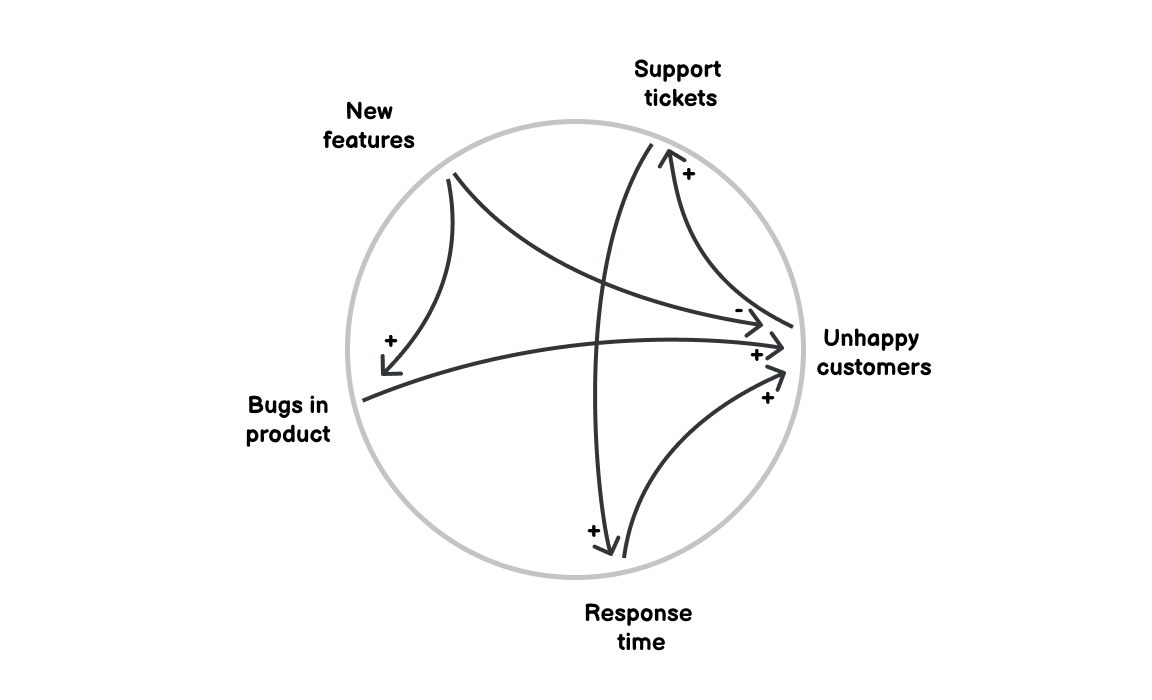
How to create a connection circle (如何创建一个 Connection Circle)
- Start with a circle on a piece of paper. (开始在一张空白的纸上画一个圆)
- Next, identify the key elements of the system you're examining.(下面确认你所在系统的关键因素)
- How do you know what's a key element? It meets these criteria:(你是如何确认他是关键因素呢?这些需要符合什么标准呢?)
- It's important to changes in the system (关键因素它的变化对于系统来说是非常重要的)
- Increases or decreases in the system (系统中的增加或者减少)
- Can be described by a noun (关键因素可以用一个名词描述的)
- How do you know what's a key element? It meets these criteria:(你是如何确认他是关键因素呢?这些需要符合什么标准呢?)
- Write these elements around the circle (don't include more than 10).(把这些关键因素写在环形四周,但是不要超过10个关键元素,这里包含10个关键元素)
- Look for cause and effect.(寻找关键元素的因果关系)
- Which elements are directly causing other elements to increase or decrease? (哪个关键元素直接导致其他元素的增加活着减少呢?)
- Draw an arrow between these elements. (在这些关键元素间用箭头链接)
- Indicate an increase (draw a "+") or a decrease (draw a "–") for the second element in each relationship.(指出每个关系中第二个元素的增加(画一个 "+")或减少(画一个"-"))
- Find all of the cause-and-effect relationships. These can be based on data or they can be a hypothesis.(找到所有的因果关系。这些可以是基于数据的,也可以是一个假设。)
- Look for elements whose relationships form closed loops. These are feedback loops. (寻找那些关系形成闭环的元素。这些是反馈环路。)
Example(例子)
It's best to illustrate with an example.
(这个模型最好用一个例子来说明)
Let's say our product has been dealing with unhappy customers.
(比如说:我的产品和那些满意度不高的顾客们之间需要处理的关系)
We know they've been complaining about too many bugs
(我们知道客户一直在抱怨产品存在太多的 Bug)
in the product and slow response times from our support (as customers create more support tickets).
(以及我的产品售后支持响应速度不迅速,导致客户提交了许多支持工单)
At the same time, we've been shipping more features to make them happier.
(同一时间,我们一直在增加更多的新的产品特性维持客户的满意度)
Let's use make a connection circle so that we can make sense of this.
(让我们画一个 Connection circle,这样我们就可以大致理解这个复杂系统下的主要特征了)
From this story, we can identify the key elements: unhappy customers,
(通过这个故事,我们可以确认的关键元素有:满意度不高的客户)
bugs in the product, response times, support tickets and new features.
(产品重的 BUG,问题反馈响应时间,支持工单 和 产品新特性)
We'll document them around our connection circle:
(我们讲这些关键元素在 Connection circle 上记录下来)
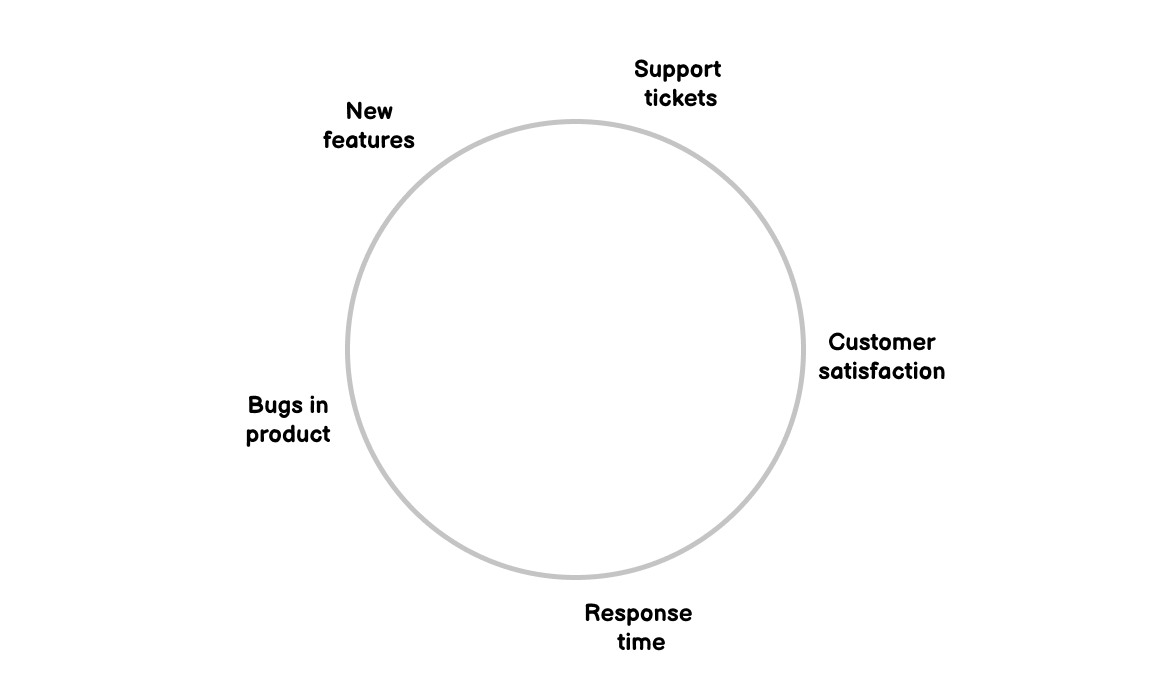
Now we need to document the relationships between them.
(现在我们需要记录关键元素之间的关系)
For example, we know that unhappy customers create more support tickets.
(比如,我们知道 不满意的客户创建了更多的支持工单)
More tickets means longer response time which in turn produces even more unhappy customers.
(更多的工单意味着会增加了售后支持的响应时间,反之因为售后支持的响应时间漫长,产生了更多的不满意的客户。ps:这是一个恶性循环)
We try to ship new features which lower the number of unhappy customers.
(我们试图通过增加新的产品特性来降低不满意客户的数量)
But they also produce more bugs and those lead to more unhappy customers again.
(但是新的产品特性会带来一些 新 Bugs 出现,这让对产品不满意的客户再次增加)
Let's map these relationships to the connection circle:
(让我们把这些关系映射到这个 Connection Circle中:)

The connection circle is now nicely showing
(现在这个 Connection circle 循环已经很好的展示出来)
the key elements of the system and the relationships between them.
(这个系统的关键因素以及他们之间的关系了)
There's even one feedback loop that we can see here:
(我们可以看到这里甚至有一个 FeedBack loop 在这里 )
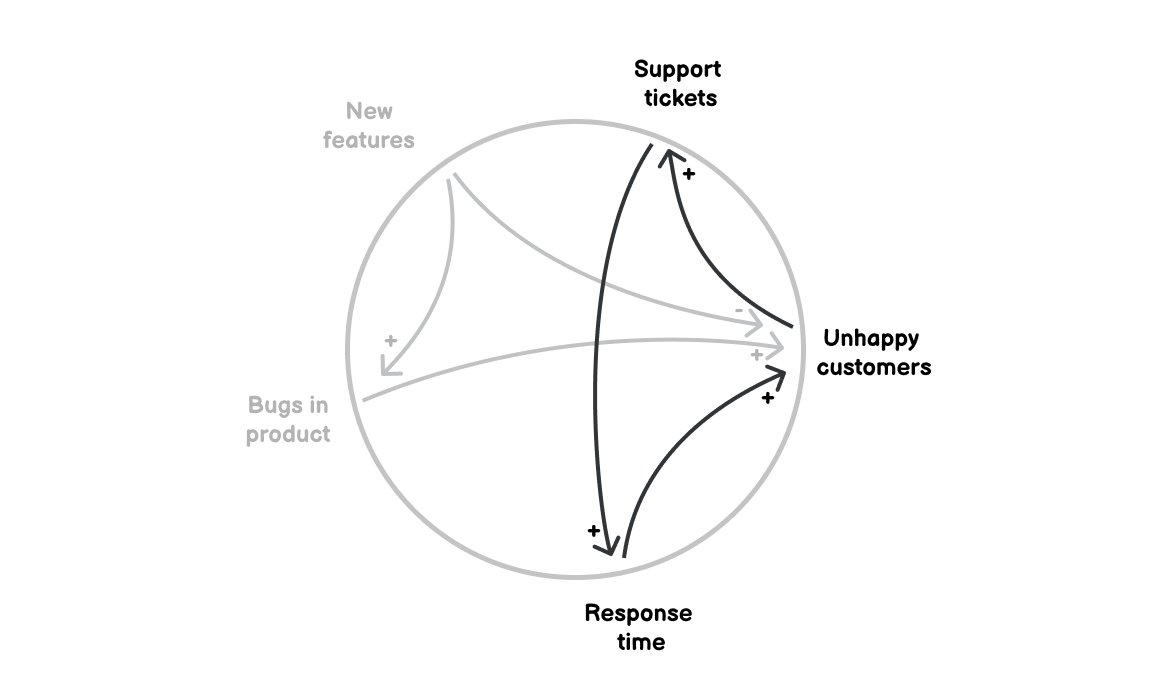
The completed connection circle and an identified feedback loop make you better understand the system.
(一个完整的 Connection circle 和 一个确定的 feedback loop 会让你更好的理解当前的系统环境 )
This understanding will greatly help you make changes that you need.
(这种理解将极大地帮助你做出你需要的改变。 )
Takeaway(要点)
Connection circles is a great tool for understanding systems.
(Connection circles 对于理解系统来说是一个非常好的工具)
It's about identifying key elements and mapping the relationships between them.
(这是关于确定关键因素和对他们之间的关系进行映射)
This tool can help you identify feedback loops as well.
(这个工具可以帮助你更好的确认 feedback loop(反馈循环))
(ps:才处理关系得时候也可以用,比如情侣之间的吵架)
Iceberg Model 冰山模型
Uncover root causes of events by looking at hidden levels of abstractions.
目的:(通过观察隐藏的抽象层次来揭示事件的根本原因。)
Addressing problems only on their event level is often not enough.
(只针对事件本身解决问题往往是不足够的)
The real causes are often hidden from plain sight.
(事件的真相往往隐藏在人们的视线之外。)
Iceberg model is a tool that allows you to shift your perspective
(Iceberg Model 模型工具可以帮助你转换观察视角)
and see beyond the immediate events that everyone notices.
(并且透过事件看到众人们没有注意到的事情。机器翻译)
It helps you to uncover root causes of why those events happen.
(它帮助你发现这些事件发生的根本原因。 )
That's possible by looking at deeper levels of abstraction within the system that are not immediately obvious.
(这可以通过观察系统内不太明显的更深层次的抽象而实现。机器翻译)
How to use it (如何使用它)
Iceberg model consists of four levels:(冰山模型由四个层次组成:)
- Events(事件)
- Patterns(模式)
- Structures (结构)
- Mental models (心理模型 心智模型是否更好?)
(图片模型需要翻译)
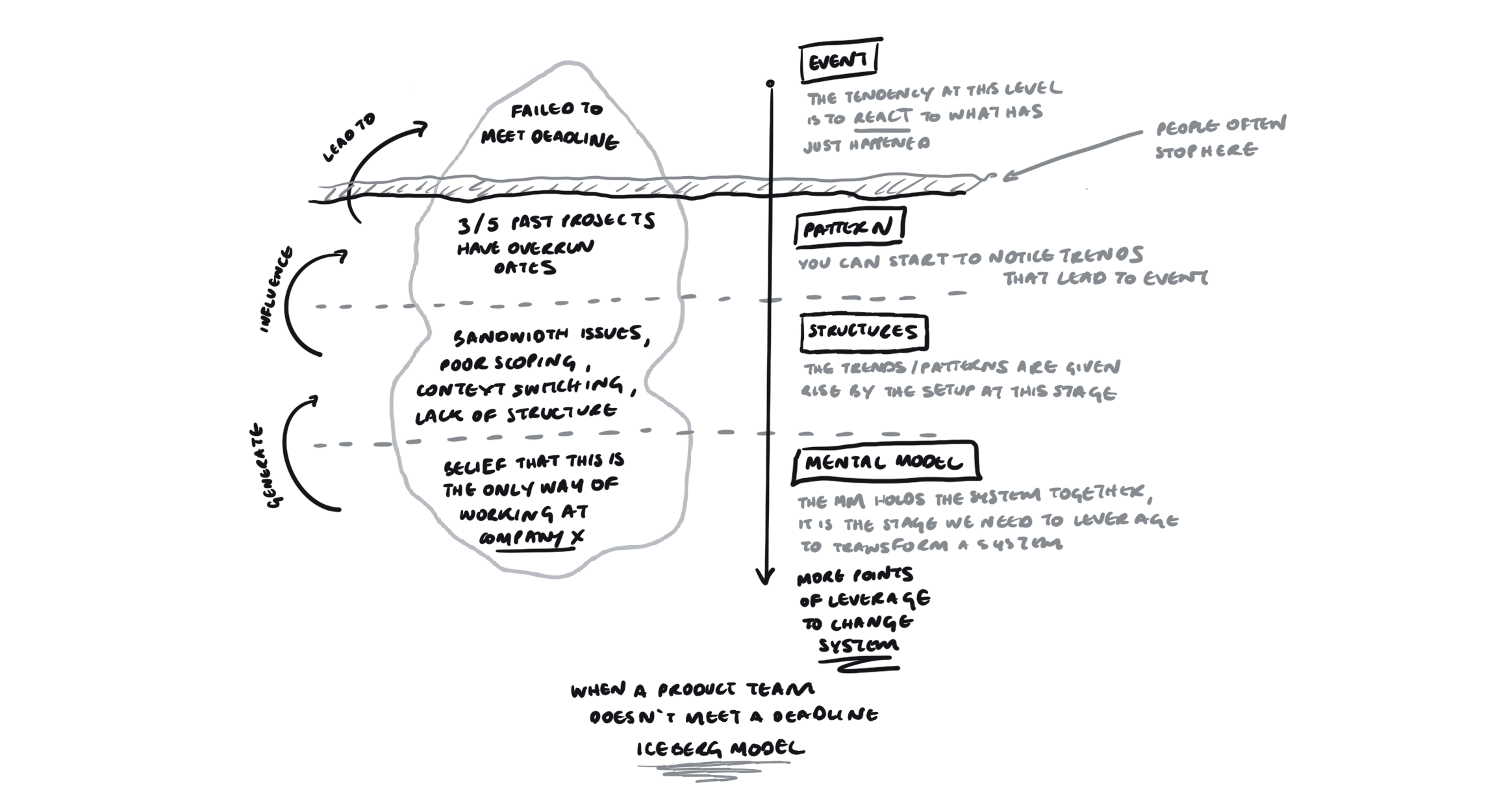
Looking below individual events,
(在单个事件下)
you can see trends over time—patterns.
(你可以看到时间模式下的事件趋势)
They are the clue for understanding the system structures that are behind those patterns.
(它们是理解这些模式背后的系统结构的线索。)
Structures are the relationships and feedback loops inside a system.
(结构是一个系统内部的 关系 与 反馈回路 。机器翻译)
These structures are in turn based on the underlying mental models of people.
(这些结构又是基于人们的基本心智模式。)
Events and patterns show you what is happening.
(事件和模式会告诉你什么事情可能会发生)
Structures and mental models tell you why it's happening.
(结构和心智模型会告诉你这件事为什么会发生)
The deeper you can go in the iceberg, the more leverage you'll have.
(你能在冰山上走的越深,将会有更多的判断条件)
Investigate all four levels (调查所有四个层面)
Here are some questions to help you understand each level within a certain problem or situation.
(这里有一些问题可以帮助你了解某个问题或情况下的每个层次。)
- Events:(事件)
- What is happening right now?(现在正在发生什么?)
- Patterns:(模式)
- What has been happening over time? What are the trends?(随着时间的推移,已经发生了什么事件?事件的趋势是什么?)
- Structures:(结构)
- What's influencing these patterns?(是什么在影响这些模式)
- Where are the connections between patterns?(模式之间有什么联系?)
- Mental models:(心智模型)
- What values, beliefs or assumptions shape the system? (哪些价值观,信仰或假设形成了这个系统)
It's important to note that answering these questions
(值得注意的是回答这些问题)
will likely require some research and digging.
(将可能需要一些研究和挖掘)
Especially when it comes to the mental models which are hard to document,let alone see in plain sight.
( 特别是当涉及到心理模型时,这些模型很难被记录下来,更不用说在明处看到了。)
Example of the Iceberg model by Justin Farrugia
Example (举个栗子)
Let's look at a real-world example to better understand how the iceberg model works.
(让我们看看一个真实的例子,以更好地理解冰山模型的工作原理。)
Suppose there are a couple of bugs in the feature your product team just released.
(假设你的产品团队刚刚发布的功能中有几个bug。)
That's a single event. Your instinct might be to react to it and start fixing them.
(这是一个单一的事件。你的本能可能是对它做出反应并开始修复它们。)
That's obviously not enough if you want to prevent it from happening in the future.
(如果你想防止它在未来发生,这显然是不够的。)
If you look back in time, you see that every released feature comes with several bugs.
(如果你回顾一下时间,你会发现每一个发布的功能都会伴随着几个bug。)
That's a pattern. Digging deeper, you find that teams don't plan for testing before releasing a feature.
(这是一种模式。深入挖掘,你会发现团队在发布一个功能之前并没有计划进行测试。)
The QA only happens after a release. Teams also typically have tight deadlines to ship a feature.
(QA质量管理只发生在发布之后。团队通常也有很紧的最后期限来发布一个功能。翻译不佳)
These are structures of the system.
(这些都是系统的结构。)
Investigating further, you discover that teams value shipping on time over the quality of their work.
(进一步调查后,你发现团队对能够准时发布的重视程度超过了他们对工作质量的把握。)
The tight deadlines are imposed by managers and teams believe it's not their place to push back.
(紧迫的最后期限是由管理人员规定的并且团队认为这不是他们的职责所在。)
As you can see, by looking beyond immediate events,
(如你所见,透过眼前的事件)
you are able to find a root cause of a problem.
(你能够找到问题的根本原因)
You now have much more leverage for solving the problem.
(你现在有更多的分析条件去解决这个问题)
Balancing feedback loop 平衡反馈回路
Mechanism that pushes back against a change to create stability.
(对变化进行反推以创造稳定的机制。Connection circles)
Balancing feedback loop is a mechanism that resists further changes in one direction.
(平衡反馈回路是一种机制,它抵制在一个方向上的进一步变化。)
It counters change in one direction with a change in the opposite direction.
(它以反方向的变化来对抗一个方向的变化。)
It seeks to stabilize a system.
(他试图稳定一个系统)
Often in systems, you will find this balancing loop together with the reinforcing feedback loop,
(通常在系统中,你会发现这种平衡回路与强化反馈回路 一起出现。 )
which does the opposite and creates exponential changes.
(后者的作用正好相反,会产生指数性的变化。)
How balancing loops work (平衡回路的工作原理)
Balancing feedback loops have three important components:(平衡反馈回路有以下三个部分组成)
- the goal or desired level (目标或者预期水平)
- the actual level (实际水平)
- the gap between those two (两个水平之间的差距)
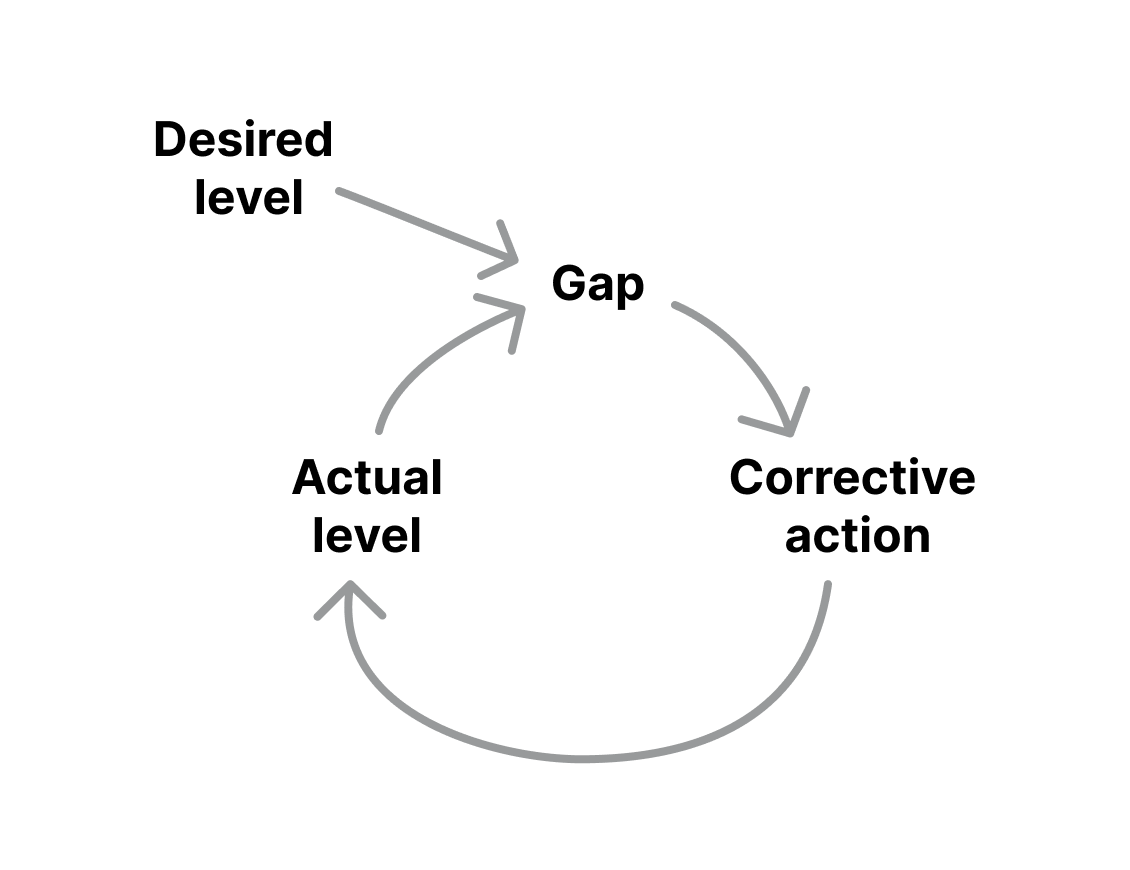
When the balancing loop sees a gap,
(当在平衡回路中发现一个缺口时)
it will trigger corrective actions to bring the actual level of something closer to the desired level.
(它将触发纠正措施,使实际水平接近预期水平)
The key to understanding a specific balancing loop is finding out its goal.
(了解一个具体的平衡回路的关键在于找出它的目标)
That may not always explicit or immediately visible.
(这可能并不总是很明确或者能够立刻发现它)
Example
The thermostat is a very practical example of a balancing feedback loop.
(温控器是一个非常实用的平衡反馈回路的例子。)
It monitors the temperature in a room (the actual level) and
(它监测房间里的温度(实际水平),)
when it goes below or above a certain threshold (the desired level),
(当它低于或高于某个阈值(期望水平)时,)
it will start to heat or cool the room to keep the temperature within the thresholds.
(它将开始加热或冷却房间,以保持温度在阈值之内。)
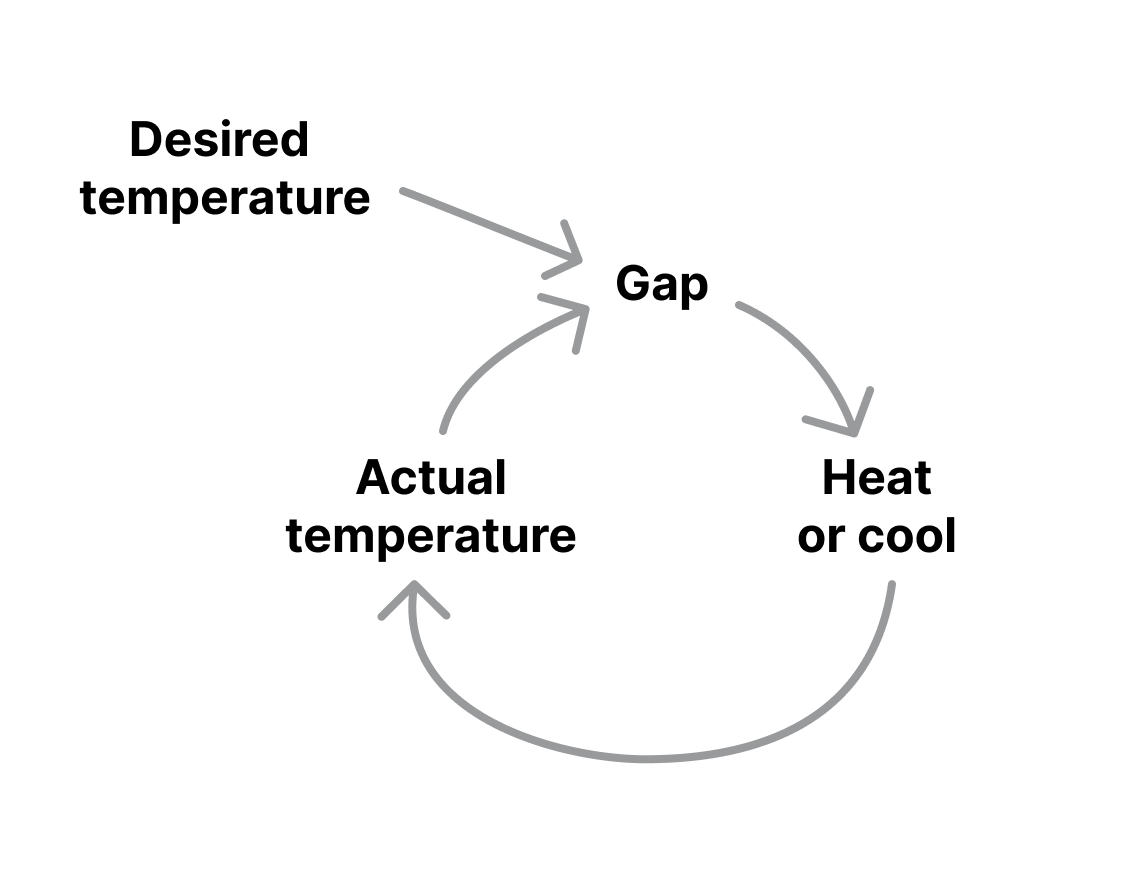
In this case, the whole loop is intentional and the corrective action is designed.
(在这种情况下,整个循环是有意为之,并设计了纠正行动。 )
You will also find many natural balancing loops.
(你还会发现许多自然的平衡循环。 )
Take the cooling of tea for example.
(以茶的冷却为例。 )
When you make tea and leave it be,
(当你泡茶并让它静止时。 )
it will gradually cool down from its initially high temperature (the actual level) until it reaches the room temperature (the desired level).
(它将逐渐从最初的 高的温度(实际水平),直到它达到室温(理想水平)。 )
In this case, the corrective action would be the heat transfer
(在这种情况下,纠正措施将是茶叶和周围空气之间的热传递。 )
between the tea and the air around.
(这杯茶 和 周围空气之间的热量转移。 )
This will happen naturally, there's no intention behind it.
(这将自然而然的发生,背后没有任何意图。)
Takeaway
Balancing feedback loops seek to stabilize systems.
(平衡反馈回路需求稳定系统。)
They trigger corrective actions to reach a certain goal – they're self-correcting.
(它们触发纠正行动以达到某个目标--它们是自我纠正的。 )
They are the opposite of the reinforcing feedback loops, which produce exponential changes.
(它们与产生指数变化的强化反馈环路相反。)
Sources
"Thinking in Systems: A Primer" by Donnella Meadows
"Visualizing the systems behind our designs" by Justin Farrugia
"Reinforcing and Balancing loops: Building blocks of dynamic systems" on Systems Thinker
"Balancing loops basics" on Systems Thinker
Reinforcing feedback loop 强化反馈循环
Understand the force behind exponential changes.
(了解指数型变化背后的力量。关联 Connection circles)
Reinforcing feedback loops are found whenever behaviours
(当循环内的行为或事件相互加强时,就会发现强化反馈循环。)
or events inside the loop reinforce one another.
(或者循环回路内的事件相互加强)
These loops amplify the effect of the process.
(这些回路放大了过程的影响)
That's a mouthful, but you can find real-world examples all around you.
(这是一个口述概念,但你可以在你周围找到现实世界的例子。)
The compound interest is a very common one. The more money you have in the bank,
(比如复利是很常见的一种强化反馈回路。你在银行存的钱越多,)
the more you earn on interest. That money is added to your balance and so you earn on interest even more.
(你赚的利息就越多。这些钱会加到你的余额中,所以你的利息收入就更多。)
Effects of reinforcing feedback loops are exponential, not linear.
(强化反馈回路的影响是指数级的,而不是线性的)
They lead to exponential increases or decreases,
(他会导致指数级的增长或者减少)
whereas balancing feedback loops lead to plateaus – their goal is stability.
(然而平衡反馈回路会导致 高原反应 这个翻译不准确- 他们的目标是稳定的)
Often, these two loops exist together within a system.
(通常, 这两个反馈回路在一个系统中同时存在)
How reinforcing feedback loops work (强化反馈回路是如何工作的呢?)
The basic characteristic of all feedback loops is that the output of one cycle is the input for the next cycle.
(所有的反馈回路的基本特征是,一个周期的输出是下一个周期的输出,{此处想到项目经理的的 输入 工具 数据 ITTO 图})
In the case of reinforcing loops, this input amplifies the next output.
(在强化回路的情况下,这个输入会放大下一个输出.)
Inside the loop, there are at least two variables. These variables reinforce each other.
(在反馈回路里面至少有两个变量,这些变量相互加强。)
However, there can be also external variables that influence the loop.
(然而,也可以有影响循环外的变量)
It's best to illustrate this with a simple example.
(最好用一个例子来说明这一点)
Example (举一个例子)
The compound interest is a very common example of a reinforcing feedback loop.
(投资复利是一个非常常见的强化反馈回路的例子)
The more money you have in a bank account, the more you earn on interest.
(你在银行账号中的钱越多,你的挣到的利息收入越多)
That money is added to your balance and so you earn on interest even more later on. The cycle repeats.
(这笔钱利息收入存入到你的余额中,所以你以后回赚更多的利息。循环往复。)
In this example, you have two variables inside the loop: the balance on the account and the interest earnings.
An external variable influences this loop – the interest rate.
(在这个例子中,在你的循环内存在两个变量:账户余额和利息收入。一个外部变量影响着这个循环--利率)。
This variable will influence the output of the feedback loop but doesn't change the core mechanism of the loop.
(这个变量将会影响反馈回路的输出,但不改变回路的核心机制)
Takeaway
Reinforcing feedback loop is a key tool for understanding systems because it's everywhere.
(强化反馈回路是一个理解系统的关键工具,因为他无处不在。)
It explains exponential changes.
(它解释了指数性质的变化)
In reality, systems are often made up of some combination of reinforcing feedback loops and balancing feedback loops,
(在现实中,系统往往是由强化反馈环路和平衡反馈环路的某种组合构成的,)
so it's useful to learn about both.
(因此,学习这两种环路是很有用的。)
Sources
"Thinking in Systems: A Primer" by Donnella Meadows
"Visualizing the systems behind our designs" by Justin Farrugia
"Feedback loops" by James Clear
"Reinforcing and Balancing loops: Building blocks of dynamic systems" on Systems Thinker

如何做决定
Cynefin framework Cynefin 框架
Make sense of different situations to choose an appropriate response.
(对不同的情况作出判断,以选择适当的反应。)
Different situations typically require different responses.
(不同的情况通常需要不同的反应。)
The Cynefin framework (pronounced /kəˈnɛvɪn/ - "kuh-nev-in") is there
(Cynefin框架(发音为/kəˈnɛvɪn/ - "kuh-nev-in")在这里)
to help you make sense of the situation in front of you
(是用来帮助你了解你面前的情况)
and make a decision that's appropriate for the type of situation you're dealing with.
(,并做出适合你所处理的情况类型的决定。)
It was developed by Dave Snowden in 1999.
(它是由戴夫-斯诺登在1999年开发的。)
How to use it
The framework identifies five domains to categorise problems or situations:
(这个框架确定了五个领域对问题或者情况进行分类)
clear, complicated, complex, chaotic and disorder.
(清晰的,事物,系统或过程的复杂,状态或处境,也用以描述人和生物的复杂,混乱的和无序的)
The idea is to identify which domain you're in and then choose the appropriate
(这个想法是要确定你处于哪个领域,然后根据其特点选择适当的行动。)
action based on its characteristics. So let's look at each domain in detail.
(基于其特点的行动。因此,让我们详细了解一下每个领域。)
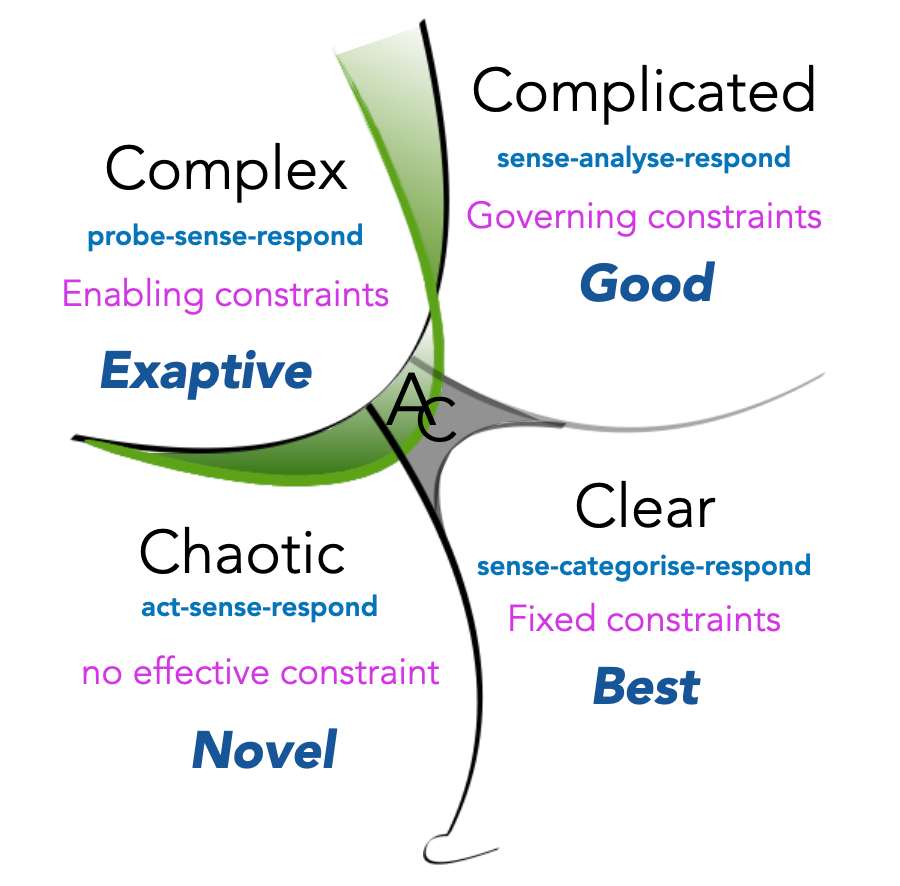
Clear (清晰领域)
Also known as obvious or simple, this is the domain of best practices.
(也可以理解成明显或者简单,这是最佳实践的领域)
This is where problems are familiar and clearly defined,
(这是对问题熟悉和明确的定义)
cause-and-effect relationships are clear and the situations are stable.
(因果关系是明确的,情况是稳定的)
Many process-oriented situations and problems would fall into this domain. It's a domain of "known knowns".
(许多面向过程的情况和问题都属于这个领域,这是一个"已知的已知"的领域)
Solutions are usually clear in these situations and don't require much expertise.
(在这些情况下,解决方案通常已经非常明显并不需要太多的专业知识)
The right approach would be sense–categorise–respond: understand the situation (sense),
(正确的方法应该是 感知-分类-回应:了解局势情况(感知))
categorize it, then respond by applying a best-practice solution.
(对其进行分类,然后通过应用最佳实践解决方案进行回应。)
Complicated (过程复杂领域)
In this domain, there might be multiple right answers but aren't immediately visible.
(在这个领域,可能存在多个正确答案,但是那些不是能够立刻发现的。)
It's a domain of "known unknowns" – when questions are clear but it takes work to answer them.
(这是一个 "已知未知数 "的领域--当问题很清楚,但要回答它们需要付出努力。 )
That's why the best approach is to sense-analyze-respond. Because analysis is needed,
(这就是为什么最好的方法是感知-分析-回应。因为需要分析。)
the situations here typically require expert knowledge. Experts should assess the situation,
(这里的情况通常需要专家知识。应该通过专家评估情况)
investigate possible options and choose a course of action.
(调查可能的选项并选择行动方案。)
Complex (事物状态复杂领域)
In this domain, there are "unknown unknowns". The situation cannot be understood by analysis
(在这个领域,存在着"未知的未知"。这种情况不能够通过分析来理解)
because we don't yet know enough about it. It's not clear what needs to be answered in the first place.
(因为我们没有对他有足够的了解,它不能够清楚首先需要了解的问题是什么。)
So the right approach is to experiment first, learn about the problem.
(所以正确的做法是首先做实验,学习了解具体的问题)
Then sense what you're dealing with and respond appropriately.
(然后感知你正在处理的问题并作出适当的反应)
The goal should be to understand enough so that the problem
(首要目标是足够了解问题的信息,从而使问题或者)
or situation moves to the complicated domain where it's easier to deal with.
(局势转移到更容易处理的过程复杂领域中去)
Chaotic 混乱
When things aren't under control, the situation falls into the chaotic domain.
(当事情不受控制时,局势就会落入混乱的领域中)
It's when cause and effect relationships are unclear.
(这是在当因果关系不明确的时候)
Here it's necessary to first act to establish some stability,to contain the situation.
(在这里有必要首先采取行动,建立一些局势的稳定性,以控制局势。)
Only then assess the situation and work on bringing enough order to it to move it into the complex domain. Act–sense–respond.
(然后再评估局势,努力为其带来足够的秩序,使其进入复杂领域。行动-感知-反应。)
The chaotic domain also presents an opportunity to try novel solutions
(混乱领域也提供了一个去尝试新的解决方案的机会)
as people might be more open to them in this context.
(因为在这种情况下,人们可能会对它们更加开放)
###Disorder 无序
If you don't know where you stand, you're in the disorder domain.
(如果你不知道你所处的领域,那么你现在处于无序领域)
The goal should be to quickly identify the right domain and move forward from there.
(当前目标应该是快速确定正确的领域,并向那个领域推进。)
It can be helpful to break down the problem or situation into multiple parts and assign each to a specific domain.
(将问题或情况分解成多个部分,并将每个部分分配给一个特定的领域,这可能会有帮助。)
###Determining which domain you're in 确定你所处的领域
It's best to get more familiar with each domain to learn
(最好对每个领域加以学习熟悉)
when characteristics of a problem/situation apply to a particular domain.
(当一个问题/情况的特征适用于一个特定的领域。)
The sources below are a good place to start.
(下面的来源是一个很好的开始。)
Here's a set of questions that can also help point you to the right domain:
(这里有一组问题,也可以帮助你指向正确的领域。)
- Do you know what causes the situation?
(你知道是什么原因导致了这种情况吗?) - Is the situation under control?
(情况是否得到控制?) - How much do you know about it?
(你对它了解多少?) - Does solving it require expert knowledge?
(解决这个问题是否需要专家知识?)
Takeaway
The key idea of the Cynefin framework is that different kinds of situations or problems require different kinds of responses.
(Cynefin 框架的关键思想是:不同种类的情况局势或问题需要不同种类的反应。)
You should identify what kind of a situation you're dealing with and—with the help of this framework—choose an appropriate response.
(你应该确认你正在处理什么样的情况或者局势,并在这个框架的帮助下选择一个适当的反应。)
Sources
"A Leader's Framework for Decisions Making" on Harvard Business Review
"Understanding the Cynefin framework" on Everyday Kanban
"Cynefin framework" on Wikipedia
"Cynefin framework template" on Miro
Six Thinking Hats 六顶思考的帽子
Look at a decision from different perspectives
(从不同的角度来看待一个决定)
Making the best decisions often requires looking at them through different lenses
(作出最好的决定往往需要通过不同的角度去看待他们,)
so that you don't overlook an important aspect.
(这样子你就不会忽视一些重要的方面)
Six Thinking Hats,created by Edward de Bono,
("六顶思考帽 是由爱德华-德-波诺创建的)
is a tool for doing exactly that.
(正是这样一种工具)
You can use it for your own thinking or in a group where everyone can represent a different perspective.
(你可以把它用于你自己的思考,或者在一个小组中,每个人都可以代表不同的观点。)
###How to use it
Each thinking hat represents one lens/perspective/style of thinking.
(每一顶帽子都代表一种思考的镜头/视角/风格)
Try "wearing" different hats and look at the decision through each.
(尝试带上不同的帽子,并透过他们去看待这个决定)
If you're in a group, you can assign the hats to everyone to get a balanced discussion.
(如果你是在一个小组里,你可以把帽子分给每个人,已获得均衡的讨论)
Or you can go through different perspectives as a whole group.
(或者你可以作为一个整体去看待不同的观点)
Here's what each hat is about:(以下是关于每个帽子思考的内容)
🟡 Yellow hat is about positivity. Try seeing the benefits of this decision and what opportunities it opens.
(🟡 黄帽子是关于积极性的。试着看到这个决定的好处,以及它所带来的机会。)
🟢 Green hat represents creativity. Let your mind run free and generate ideas without censoring them.
Try coming up with creative options and solutions.
Tools like the Productive Thinking Model or First Principles can help you.
(🟢 绿帽子代表创造力。让你的思想自由驰骋,产生想法而不加以审查。试着想出有创意的方案和解决办法。
生产性思维模式或第一原则等工具可以帮助你。)
🔴 Red hat is about emotions. How do you feel about this? Use your intuition and gut feelings.
Try to see how others might react emotionally. It's a great way to bring emotions into an otherwise rational process.
(🔴 红帽子是关于情感的。你对此有什么感觉?利用你的直觉和直觉。试着看看别人可能会有什么情绪上的反应。这是一个将情感带入其他理性过程的好方法。)
⚪️ White hat makes you focus on the data. Analyze the available data and trends. This represents a very rational approach.
(⚪️ 白帽子使你专注于数据。分析现有的数据和趋势。这代表了一种非常理性的方法。 )
⚫️ Black hat represents looking at the downside. What are the worst-case scenarios? Take a defensive approach,
imagine any potentially negative outcomes, see what might not work. Inversion might be a helpful tool here.
(⚫️ 黑帽代表着眼于负面的情况。最坏的情况是什么?采取防御性方法。想象任何潜在的负面结果,看看什么可能不奏效。在这里,反转可能是一个有用的工具。)
🔵 Blue hat is for controlling the process. Especially in meetings,
it's good to be able to step in when there's no progress and enable
the group to move forward (e.g. by shifting the thinking or discussion to a different hat/perspective).
(🔵 蓝帽子是用来控制过程的。特别是在会议上。特别是在会议中,能够在没有进展的时候介入并使进展的时候能够介入,使小组能够继续前进(例如,通过将思维或讨论转移到不同的帽子/角度)。)
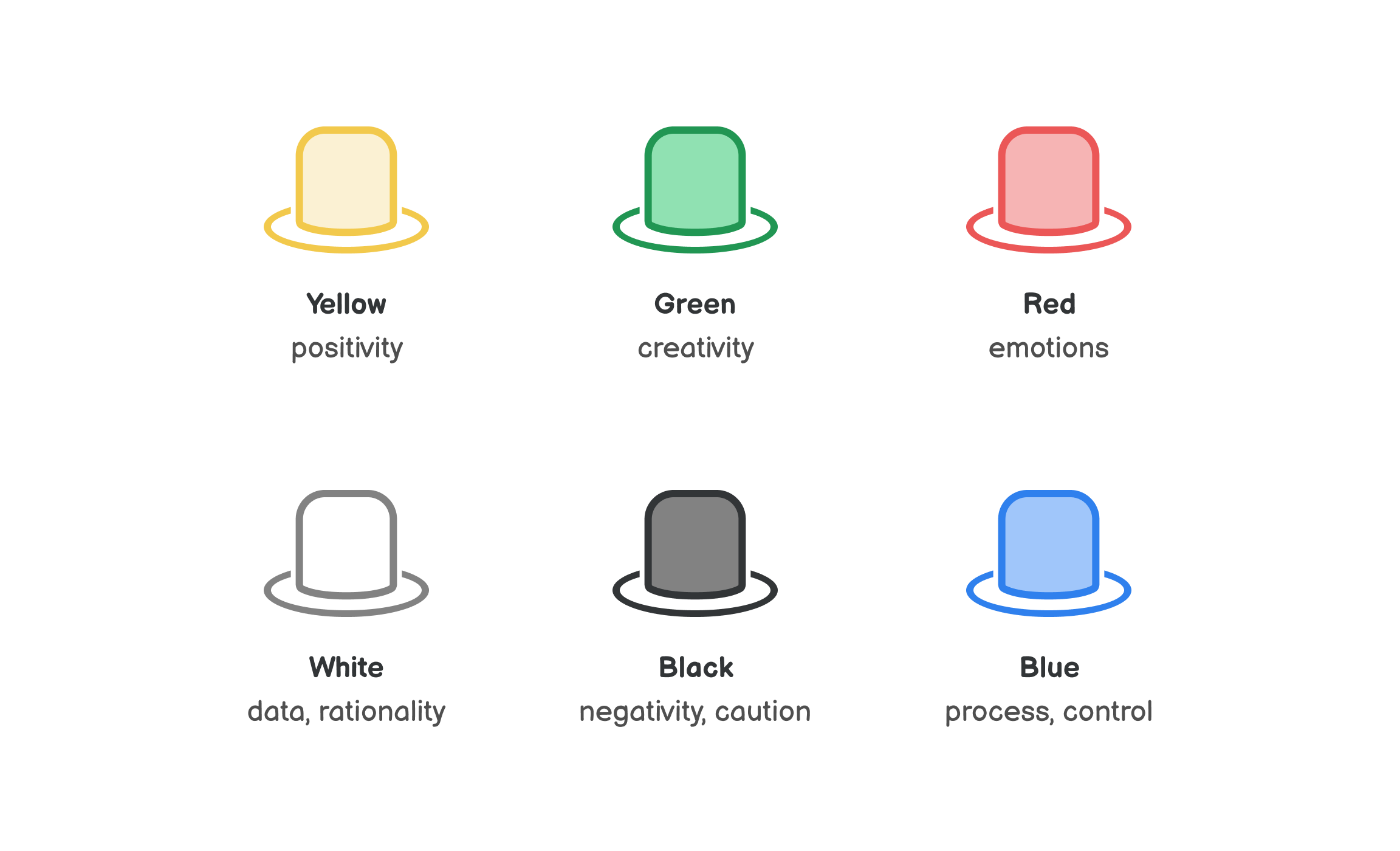
###Example (举个例子)
Let's see how using this tool might play out in an example scenario.
(让我们看看在例子中如何使用这个工具。)
Suppose you're in a management meeting to decide if you should introduce a new product to your portfolio to battle declining sales.
(假如你在一个管理会议上决定是否应该在你的产品组合中引入一个新产品,以应对不断下降的销售。)
You use the Six Thinking Hats tool to make sure the decision is considered from all possible angles.
(你使用 "六顶思考帽 "工具来确保从所有可能的角度考虑这个决定。)
Starting with the yellow hat, you discuss the sizable chunk of the market that this new product might cater to.
(从带上黄帽子(积极好的角度)开始,你讨论到这个新产品可能迎合的相当大的一块市场。)
It's a big opportunity for capturing a lot of revenue.
(这是一个获得巨大受益的好机会。)
You switch to the black hat to look at possible downsides:
(你切换成黑色的帽子(不好负面的角度)去研究可能产生的缺点或者负面不好的地方:)
what if the new product cannibalizes our existing products?
(如果新产品吞并了我们现有的产品怎么办?)
What if it doesn't offer enough value for people to buy it?
(如果他不能提供足够的吸引力价值让人们购买怎么办? 这里翻译欠缺)
A person wearing the white hat points out that the data you have about the market shows several unmet needs.
(一个带着白帽子的成员指出,你所掌握的关于市场的数据显示出几个未满足的需求。)
It also shows that the declining sales of the existing products signal a trend that the market as a whole is moving to different solutions.
(它还表明,现有产品的销量下降预示着整个市场正在向不同的解决方案发展的趋势。)
Wearing the yellow hat again, you see that the unmet needs in the market represent a solid opportunity and it's supported by data.
(再次带上黄色的帽子,你看到市场上未被满足的需求代表了一个坚实的机会,而且有数据上的支持。)
Considering the possible downsides,
(考虑到可能出现的负面问题,)
you ask: How might we make sure the new product offers enough value?
(你问:"我们如何确保新产品提供产生出足够的价值?" 这里翻译欠缺)
You put on the green hat and generate ideas for how you might prototype the new product and test its value with people.
(你戴上绿色的帽子,为你如何制作新产品的原型和向人们测试其价值产生想法。)
Because the meeting has been running for a while now,
(由于会议已经进行了一段时间,)
the facilitator wearing the blue hat suggests postponing the decision until the new product is validated with people.
(戴蓝帽子的主持人建议推迟决定,直到新产品得到人们的验证。)
The group decides to wear the red hat to do a check how everyone feels about this plan.
(小组决定戴上红帽子,检查一下大家对这个计划的看法。)
People agree that it's a high-stakes decision and it feels right to lower the risk before making the decision.
(大家一致认为这是一个高风险的决定,在做这个决定之前感觉降低风险是一个正确的选择。)
They're less anxious about it now.
(他们现在的焦虑少了一些)
In this example, the group arrived at a reasonable next step toward making this decision.
(在这个例子中,小组达成了一个合理的下一步决定。)
Using the Six Thinking Hats, every perspective was heard
(使用 "六顶思考帽",每个人的观点都被听到了,)
and the outcome was made possible by discussing the different perspectives.
(并且通过讨论不同的观点,使结果成为可能。)
###Key takeaway
Six Thinking Hats is a tool that allows you to consider a decision or problem from different angles.
(六顶思考帽是一种工具,让你从不同的角度考虑一个决定或问题)
It enables you to deliberately see aspects you might otherwise overlook,
(它使你能够有意识地看到你可能忽略的方面, )
making your decision better and more resilient in the end.
(使你的决定最终变得更好,更有弹性。)
If you want to find out more about the Six Thinking Hats,
(如果你想了解更多关于六顶思考帽的信息, )
Edward de Bono's book with the same title is the best place.
(爱德华-德波诺的同名书籍是最好的地方。)
Sources
"Six Thinking Hats" by Edward de Bono
Second-order thinking 二阶思维
Consider the long-term consequences of your decisions.
(考虑你的决定的长期后果。)
Some decisions seem like wins at first, but turn out to be losses over time.
(有些决定一开始看起来是赢得,但是随着时间的推移,却变成了损失.)
What seems like an investment now turns out to be a liability later.
(现在看起来是一项投资,后来却变成一种负担.)
What looked like a good decision earlier is now a bad one.
(先前看起来是个好的决定,现在看起来确是一个坏的决定)
Second-order thinking is a tool that will help you examine the long-term effects of your decisions.
(二阶思维是一种工具,它将帮助你检查你的决定的长期影响.)
Most people stop at first-order thinking. Second-order thinking is necessary to make decisions that will stand the test of time.
(大多数人止步于一阶思考.二阶思考对于做出经得起时间考验的决定是必要的.)
We need to make sure we're okay with more long-term consequences of our decisions today.
(我们需要确保我们能接受我们今天做的决定所带来的更多长期后果。)
###How to use it?
Using second-order thinking can be a purely mental exercise or you can write it down on paper.
(适用二阶思维可以是一种纯粹的心智练习,也可以把它写在纸上.)
Consider a decision you have to make. Start by looking at the most immediate effects of making this decision – the first order.
(考虑一下你必须做出的决定,首先看一下做出这个决定的最直接的影响--第一顺序)
Then for each of the effect ask yourself: "And then what?"
(然后对每个人影响问自己:"然后呢?")
That's how you examine the second order of this decision's consequences.
(这就是你检查这个决定的第二阶后果的方法.)
You can repeat this for as many orders as you find practical.
(你可以对你认为实用的多个顺序重复这样做.)
Alternatively, think about the decision in different timelines.
(或者,在不同的时间轴上思考这个决定)
Ask yourself: What will be the consequences of this decision in
(问问你自己:这个决定在 10 分钟,10 个月,10 年后会有什么后果? )
- 10 minutes?
- 10 months?
- 10 years?
This way you can think about the short-term, medium-term and long-term consequences of your decision.
(这样,你就可以思考你的决定的短期、中期和长期后果。)
You can apply second-order thinking on big decisions (e.g. buying a house),
(你可以将二阶思维运用到大的决定(比如买房子),)
but also small, seemingly mundane, decisions (e.g. eating a cake).
(也可以应用于小的,看起来很平凡的决定(比如吃蛋糕),)
It's a very universal tool that is relevant not just in personal life,
(这是一个非常普遍的工具,不仅仅适用于个人生活,)
but also in business or policy-making.
(也适用于商业或者政策指定.)
###Second-order thinking in practice
Let's explore what second-order thinking looks like in action.
(让我们探讨一下二阶思维在实际行动中的应用.)
Consider the decision of buying a house outside of the city.
(考虑一下在城外买房子这个决定.)
The immediate effects might be having a garden, more space for your family,
(直接影响可能是拥有一个花园,为家人提供更多的活动空间,)
but also suddenly living an hour away from work.
(但是也突然住在离工作一个小时的地方.)
Now look at higher-order consequences of each:
(现在看看每种情况的高阶后果。)
having a garden → able to grow your produce → having fresh herbs and vegetables
(有一个花园->能够种植自己的产物->有一些新鲜的草药和蔬菜)
more space for family → more rooms to clean → more stress from a messy home
(为家人提供更多的空间→有更多的房间要打扫→家里乱糟糟的压力更大 )
living an hour away from work → need to buy a car → spending two hours of each day in a car
(住在离工作地点一小时路程的地方→需要买车→每天花两个小时在车上)
Obviously, this is just a small subset of consequences for such a big decision,
(显然,这只是这样一个重大决定的一小部分后果,)
but it shows how second-order thinking can help you see the more long-term consequences.
(但它表明二阶思维可以帮助你看到更长期的后果。)
You can now make a more informed and thoughtful decision.
(你现在可以做出一个更明智、更周到的决定。)
![]()
###Source
"Second-order thinking" by Shane Parrish
"The Most Important Thing" by Howard Marks
Eisenhower Matrix 艾森豪威尔矩阵
Prioritize your actions and tasks by importance and urgency
(按照重要性和紧迫性对你的行动和任务进行优先排序 )
Named after U.S. President Dwight D. Eisenhower,
(以美国总统德怀特-D-艾森豪威尔的名字命名)
this prioritization framework will help you organize your tasks and activities by importance and urgency.
(这个优先级框架将帮助你按重要性和紧迫性组织你的任务和活动。)
It's especially useful when you're very busy but don't feel like what you do has much impact.
(当你很忙但又觉得你所做的事情没有特别大的影响时,它就特别有用。)
###How to use it?
The Eisenhower Matrix has four quadrants along two axes: importance and urgency.
(艾森豪威尔矩阵沿着两条轴有四个象限:重要性和紧迫性。)
For every activity or task, ask yourself: It is important or not? Is it urgent or not?
(对于每一项活动或任务,问自己:"它是重要的还是不重要的?它是紧急还是不紧急?")
Based on the answer, place the activity/task in the right quadrant. The quadrant determines what you should do with the task:
(根据上面的回答,将该活动/任务放在正确的象限内。该象限决定了你应该对该任务做什么。)
- Important and urgent → Do it
(重要并且紧急-> 去执行)
These are the tasks that you want to do as soon as possible.
(这些是你想要尽快完成的任务。)
Crises, pressing problems and other things where not acting now has negative consequences.
(危机、紧迫的问题和其他现在不采取行动就会产生负面影响的事情。) - Important but not urgent → Schedule it
(重要但是不紧急->计划安排他它)
Find a time for these tasks and do them then.
(规划好时间,然后去做这些任务)
This quadrant is typically where deep work happens – tasks that contribute to your projects or long-term goals.
(这个象限通常是发生深度工作的地方--有助于你的项目或长期目标的任务。) - Urgent but not important → Delegate it
(紧急但是不重要->交给别人去做)
If you can, find someone who can do these tasks for you.
(如果可以的话,找一个可以为你做这些工作的人。)
If you can't delegate it, schedule it but always try to do the important-but-not-urgent tasks first.
(如果你不能委派,那就安排一下,但总是尽量先做那些重要但不紧急的任务)
These are often administrative tasks or things that have deadlines but aren't critical.
(这些通常是行政任务或有最后期限但并不关键的事情。) - Not urgent and not important → Don't do it
(不紧急也不重要->不要去做)
These tasks aren't worth your time and you shouldn't do them at all.
(这些任务不值得你花时间,你根本就不应该做。)
Avoidance activities, busy work and entertainment goes into this quadrant.
(逃避的活动、忙碌的工作和娱乐都属于这个象限。)
This is also the order of the priority of your tasks. Yes, important-but-not-urgent tasks come before urgent-but-not-important.
(这也是你任务的优先顺序。是的,重要但不紧急的任务排在 紧急但不重要的任务之前。)
Eisenhower matrix is very flexible so it's up to you if you use it for professional tasks, personal ones or both.
(艾森豪威尔矩阵非常灵活,所以取决于你是否将其用于专业任务、个人任务或两者。)
You can also work with it on different timescales: planning your day vs. generally prioritizing activities in your life.
(你也可以在不同的时间尺度上使用它:计划你的一天与一般的生活活动的优先次序。)
How do you tell urgent tasks from important ones? (你如何区分紧急任务和重要任务?)
Urgent tasks typically have a clear deadline (e.g. sending a draft to a client) or require you to react in a timely fashion (e.g. emails).
(紧急任务通常有一个明确的截止日期(例如,向客户发送草稿)或要求你及时做出反应(例如,电子邮件)。)
Important tasks tend to be aligned with your long-term goals (e.g. exercising) and push your projects forward (e.g. writing code for your side project).
(重要任务往往与你的长期目标相一致(如锻炼身体),并推动你的项目向前发展(如为你的副业项目写代码)。)
Determining urgency and importance will always depend on your context and your ability to recognize what's truly urgent and truly important.
(确定 紧迫性 和 重要性 将始终取决于你的背景和你识别什么是真正的紧迫性和真正的重要性的能力。)
Example
Here are some examples of activities and tasks that might go into the Eisenhower Matrix:
(下面是一些可能进入艾森豪威尔矩阵的活动和任务的例子。 )
| Urgent(紧急) | Not urgent(不紧急) | |
|---|---|---|
| Important(重要) | Do:Finish a report that's due Send draft to client Fix a bug (做到:完成一份到期的报告 把草稿发给客户 修复一个错误) | Schedule:Design a new feature Write a blog post Exercise (计划:设计一个新功能 写一篇博文 练习) |
| Not important(不重要) | Delegate/schedule for later: Buy a conference ticket Schedule an interview Reply to emails (委托/安排以后的工作 购买会议门票 安排采访 回复邮件) | Don't do:Attend a meeting with no agenda Read #random Check social media (不要做:参加没有议程的会议 阅读#随机查看社交媒体) |
![]()
Takeaway
The promise of the Eisenhower Matrix is to make you more productive by setting the right priorities and acting on them.
(艾森豪威尔矩阵的承诺是,通过设定正确的优先事项并付诸行动,使你的工作效率更高)
If you're always busy but don't get anywhere on your long-term projects and goals,
(如果你总是很忙,但在你的长期项目和目标上没有任何进展,)
this tool is definitely for you. But it's also a generally useful tool for deciding what to work on
(这个工具绝对适合你.但它也是一个普遍有用的工具,可用于决定哪些事情要做,)
and what to eliminate from your life.
(并且哪些事情要从你的生活中消除。)
Sources
"How to be More Productive and Eliminate Time Wasting Activities by
Using the “Eisenhower Box” " by James Clear
"The Eisenhower Matrix" on Todoist
Ladder of inference 推理的阶梯
Avoid jumping to conclusions. Make decisions based on reality.
(避免急于下结论。根据现实做出决定)
We act and make decisions based on the conclusions we make.
(我们根据自己的结论采取行动并做出决定。)
But we tend to jump to these conclusions and skip important parts of the reasoning process.
(但我们倾向于跳到这些结论,并跳过推理过程中的重要部分。)
Ladder of inference, developed by a former Harvard professor Chris Argyris,
(推理阶梯,由前哈佛大学教授Chris Argyris开发的 )
is a tool that helps you fill the gaps in your thinking and make decisions based on reality.
(是一个帮助你填补思维空白并根据现实做出决定的工具。)
It's also helpful to challenge the thinking of others and reach better conclusions together.
(它也有助于挑战他人的思维,共同达成更好的结论。)
The ladder (梯子)
There are 7 steps on the ladder that represent our mental processes. Here's what it looks like from the bottom up:
(梯子上有7个台阶,代表我们的心理过程。下面是它从下往上看的情况。)
Available data (可用数据)
This is the reality we are able to observe.
(这就是我们所能观察到的现实。)
Selected data (选择数据)
We select what we pay attention to based on our prior experiences and existing beliefs.
(我们根据以前的经验和现有的信念来选择我们关注的内容。)
We don't have the mental capacity to take in every piece of data available, so we have to make this selection.
(我们没有足够的心智能力来接受每一个可用的数据,所以我们必须做出这种选择。 )
Interpretations (解释)
We give facts meaning. We paraphrase what we see or hear to make sense of it.
(我们赋予事实以意义。我们对看到或听到的东西进行转述,使其具有意义。)
Assumptions (假设/推测)
Based on our interpretation, we make our own personal assumptions.
(基于我们的解释,我们做出了自己的个人假设。)
Conclusions (结论)
We draw conclusions from our assumptions.
(我们从我们的假设中得出结论。)
Beliefs (信念)
Our beliefs are then developed from the conclusions we make.
(我们的信念就是从我们的结论中发展出来的。)
Actions (行动)
Finally, we take actions that are rooted in what we believe to be true.
(最后,我们采取植根于我们所相信的真实的行动。 )
These processes usually happen unconsciously and very quickly in our brain.
(这些过程通常在我们的大脑中无意识地、非常迅速地发生。)
Applying this ladder consciously allows you to take a step back and see where you're jumping to conclusions.
(有意识地应用这个阶梯,可以让你退后一步,看看你在哪里下了结论。)
How to use it? (如何使用它)
Whenever you make a conclusion about something or are making decisions based on your conclusions,
(每当你对某件事情作出结论,或根据你的结论作出决定时,)
it's good to stop and question your reasoning.
(最好停下来质疑你的推理。)
![]()
First, identify on which step of the ladder you currently are. Are you about to take action and
(首先,确定你目前处于阶梯的哪一步,你是否准备采取行动)
you're not sure if it's the right one? Or perhaps you're aware of some of the assumptions you're making?
(,但你不确定这是否正确? 或者是你意识到了你所做的一些假设?)
Then work your way down before building your reasoning up again.
(那么,在再次建立你的推理之前,你要先向下努力。)
To work your way down the ladder, use these guiding questions for each step:
(要沿着梯子往下走,每一步都要使用这些指导性问题。)
-
Actions:(行动)
- Why do I believe this to be the right action? What are some alternative options?
(为什么我认为这是一个正确的行动?有哪些其他选择?)
- Why do I believe this to be the right action? What are some alternative options?
-
Beliefs:(信念)
- What beliefs do I hold about this? What conclusions are they based on?
(我对此持有什么信念?它们是基于什么结论?)
- What beliefs do I hold about this? What conclusions are they based on?
-
Conclusions:(结论)
- Why did I conclude this? What are my assumptions there?
(我为什么会得出这样的结论?我在那里的假设是什么?)
- Why did I conclude this? What are my assumptions there?
-
Assumptions:(假设/推测)
- Are my assumptions valid? Why am I assuming this?
(我的假设有效吗?我为什么要这样假设?)
- Are my assumptions valid? Why am I assuming this?
-
Interpretations:(解释)
- Am I looking at this data objectively? What other meanings could they have?
(我是在客观地看待这些数据吗?它们还能有什么其他含义?)
- Am I looking at this data objectively? What other meanings could they have?
-
Selected data:(选择数据)
- What did I ignore or didn't pay attention to? Are there other sources of data I didn't consider?
(我忽略了什么或没有注意到什么?是否有其他我没有考虑的数据来源? )
As you answer these, you may find that your reasoning changes along the way and that's good.
(当你回答这些问题时,你可能会发现你的推论方式在一路上发生了变化,这很好。)
When you reach the bottom of the ladder,
(当你触及到阶梯的底部时)
work your way back up again, this time more consciously and deliberately.
(再往上走,这一次要更有意识地、刻意地走。翻译欠佳) - What did I ignore or didn't pay attention to? Are there other sources of data I didn't consider?
Example
Let's see how applying the ladder of inference looks like on a practical example.
(让我们看看在一个实际的例子中如何应用推理的阶梯。)
Suppose I'm managing a team of developers. One of them hasn't been performing well recently.
(假设我正在管理一个由开发人员组成的团队,其中一个人最近表现不佳。)
He's been missing deadlines and several projects were delayed because of this.
(他一直在错过最后期限,有几个项目因此被推迟了。)
I conclude he's not cut out for the job and decide to fire him.
(我断定他不适合这份工作,决定解雇他。)
However, I stop and ask myself: Is this the right thing to do?
(然而,我停下来问自己。这样做对吗?)
I can now apply the ladder of inference to unpack my thinking and perhaps make a better decision.
(我现在可以运用推理的阶梯来解读我的想法,或许能做出更好的决定。)
I ask myself the guiding questions:
(我问自己一些指导性的问题。)
Why do I believe that firing this person is the right action?
(为什么我相信解雇他是一个正确的决定)
Because it's clear to me he's not right for the job.
(因为在我看来太显然不太适合这份工作)
What conclusions is this belief based on? That he's not a good developer.
(我的这种想法基于什么结论?他不是一个好的开发者)
What are my assumptions here? I assumed that his recent results are representative of his qualities (or lack thereof).
(我在这里的推测依据是什么? 我假设他最近的工作绩效能代表他的品质(或缺乏品质 翻译欠佳)。)
Why am I assuming this? Because missed deadlines mean he's not efficient.
(我为什么要这样假设推测呢?因为错过最后期限意味着他没有效率。)
What other meanings could the data I'm looking at have? Missed deadlines might
(我所看的数据还能有什么其他含义?错过最后期限)
also mean the deadlines are unreasonable or he's taking extra time to deliver quality code.
(也可能意味着最后期限是不合理的或者他需要额外的时间来交付高质量的代码。)
Are there other sources of data I didn't consider? I haven't asked him directly yet.
(是否还有其他我没有考虑到的信息数据来源?我还没有直接问他。)
When I do, I might find out the real reason he's been missing deadlines.
(当我这样做时,我可能会发现他错过最后期限的真正原因。)
This is a simplified example but it shows the kind of jumping to conclusions I want to avoid:
(这是一个简化的例子,但是它给我们展示了我想避免的那种跳跃性结论)
missed deadlines → inefficient → not a good developer → should be fired.
(错过最后期限->效率低下->不是一个好的开发者->应该被解雇.)
By unpacking my thinking, I can look at the situation more objectively
(通过解读我的想法,我可以更客观地看待这种情况,)
and I may discover different reasons for what's happening:
(并且我可能发现发生这种情况的不同原因:)
perhaps the deadlines are too tight or he's going through some personal issues.
(也许最后期限太紧,或者他正在经历一些个人问题。)
Neither of which should be a reason to fire him.
(这两种情况都不应该成为解雇他的理由)
The ladder of influence has just helped me avoid making a bad and premature decision.
(推理阶梯的影响力只是帮助我避免做出一个错误的、不成熟的决定。)
Sources
"The Fifth Discipline: The Art & Practice of The Learning Organization" by Peter Senge
["Rethinking thinking" by Trevor Maber]()
"The Ladder of Inference" on Systems Thinker
Decision matrix 决策矩阵
Choose the best option by considering multiple factors.
(通过考虑多种因素选择最佳方案)
Some decisions can be tough to make.
(有些决定可能很难做出)
Especially when there are more factors that go into making them.
(特别是当有更多的因素影响到它们时。)
Decision matrix is a tool that will help you consider all the important factors when making a decision.
(决策矩阵这个工具,可以帮助你在做决定时考虑所有重要因素)
It brings more clarity into the process.
(它为这个过程带来了更多的清晰性。)
It is most useful when you have several options and you need to decide between them based on a number of different factors.
(当你有几个选择,而你需要根据一些不同的因素在它们之间做出决定时,它是最有用的。)
###How to use it?
Decision matrix is basically a simple table with your options and factors for deciding.
(决策矩阵基本上是一个简单的表格,上面有你的选项和决定的因素。)
The goal is to calculate a score for each option based on their factor scores.
(其目的是根据每个选项的因素得分计算出一个分数。)
The score will help you make your decision.
(这个分数将帮助你做出决定。)
Here's how to create a decision matrix step by step: (下面是如何一步一步地创建决策矩阵。)
- Write down the decision you need to make
(写下你需要做出的决定) - List the options you have
(列出你拥有的选项) - Identify factors that you want to consider
(确定你要考虑的因素) - Score the options on each factor
(在每个因素上给选项打分) - Add weight to the factors
(给各因素增加权重) - Calculate the options' scores – multiply each score by the factor weight, then add them up.
(计算选项的分数--将每个分数乘以因素权重,然后相加。) - Pick your winner – option with the highest score
(挑选你的赢家--得分最高的选项)
Let's see how this works in practice.
(让我们看看这在实践中是如何运作的。)
###Practical example (实践例子)
Suppose you're leading a design team and you want to decide
(假设你正在领导一个设计团队,)
which design tool you want to use as a team.
(你想决定在团队中使用哪种设计工具。)
You've done some research and you narrowed down your options to three:
(你做了一些研究,把选择范围缩小到了三个)
Sketch, Figma and Framer. Let's put them in your decision matrix table.
(Sketch, Figma 和 Framer。让我们把它们放在你的决策矩阵表中。)
| Factors(决定因素) | TBD | TBD | TBD | Score(分数) |
|---|---|---|---|---|
| Weights | ||||
| Sketch | ||||
| Figma | ||||
| Framer | ||||
| Now let's look at the factors you need to consider. | ||||
| (现在让我们来看看你需要考虑的因素。) | ||||
| You have a set budget for tools so cost will be the first factor. | ||||
| (你有一个固定的工具预算,所以成本将是第一个因素。) | ||||
| After discussing with your team, you agree that prototyping | ||||
| (在与你的团队讨论后,你同意一个工具的原型设计) | ||||
| and collaboration capabilities of a tool are most important for them. | ||||
| (和协作能力对他们来说是最重要的。) | ||||
| Now you have the factors that will influence the decision. | ||||
| (现在你有了影响决定的因素。) |
| Factors(决定因素) | Cost(成本) | Prototyping(原型设计) | Collaboration(协作) | Score(分数) |
|---|---|---|---|---|
| Weights () | ||||
| Sketch | ||||
| Figma | ||||
| Framer |
It's time to score each option on every factor.
(现在是时候对每个选项的每个因素进行评分了。)
Let's use a scale of 1 to 5 (where 1 is the worst, 5 is the best),
(让我们用1到5的比例(其中 1 是最差的,5 是最好的),)
but you can use any scale you like.
(但你可以使用任何你喜欢的比例。)
Cost – You find out that Figma and Framer both cost $12/editor/month,
(成本-你发现 Figma 和 Framer 都是 12 美元每个月)
while Sketch is a little cheaper at $9. You'll score them 3 and 4 respectively.
(然而 Sketch 便宜一些 9 美元每个月。你会给他们分别打 3 分和 4 分。)
Prototyping – Framer comes out as the most powerful in prototyping.
(原型设计-Framer 在原型设计中是功能最强大的)
Figma and Sketch are somewhat similar, but Figma can do a little more.
(Figma 和 Sketch 有点相似,但是 Figma 可以做的更多一些)
Framer gets a 5, Figma a 3 and Sketch a 2.
(Framer 得 5分,Figma 为 3 分 并且 Sketch 得 2 分)
Collaboration – You let your team evaluate this one.
(协作-你让你的团队来评估这个问题。)
They agree that Figma is the best for collaboration,
(他们一致认为 Figma 是最适合协作的。 )
scoring it with 5. Sketch and Framer both get a 3.
(Figma 协作分数 5 分。Sketch 和 Framer 分别为 3 分)
Let's see how these look like in your decision matrix: (让我们看看这些分数在你的决策矩阵中是什么样子的。)
| Factors(决定因素) | Cost(成本) | Prototyping(原型设计) | Collaboration(协作) | Score(分数) |
|---|---|---|---|---|
| Weights | ||||
| Sketch | 4 | 2 | 3 | |
| Figma | 3 | 3 | 5 | |
| Framer | 3 | 5 | 3 |
At this point, the decision might be a little clearer,
(在这一点上,决定可能会更清楚一点。 )
but all factors aren't equally important.
(但是所有的影响因素都不是一样重要的)
You need to add weight to them. Since your budget is set,
(你需要给它们增加权重。既然你的预算已经确定。 )
the cost factor is the most important, making it a 5.
(成本因素是最重要的,因此它是 5 分)
Your team says that prototyping is a little more important
(你的团队说,原型设计的侧重点更重要一些)
for them than collaboration features. You weight the factors accordingly:
(对他们来说,这比协作功能更重要.你要对这些因素进行相应的加权.)
| Factors(决定因素) | Cost(成本) | Prototyping(原型设计) | Collaboration(协作) | Score(分数) |
|---|---|---|---|---|
| Weights | 5 | 4 | 3 | |
| Sketch | 4 | 2 | 3 | |
| Figma | 3 | 3 | 5 | |
| Framer | 3 | 5 | 3 |
The next step is multiplying the scores with the weight of each factor.
(下一步是将分数与每个因素的权重相乘。)
Score on each factor then adds up to a final score for every option:
(每个因素的得分然后加起来就是每个选项的最终得分。)
| Factors(决定因素) | Cost(成本) | Prototyping(原型设计) | Collaboration(协作) | Score(分数) |
|---|---|---|---|---|
| Weights | 5 | 4 | 3 | |
| Sketch | 4*5 = 20 | 2*4 = 8 | 3*3 = 9 | 37 |
| Figma | 3*5 = 15 | 3*4 = 12 | 5*3 = 15 | 42 |
| Framer | 3*5 = 15 | 5*4 = 20 | 3*3 = 9 | 44 |
And there you have it. You have a score for each option based on the factors that are important for you.
(就这样,你有了。根据对你来说很重要的因素,你对每个选项都有一个分数。)
In this case, Framer comes out as the winner.
(在这种情况下,Framer 成为最后的赢家。)
Decision matrix is a very useful tool for situations like this.
(决策矩阵对于这样的情况是一个非常有用的工具。)
When there are multiple factors to consider,
(当有多种因素需要考虑。 )
this tools removes the uncertainty and subjectivity from your decision-making.
(这个工具消除了你决策中的不确定性和主观性)
It allows you to clearly figure out which decision is the most reasonable to make.
(它可以让你清楚地搞清楚哪个决定是最合理的。 )
App for the decision matrix
If you want to give this tool a shot,
(如果你想尝试一下这个工具)
I recommend using an app called Ruminate.
(我推荐使用这个 App 叫做 Ruminate)
It provides everything you need to create a decision matrix and does all the calculations for you.
(它提供了你创建决策矩阵所需的一切,并为你进行所有计算.)
Sources
"Decision matrix" on Toggl Blog
![]()
Confidence determines speed vs. quality 信心决定了速度与质量
Determine a trade-off between speed and quality when building products.
(在建造产品时确定速度和质量之间的权衡。 )
In product development, speed and quality are two important variables.
(在产品开发中,速度和质量是两个重要的变量。)
Prioritizing one is typically at the expense of the other.
(优先考虑一个通常是以牺牲另一个为代价的。)
This tool will help you make that trade-off.
(这个工具将帮助你做出这种权衡。)
![]()
###How to use it?
Your decision to prioritize speed or quality should be based on your confidence in:
(你决定优先考虑速度还是质量,应该基于你的信心。)
- importance of the problem you're solving
(你所解决的问题的重要性) - correctness of the solution to said problem
(上述问题的解决方案的正确性)
Before you start, make sure that your confidence is based on data instead of subjective views.
(在你开始之前,确保你的信心是基于数据而不是主观意见。)
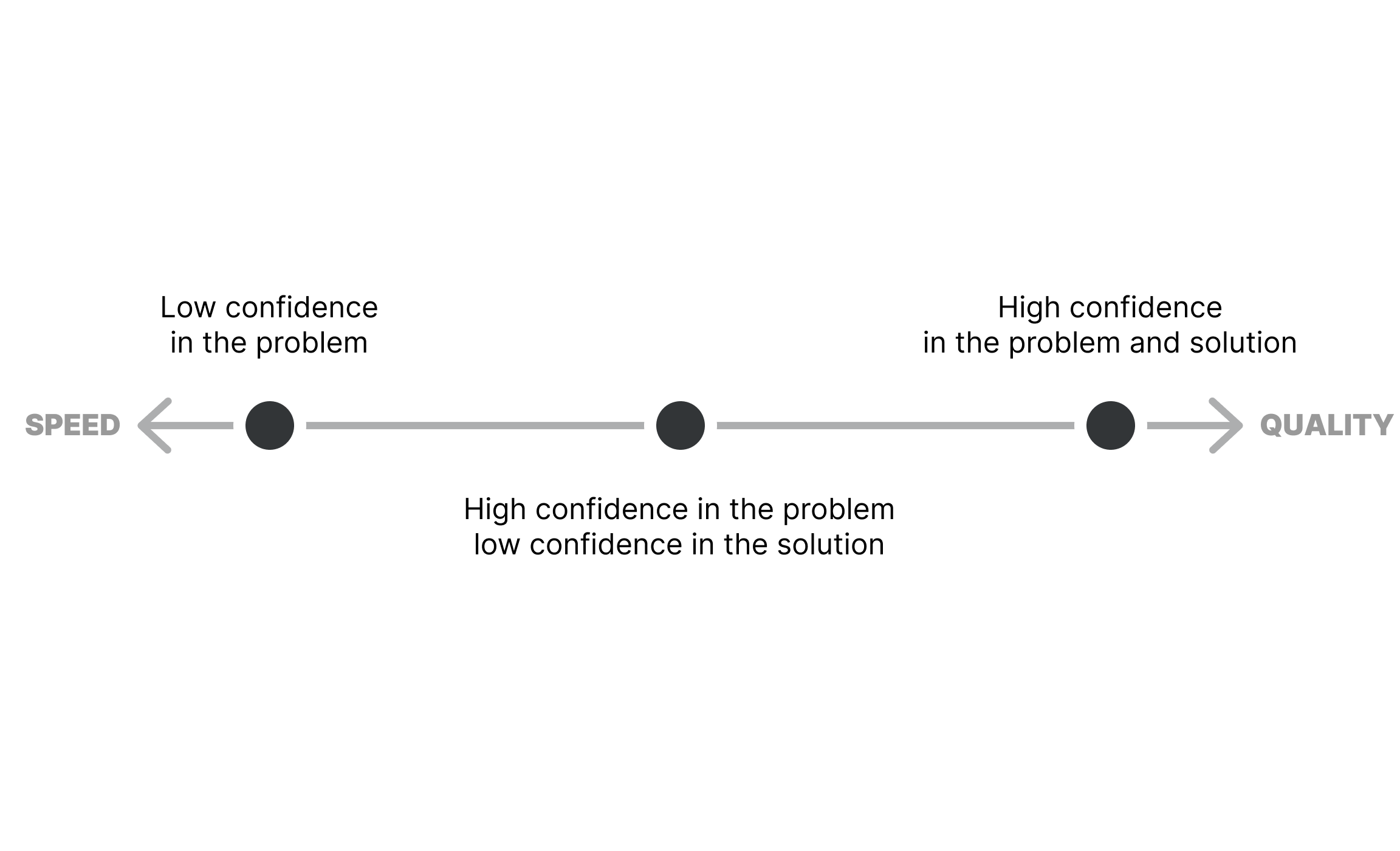
There are three basic outcomes:(有三个基本结果。)
- Is your confidence in the problem importance low? Focus on speed.
(你对问题的重要性信心不足吗?注重速度) - Is your confidence in the problem and the solution high? Focus on quality.
(你对问题和解决方案的信心高吗?注重质量。) - Is your confidence in the problem importance high, but low in the solution? Balance both speed and quality.
(你对问题的重要性的信心很高,但对解决方案的信心很低?平衡速度和质量。) - Of course, confidence isn't a switch but rather a scale. Therefore your outcome will be also more nuanced.
(当然,信心并不是一个开关,而是一个尺度。因此,你的结果也会有更细微的差别。)
Sources
"Product management mental models for everyone" by Brandon Chu.
Hard choice model 艰难选择模式
Figure out what kind of a decision you're making.
(弄清楚你在做什么样的决定。)
The hard choice model can help you see the kind of a decision you're making – whether it's a no-brainer,
(艰难的选择模式可以帮助你看到你正在做的决定是什么样的--它是一个不需要考虑的问题,)
a hard choice or something in between. It will enable you to move forward with your decision.
(一个艰难的选择,还是介于两者之间的问题。它将使你能够推进你的决定。)
![]()
How to use it
Think about two factors of your decision:
(思考你的决定的两个因素:)
- How impactful it is
(影响有多大。) - How easy it is to compare the options
(比较各种选择有多容易。)
There are four kinds of decisions that you can make. This model places them based on those two factors:
(有四种你可以做出的决定。这个模型根据这两个因素对它们进行定位。)
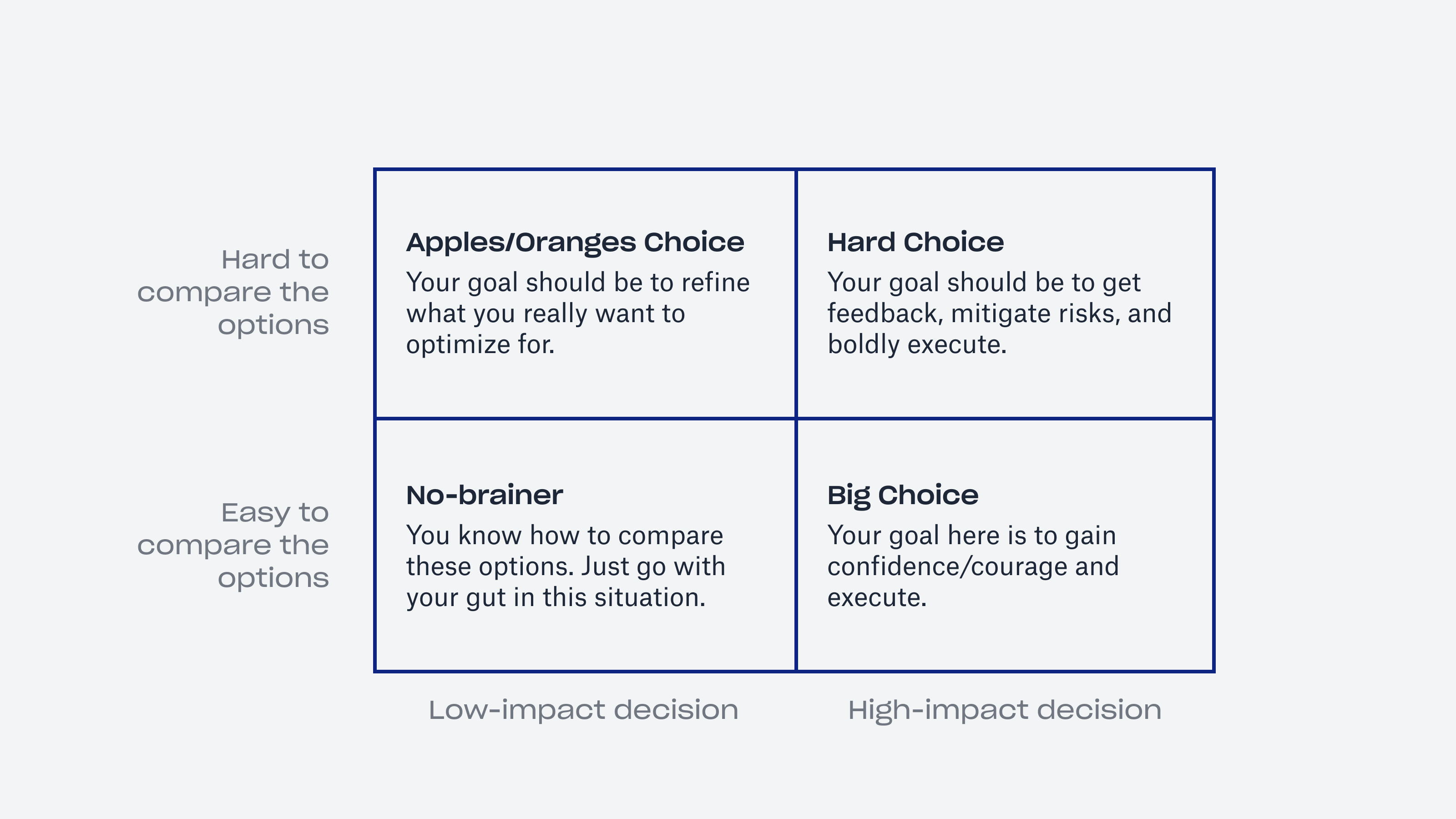
No-brainer (不费吹灰之力)
Decision with low-impact where it's easy to compare the options.
(做出影响较小的决定,很容易比较各种选择。)
Here you can move fast and go with your gut feeling.
(在这里,你可以快速行动,跟着你的直觉走。)
Apples/Oranges choice (苹果/橘子的选择)
Decision with low-impact where it's hard to compare the options.
(具有低影响的决定,其中难以比较的选项。)
You should refine your options based on what is really important to you.
(你应该根据对你来说真正重要的东西来细化你的选择。 )
Big choice (大选择)
Decision with high-impact where it's easy to compare the options.
(影响力大的决定,很容易比较各种选择。 )
You need to gain confidence before making the decision.
(你需要在做决定前获得信心。 )
Hard choice (艰难选择)
Decision with high-impact where it's hard to compare the options.
(具有高度影响的决策,很难比较各种选择。)
In this case, a tool like the decision matrix.
(在这种情况下,决策矩阵)
can help you carefully evaluate options based on different factors.
(可以帮助你根据不同的因素仔细评估选项。)
Move forward (向前迈进)
When you can categorize your decision using this model,
(当你能用这种模式对你的决定进行分类.)
it will enable you to take the appropriate action.
(它将使你能够采取适当的行动。 )
Sources
"Mental models for designers" by Wes O'Haire.
如何解决问题
Ishikawa Diagram 石川图(因果图,鱼骨图)
Identify root causes of problems.
(确定问题的根本原因。)
Ishikawa diagram is a great tool to help you solve problems by identifying their root causes.
(石川图是一个很好的工具,可以帮助你通过识别问题的根本原因来解决问题。)
Sometimes called also cause-and-effect or fishbone diagram,
(有时也被称为因果图或鱼骨图,)
it was created by Japanese professor Kaoru Ishikawa.
(它是由日本教授石川薰创造的。)
It's especially effective for tackling complex problems.
(它对解决复杂问题特别有效。)

How to use it
Building out this diagram consists of few simple steps.
(构建这个图由几个简单的步骤组成。)
This can be done in a group as a workshop but also just as well on your own.
(这可以在小组中进行,作为一个研讨会,但也可以在你自己身上进行。)
- Define the problem (确定问题)
Start with defining the problem and then drawing a line to the left or right of it (that's up to your preference).
(首先定义问题,然后在它的左边或右边画一条线(这取决于你的偏好)。)
The line will be for adding factors in the next step.
(这条线将用于在下一步增加产生问题的因素。)
- Identify contributing factors or categories (识别问题的原因或者类别)
List out the factors/categories that could be contributing to the problem you're solving. Plot them along the main line.
(列出可能导致你所解决的问题的因素/类别。将它们沿着主线绘制出来。 )
You can come up with your own factors or you might use generic categories: People, Equipments, Methods, Measurement, Material and Environment.
(你可以想出你自己的因素,或者你可以使用通用类别。人员、设备、方法、测量、材料和环境。)
Categorising is very helpful for breaking down complex problems and looking at them from different perspectives.
(分类对于分解复杂的问题和从不同角度看问题非常有帮助。)
- Find possible root causes related to each factor (找到与每个因素相关的可能的根本原因)
Ask "Why is this happening?" Write down each idea as a line under the factor it relates to.
(问 "为什么会发生这种情况?" 将每个想法写在它所涉及的因素下的一行。 )
First principles thinking is useful here including the "Five whys" method.
(第一原则思维在这里是有用的,包括 "五个为什么 "的方法。 )
Keep in mind that the problem might not have just one root cause but multiple.
(请记住,问题的根源可能不只是一个,而是多个。)
So it's important to capture everything that might explain the problem, even if just partially.
(因此,捕捉所有可能解释问题的东西是很重要的,即使只是部分的。)
At this point, you should have a complete diagram but no definitive answer yet.
(在这个基础上,你应该有了一个完整的图表,但是还没有明确的答案。)
- Analyse the diagram (分析这个图表)
The most important step is looking at all the possible root causes and analysing them.
(最重要的步骤是查看所有可能的根源并对其进行分析。 )
The diagram now provides a structure for your most important thinking and next steps.
(现在,该图为你最重要的思考和下一步行动提供了一个结构。 )
There are many possibilities what you can do at this point.
(在这一点上,你可以做的事情有很多)
Perhaps you can gather more data/evidence for each root cause candidate or immediately identify the most likely one and quickly try to solve it.
(也许你可以为每个根本原因候选人收集更多的数据/证据,或者立即确定最可能的原因并迅速尝试解决它。)
This will depend on your specific problems and identified possible causes.
(这将取决于你的具体问题和确定的可能原因。)
Example
Now let's see how to apply this on a practical example.
(现在让我们来看看如何在一个实际的例子中应用这个方法。)
Suppose you're a product manager and have to solve a trend of getting less and less new sign-ups.
(假设你是一个产品经理,必须解决一个新注册用户越来越少的趋势。)
You start with this definition and then identify contributing factors.
(你从这个定义开始,然后找出促成因素。)
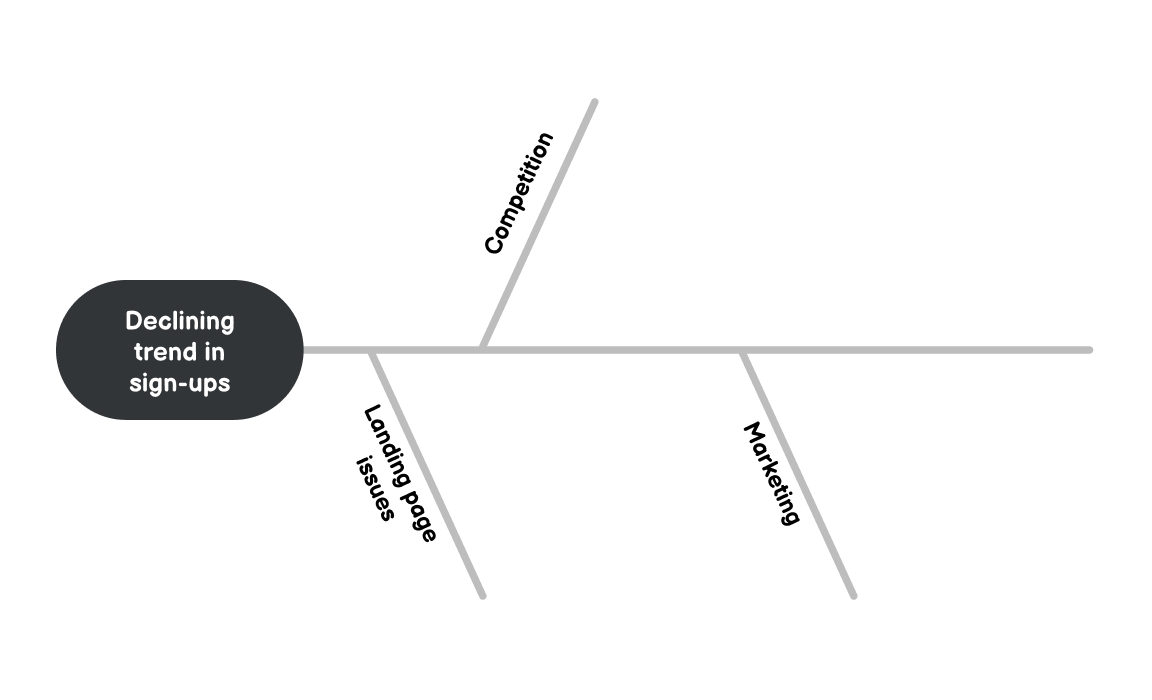
In this example, you identified landing page issues, competition and marketing as factors.
(在这个例子中,你把登陆页面问题、竞争和营销作为因素。)
Now let's find specific possible root causes under each factor:
(现在让我们在每个因素下找到具体的可能根源。 )

With all of these written down, you can begin to analyse where the problem originates.
(写下所有这些,你就可以开始分析问题的根源所在。)
In this example, you might first verify if the conversion rate is steady despite lower traffic.
(在这个例子中,你可以首先验证一下,尽管流量减少,但转换率是否稳定。)
Then you might audit your sign-up flow to find any leaks and possibly streamline it.
(然后,你可能会审计你的注册流程,以找到任何漏洞,并可能精简它。)
This is a simplified example but this diagram can be definitely used for much more complex problems.
(这是一个简化的例子,但这个图绝对可以用于更复杂的问题解决上。 )
Takeaway
Ishikawa diagram offers a simple framework for finding root causes of problems:
(石川图为寻找问题的根本原因提供了一个简单的框架。)
1.Define the problem (定义问题)
2.Identify contributing factors or categories (确定问题产生因素或者类别)
3.Find possible root causes related to each factor (找到与每个因素相关的可能的根本原因)
4.Analyse the diagram (分析图表)
You'll create the diagram with the first three steps. It will then provide a structure for your analysis.
(你将通过前三个步骤创建图表。然后,它将为你的分析提供一个结构。 )
Sources
["How to create cause-and-effect diagrams" by HarvardX (Video)]()
"Fishbone Diagram" by American Society for Quality
Conflict Resolution Diagram 冲突解决图示
Find win-win solutions to conflicts
(找到解决冲突的双赢办法 )
Handling conflicts carefully is important. Conflict Resolution Diagram (also called "Evaporating Cloud") is a tool
(谨慎处理冲突是很重要的。冲突解决图(也叫 "蒸发云")是一种工具,)
that will help you resolve them peacefully while making sure that needs of both sides are met.
(它将可以帮助你和平地解决它们,同时确保双方的需求得到满足。)
It's one of the thinking tools developed as part of the Theory of Constraints by Eliyahu Goldratt.
(它是由Eliyahu Goldratt开发的思维工具之一,是约束理论的一部分。)
Let's see how it works.
(让我们看看它是如何工作的。)
How to use it
The best time to use this tool is when you run into a conflict that seems impossible to resolve by accepting the proposal of either side.
(使用这一工具的最佳时机是当你遇到一个似乎不可能通过接受任何一方的提议来解决的冲突。 翻译不佳)
This can be a conflict with others but also internal.
(这可以是与他人的冲突,也可以是内部冲突。)
It can be professional or personal. You can draw the diagram on a whiteboard, piece of paper or run through it in your head.
(它可以是专业的,也可以是个人的。你可以在白板上、纸上画出这个图,或者在你的头脑中运行这个图。)
The diagram is very simple and consists of three parts:(这张图非常简单,由三部分组成。)
- Demands/proposals of the opposing sides: these are usually mutually exclusive which is what creates the conflict.
(对立双方的要求/建议:这些要求/建议通常是相互排斥的,这就是产生冲突的原因。) - Underlying needs or requirements of both sides
(双方的基本需求或要求) - Shared goal or objective that's behind the needs
(需求背后的共同目标或目的)
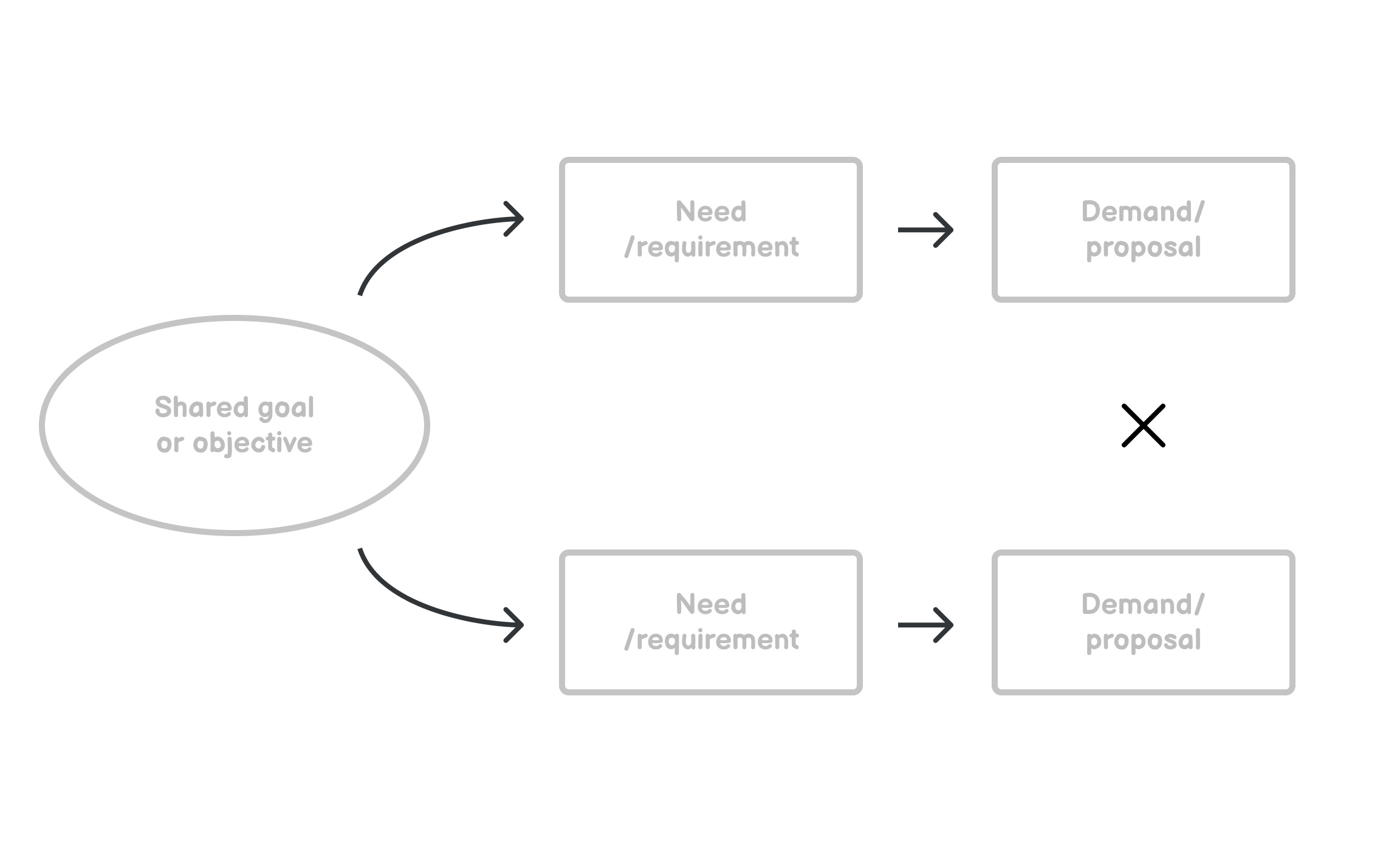
In this case, you work the diagram backwards – from right to left.
(在这种情况下,你要倒着看图--从右到左。)
- Identify what each side is arguing for – what are the demands or proposals.
(确定每一方所争论的内容--有哪些要求或建议。)
- Ask: What does the other side want to do? What do I want to do?
(问: 另一方想做什么?我想做什么?)
- Define the need that's behind each side's position.
(界定每一方立场背后的需求。)
- Ask: What needs are satisfied by the proposal of each side?
(问道:"对方的提议满足了什么需求?每一方的提议能满足哪些需求?)
- Find what's the shared goal:
(找到共同的目标是什么:)
- Ask: What will be achieved by meeting the needs of both sides?
(问:通过满足双方的需求,可以达到什么目的?通过满足双方的需求,可以实现什么?) - This is the most critical part. There's usually something that both sides want to achieve on a higher level but have different views about how to do it.
(这是最关键的部分。通常有一些东西是双方都想在更高层次上实现的,但对如何做到这一点却有不同看法。)
Acknowledge that you're on the same team to achieve that objective.
(承认你们是在同一个团队中实现这个目标。 翻译不佳)
Identifying the shared goal is necessary for finding a win-win solution.
(确定共同的目标对于找到一个双赢的解决方案是必要的。)
Discuss any assumptions that are behind the original proposals – this usually shines the light on the mutual exclusivity that created the conflict.
(讨论原始建议背后的任何假设--这通常会让人看到造成冲突的相互排斥性。)
From here, you can build up a new solution. This time with focus on the shared goal and satisfying the needs of both sides.
(从这里,你可以建立起一个新的解决方案。这一次的重点是共同的目标和满足双方的需求。)
And that's why the conflict can be resolved:
(这就是为什么冲突可以得到解决。)
1.peacefully: by looking for what unites both sides.
(和平地解决:通过寻找使双方团结的因素。)
2.and productively: by working toward a win-win solution that helps achieve the shared goal.
(和富有成效地:通过努力实现双赢的解决方案,帮助实现共同的目标。)
Example
Let's look at how this could be used in practice.
(让我们来看看这在实践中如何使用。)
Say you're debating redesigning your product website with your colleague.
(假设你正在和你的同事争论重新设计你的产品网站。)
You're against the project but your colleague is pushing for it.
(你反对这个项目,但你的同事却力挺它。)
You've been discussing this for an hour without any result.
(你们已经讨论了一个小时,没有任何结果。)
To move on, you suggest to create this conflict resolution diagram.
(为了继续前进,你建议创建这个冲突解决图。)
First, you write down both sides of the argument: redesigning vs not.
(首先,你写下争论的双方:重新设计 vs 不重新设计。)
After that, you identify the need behind each approach by discussing why exactly each approach is better.
(然后,你通过讨论为什么每种方法都更好,来确定每种方法背后的需求。)
You find out that your colleague needs the website to have a better conversion rate.
(你发现,你的同事需要网站有更好的用户转换率。)
You're arguing against the project because
(你反对这个项目,)
you want to minimize waste of resources and you see a big risk in such a big project.
(因为你想尽量减少资源的浪费,而且你认为这样一个大项目有很大的风险。)
Finally, you work together to identify what's the goal you both want to achieve by meeting those needs.
(最后,你们一起工作,确定什么是你们双方都想通过满足这些需求来实现的目标。)
You discover that you both want to meet the financial goals of the company.
(你们发现,你们都想满足公司的财务目标。)
The shared objective is running a profitable business.
(共同的目标是经营一个有利可图的企业。)
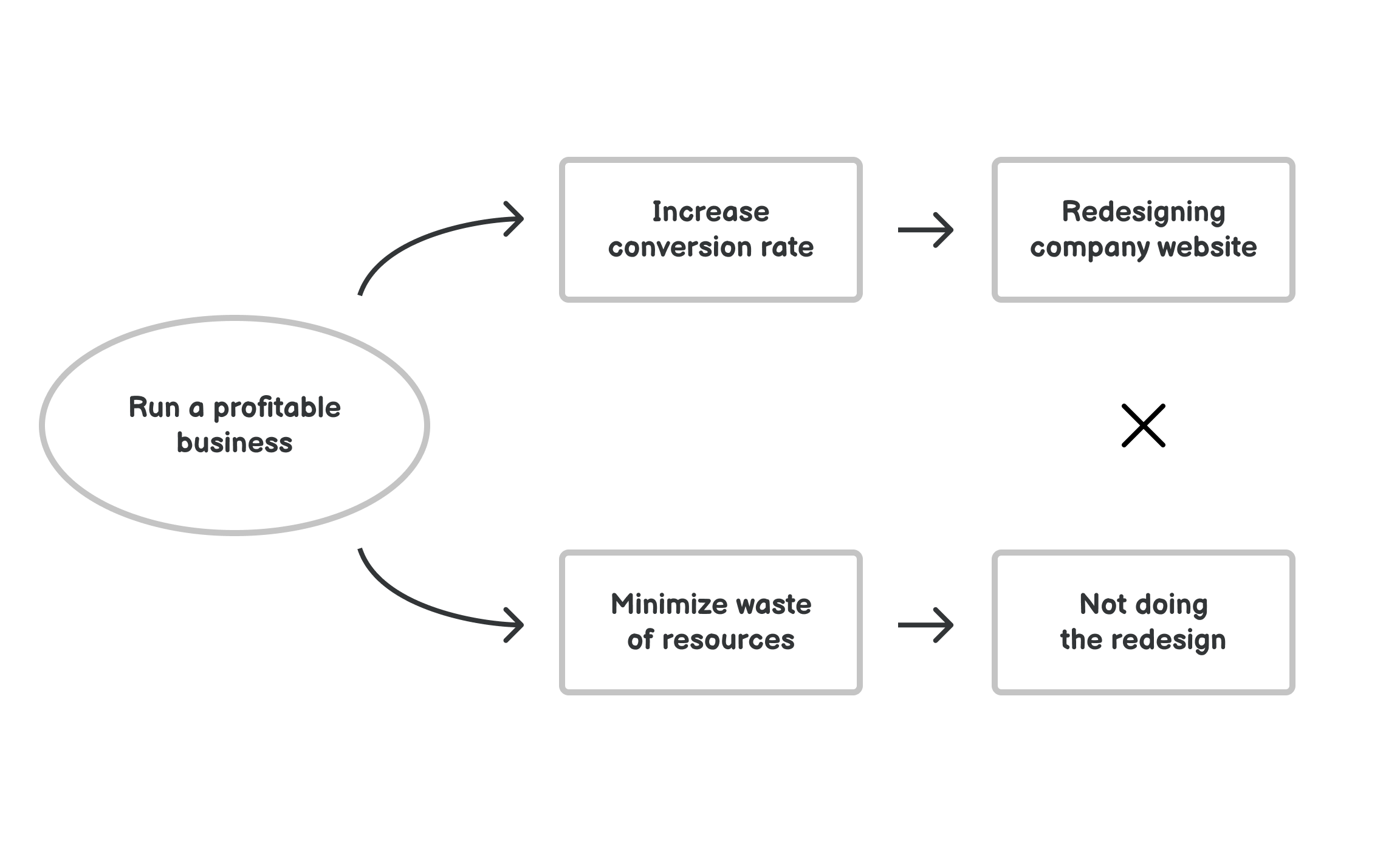
This is great progress as now you have something in common to work with.
(这是很大的进步,因为现在你们有了共同的东西来工作。)
By working from what you have in common, you are able to resolve the conflict
(通过从你们的共同点出发,你们能够解决冲突,)
and come up with a solution that supports your goal and meets both of your needs:
(并提出一个支持你们的目标和满足你们双方需求的解决方案:)
such as running small targeted experiments on your website that can move
(例如在你们的网站上进行小型的有针对性的实验,)
the needle on conversion rate without using a lot of resources.
(可以在不使用大量资源的情况下推动转换率。)
It's a simplified example but shows the great benefit of using the conflict resolution diagram: finding win-win solutions.
(这是一个简化的例子,但显示了使用冲突解决图的巨大好处:找到双赢的解决方案。)
Sources
The Logical Thinking Process by H. William Dettmer
'The Punk Strategy Guide to the Logical Thinking Process' on Forte Labs Blog
Productive Thinking Model 生产性思维模式
Solve problems creatively and efficiently.
(创造性地、高效地解决问题。)
By applying more structured and critical thinking, you can understand the problem at hand better
(通过应用更多的结构化和批判性思维,你可以更好地理解手头的问题,)
and come up with more creative solutions to it. The Productive Thinking Model, created by Tim Hurson, can help you do just that.
(并想出更有创意的解决方案。由Tim Hurson创建的 "生产性思维模型 ",可以帮助你做到这一点。)
It's best used when a problem is already defined and you're looking for creative solutions.
(它最适合在问题已经确定,而你正在寻找创造性的解决方案时使用。)
How to use it
This tool gives you a 6-step framework for problem-solving. The six steps are:
(这个工具为你提供了一个解决问题的六步框架。这六个步骤是: )
- Ask "What's going on?"
(问 "发生了什么事?") - Ask "What's success?"
(问 "什么是成功?" ) - Ask "What's the question?"
(问 "问题是什么?" ) - Generate answers
(产生答案) - Forge the solution
(形成解决方案) - Align resources
(整合资源)
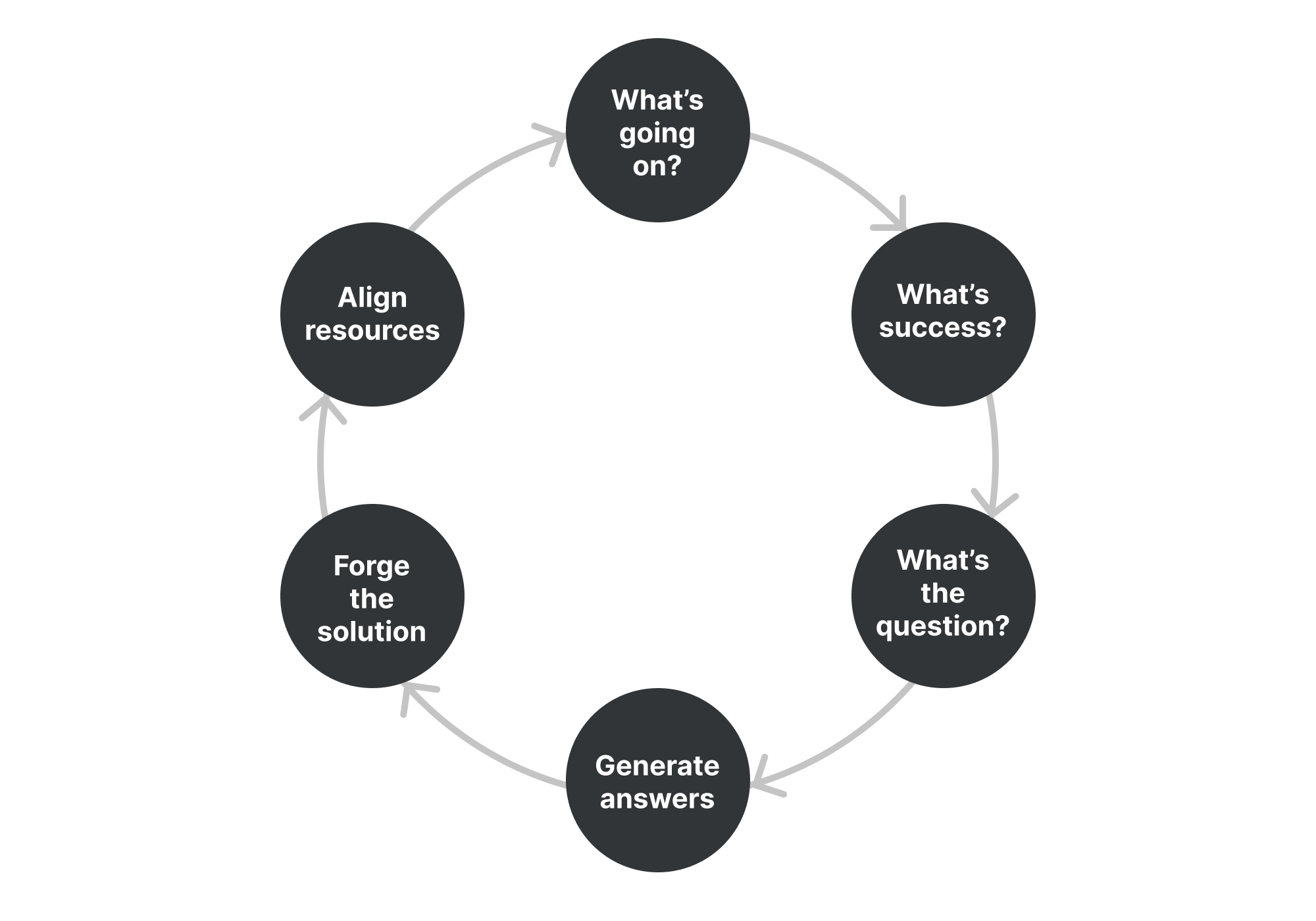 ;
;
Let's look at each step in more detail.
(让我们更详细地看看每个步骤。)
1. Ask "What's going on?" (问 "发生了什么事?")
The first step is about understanding the problem better.
(第一步是要更好地理解问题。 )
You can use these guiding questions to help you:
(你可以使用这些指导性问题来帮助你。 )
- What's the problem exactly?
(究竟是什么问题? ) - What's the impact of this problem?
(这个问题的影响是什么? ) - What do I already know? What information do I have?
(我已经知道什么?我有什么信息?) - Who is involved in this?
(谁参与了这件事?) - What's the vision of the future when this problem is solved?
(这个问题解决后,对未来的愿景是什么? )
(This is what Hurson calls the "Target Future")
(这就是赫森所说的 "目标未来")
Document the answers you gather here as you'll need them later in the process.
(记录你在这里收集到的答案,因为你在以后的过程中会需要它们。 )
2. Ask "What's success?" (问 "什么是成功?" )
This step will help you define what success looks like in your vision of the future (that you created in the previous step).
(这一步将帮助你定义成功在你的未来愿景中是什么样子的(你在上一步创建的)。 )
To come up with the success criteria, you can use the DRIVE framework:
(为了提出成功标注,你可以使用 DRIVE 框架)
- What do you want the solution to do?
(你希望解决方案能做什么?) - What are the restrictions? What must it not do?
(有什么限制?什么是不能做的?) - (You can use inversion to help you here)
((你可以在这里使用 反转法 来帮助你)) - What resources can we invest in this?
(我们可以在这方面 投入什么 资源?) - What values should the solution have?
(该解决方案应该具有哪些 价值 ?) - What are the essential outcomes?
(基本的结果 是什么?)
Feel free to cycle through these questions until you have a clear vision of success in front of you.
(请自由地循环讨论这些问题,直到你面前有一个清晰的成功愿景。)
3. Ask "What's the question?" (问:"问题是什么?")
Now it's time to generate questions that must be answered to achieve your vision (the Target Future).
(现在是时候产生为实现你的愿景(目标未来)而必须回答的问题。)
Hurson calls these "catalytic questions".
(Hurson称这些为 "催化性问题"。)
Use the information you've gathered in the previous steps.
(使用你在前面的步骤中收集的信息。)
Phrases like "How might we...?" or "How can I...?" will help you formulate the questions.
(诸如 "我们怎样才能...... "或 "我怎样才能...... "这样的短语将帮助你制定问题。)
4. Generate answers
In this step, try to come up with as many answers to the catalytic questions as you can.
(在这一步,尽量想出更多催化问题的答案。)
Brainstorm, don't judge and collect ideas. These are your potential solutions.
(进行头脑风暴,不要判断,收集想法。这些是你的潜在解决方案。)
In the next step, you will narrow down your list of ideas to the most promising ones.
(在下一步,你将把你的想法清单缩小到最有希望的想法。)
5. Forge the solution (提炼理解方案)
You need to choose the best solution before developing it further.
(在进一步发展之前,你需要选择最佳的解决方案。)
Take your list from the previous step and evaluate each idea/solution against the success criteria from step 2.
(拿出上一步的清单,对照第二步的成功标准评估每个想法/解决方案。)
Use a decision matrix to make this step easier.
(使用决策矩阵,使这一步更容易。)
Now you can think about building on your selected solution(s).
(现在你可以考虑在你选定的解决方案的基础上进一步发展。)
What could make it better? How can you make it fit the success criteria more?
(什么可以使它变得更好?如何才能使它更符合成功标准?)
6. Align resources (调整资源)
In this final step, you move toward executing the solution.
(在这最后一步中,你将走向执行解决方案。)
Write down which actions and resources are necessary to make this happen.
(写下哪些行动和资源是实现这一目标所必需的。)
Identify people who are responsible for it – in whole as well as each part of the solution.
(确定负责此事的人--整体以及解决方案的每个部分。)
It's best to specify all of this in detail so that you have a clear plan of action.
(最好详细说明所有这些,以便你有一个明确的行动计划。)
You should now be able to execute the solution.
(现在你应该能够执行解决方案了。)
Example
Let's look at how this tool can be used in a practical example.
(让我们来看看这个工具如何在一个实际的例子中使用。)
Suppose that what you're solving is winning a prospective customer.
(假设你要解决的问题是赢得一个潜在的客户。)
When you probe about the situation, you find out that:
(当你探究情况时,你发现。)
- It's a customer with difficult requirements but one that could bring in a lot of revenue.
(这是一个有要求苛刻的客户,但却是一个可以带来大量收入的客户。) - The impact of losing this revenue could be significant for your business.
(失去这部分收入对你的业务影响可能很大。) - Your sales team has been in touch with them and know that ease of use is important for them, among other things.
(你的销售团队一直在与他们接触,知道易用性对他们来说很重要,还有其他的事情。)
Your vision (or target future) is that the customer is successfully onboarded, uses your product daily and brings in the revenue.
(你的愿景(或目标未来)是,客户成功入职,每天使用你的产品,并带来收入。)
Let's now define success, as per step 2, using the DRIVE framework:
(现在,让我们按照第2步,用 DRIVE 框架来定义成功。)
-
What must the solution do? Show the customer the value of your product and also how well you can take care of them.
(该解决方案必须做什么?向客户展示你的产品的价值,也展示你对客户的照顾有多好。) -
What are the restrictions? The solution must show that we meet the customer's requirements and that the product is easy to use.
(有什么限制?解决方案必须显示我们满足客户的需求,并且产品易于使用。) -
What resources can we invest in this? We can invest two weeks of two salespeople and one week of a designer and an engineer.
(我们可以在这方面投入什么资源?我们可以投资两个星期的两个销售人员,一个星期的设计师和一个工程师。) -
What values should the solution have? It's convincing, transparent and thoughtful.
(该解决方案应该具有哪些价值? 它是有说服力的、透明的和周到的。 ) -
What's the essential outcome? Customer agrees to sign a contract.
(基本结果是什么?客户同意签署合同。)
We can now move on to defining the "catalytic questions" that must be answered to reach our vision:
(我们现在可以继续界定为实现我们的愿景而必须回答的 "催化问题"。) -
How might we show the value of the product in a way that meets their requirements?
(我们如何以符合他们要求的方式来展示产品的价值?) -
How do we demonstrate the ease of use?
(我们如何展示使用的便利性?)
Let's say these are the most critical questions and we need to focus on them.
(比方说,这些是最关键的问题,我们需要关注它们。)
We can brainstorm some answers (potential solutions):
(我们可以进行头脑风暴,提出一些答案(潜在的解决方案)。)
- Present a slide deck with product and company highlights
(提出一个包含产品和公司亮点的幻灯片) - Build an interactive demo personalized for the customer
(为客户建立一个个性化的互动演示) - Spend a day with the potential end-users and have them try the product hands-on
(花一天时间与潜在的终端用户在一起,让他们亲身体验产品) - Give key stakeholders a tour of the product
(让关键的利益相关者参观一下产品)
Now we need to choose the most promising solution.
(现在我们需要选择最有希望的解决方案。)
For the sake of simplicity, let's say we used the decision matrix and
(为了简单起见,假设我们使用了决策矩阵,)
it turns out that the best solution seems to be spending a day with
(结果发现最好的解决方案似乎是花一天时间)
the potential end-users and having them try the product hands-on.
(与潜在的终端用户在一起,让他们亲身尝试产品。)
We can make this even better by inviting key stakeholders to observe
(我们可以通过邀请关键的利益相关者来观察,)
so they can see the value the product can bring to their users and also that it's easy to use for them.
(让他们看到产品能给他们的用户带来的价值,同时也看到产品对他们来说是很容易使用的,这样做就更完美了。)
The final step would be to align the resources: we will send a small team consisting of two salespeople and an engineer (to set up the product on-site) to travel to the customer for a day.
(最后一步将是调整资源:我们将派出一个由两名销售人员和一名工程师(负责现场设置产品)组成的小团队,前往客户处进行为期一天的考察)
The Sales VP will be responsible for coordinating this.
(销售副总裁将负责协调此事。)
And an engineering manager will be tasked with preparing the right version of the product for the trial.
(而一位工程经理将负责为试用准备正确的产品版本。)
We now have a clear plan of action for the most promising solution to the problem.
(我们现在有了一个明确的行动计划,以解决这个问题的最有希望的方案。)
Takeaway
The Productive Thinking Model enables you to solve problems creatively through structured,
(生产性思维模式使你能够通过结构化的批判性思维创造性地解决问题。)
critical thinking. It offers a 6-step framework:
(它提供了一个6个步骤的框架。)
- Ask "What's going on?"
(问 "发生了什么?") - Ask "What's success?"
(问 "成功是什么?") - Ask "What's the question?"
(问 "问题是什么?") - Generate answers
(产生答案) - Forge the solution
(形成解决方案) - Align resources
(调整资源)
After going through these steps, you should be equipped with an action plan based on the best solution to your problem.
(在经历了这些步骤之后,你应该具备一个基于解决问题的最佳方案的行动计划。)
Sources
"Think Better: An Innovator's Guide to Productive Thinking" by Tim Hurson
Abstraction laddering 抽象的阶梯式发展
Frame your problem better with different levels of abstraction.
(用不同的抽象层次来更好地构建你的问题。)
Abstraction laddering is a tool for framing problems more skillfully.
(抽象阶梯法是一种更有技巧地构建问题的工具。)
It helps with defining a problem that you need to solve more clearly.
(它有助于更清楚地定义你需要解决的问题。)
It helps you to move beyond an initial problem statement.
(它可以帮助你超越最初的问题陈述。)
This tool provides you with the ability to ask the right questions to move up and down the ladder.
(这个工具为你提供了提出正确问题的能力,使你能够在阶梯上向上和向下移动。)
Move up to expand the scope, to "see the forest for the trees".
(向上移动以扩大范围,"只见树木不见森林"。)
Move down to develop concrete solutions.
(向下移动以制定具体的解决方案。)
How to use it
-
Start with an initial problem statement in the middle of the ladder.
(从阶梯中间的初始问题陈述开始。) -
Ask "why" questions to get more abstract problem statements. This can help you frame the problem differently.
(提出 "为什么 "的问题以获得更抽象的问题陈述。这可以帮助你以不同的方式构建问题。) -
Ask "how" questions to step toward a more concrete statement or solution.
(问 "如何 "的问题,以迈向更具体的陈述或解决方案。)
This helps you come up with different problem statements than the one you started with.
(这有助于你想出与开始时不同的问题陈述。)
It enables you to find more innovative solutions.
(它使你能够找到更多创新的解决方案。)
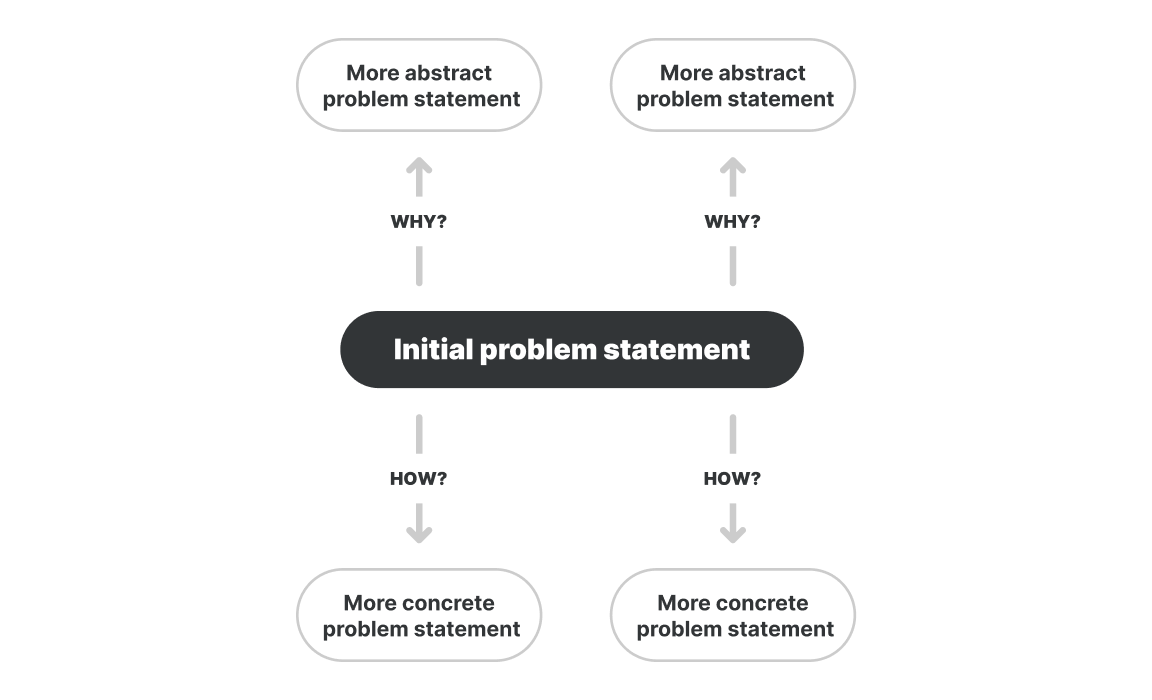
The great thing about this tool is that you can use it anywhere in the design process.
(这个工具的好处是,你可以在设计过程的任何地方使用它。)
It can be used fairly quickly—in mere minutes—whether you're working alone or in a workshop setting with your team.
(无论你是单独工作还是与你的团队一起在车间里工作,它都可以很快地被使用--只需几分钟。)
What does it look like in practice? (它在实践中是什么样子的?)
Here's a simple example from Wes O'Haire from Dropbox:
(下面是来自 Dropbox 的 Wes O'Haire 的一个简单例子:)
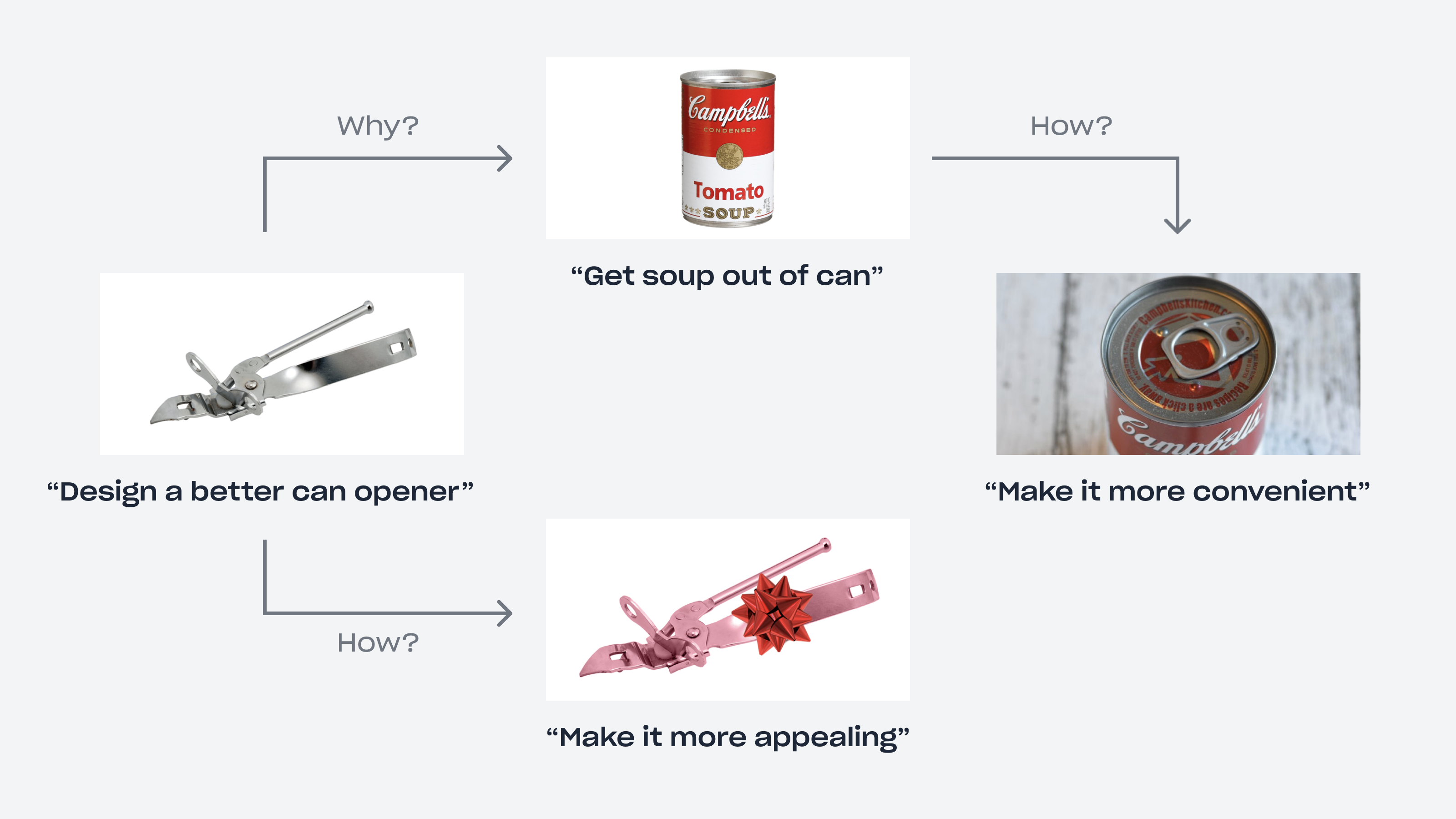
He starts with an initial problem statement: "Design a better can opener".
(他从一个最初的问题陈述开始:"设计一个更好的开罐器")
Initially asking "how?", he gets to a more concrete statement "Make it more appealing".
(最初问 "怎么做?",他得到一个更具体的陈述:"让它更吸引人"。)
But he can also go up the ladder: "Why do we need a better can opener?"
(但他也可以往上爬:"为什么我们需要一个更好的开罐器?")
This leads him to the more abstract problem statement: "Get soup out of the can".
(这将他引向更抽象的问题陈述: "把汤从罐子里拿出来".)
From there, he might ask "How might we get the soup out of the can?".
(从那里,他可能会问:"我们怎样才能把汤从罐子里弄出来呢?")
That enables defining a different problem statement: "Make it more convenient."
(这就可以定义一个不同的问题陈述。"让它更方便"。)
Sources
"Mental models for designers" by Wes O'Haire
"Abstraction laddering" by Autodesk
Inversion 反转法
Approach a problem from a different point of view.
(从不同的角度来处理问题。)
Inversion is useful when you need to view the problem you're solving from a different angle.
(当你需要从不同的角度来看待你正在解决的问题时,反转是很有用的。)
It can help you see a different perspective and imagine worst-case scenarios.
(它可以帮助你看到不同的视角,想象最坏的情况。)
How to use it?
A good trigger question to know if inversion can help you is "Am I only thinking of ideal solutions or scenarios?"
(要知道反转是否能帮助你,一个很好的触发问题是:"我是否只想到了理想的解决方案或情景?")
You can then invert your thinking about the problem or a solution. To do that, follow these steps:
(然后你可以反转你对问题或解决方案的思考。要做到这一点,请遵循以下步骤。)
- Ask yourself: What would be the worst decision/solution in this situation?
(问问自己。在这种情况下,最糟糕的决定/解决方案是什么?) - Ask yourself: Why would it be bad? Write those reasons down.
(问问自己。为什么会是坏的?把这些原因写下来。) - Try to come up with a good decision/solution, now by looking at the reasons that would make a bad decision.
(试着想出一个好的决定/解决方案,现在看看那些会做出坏决定的原因。 )
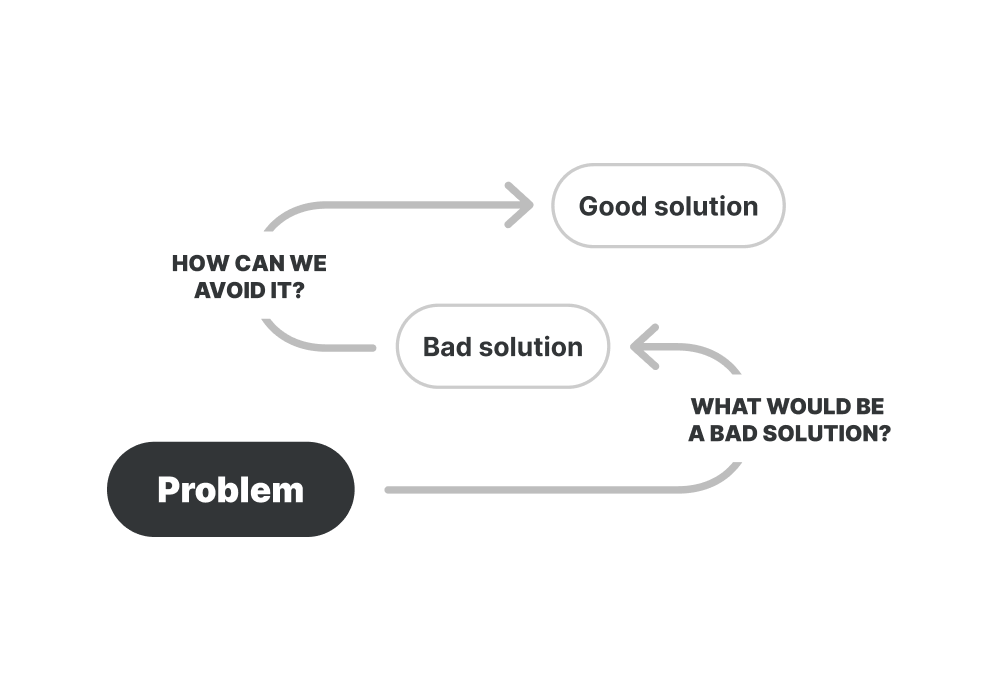
Inversion helps you see the bad outcomes and therefore avoid them.
(倒置有助于你看到不好的结果,从而避免它们。)
More questions that could help you see the inverted perspective are:
(更多可以帮助你看到倒置观点的问题是。)
- How could this go wrong? (这怎么可能出错?)
- What would the opposite of this be? (与此相反的情况会是什么?)
- What would make a bad solution to this? (什么会使这个问题的解决变得糟糕?)
###Inversion in practice
Project managers use inversion in an exercise called pre-mortem.
(项目经理们 (风险管理中) 在一种叫做 "预验收 "的练习中使用反转法。)
The team gathers to imagine it's six months from now and the project they've worked on has failed.
(团队聚集在一起,想象现在是6个月后,他们所做的项目已经失败。)
They examine this potential scenario by asking questions like "What went wrong?",
(他们通过询问 "什么地方出错了?"、)
"What mistakes did we make?" or "Why did this project fail?".
("我们犯了什么错误?"或 "为什么这个项目会失败?等问题来检查这种潜在的情况。)
This makes the team see potential pitfalls ahead of time and prepare for them.
(这使团队提前看到了潜在的陷阱,并为它们做好准备。)
By using inversion, they're able to avoid possible mistakes and bad outcomes.
(通过使用反转法,他们能够避免可能的错误和坏结果。)
Sources
"Mental models for designers" by Wes O'Haire
"Inversion" by James Clear
Issue trees 问题树
Structure and solve problems in a systematic way.
(以系统的方式构造和解决问题。 )
Issue trees are basically maps of problems.
(问题树基本上是问题的地图。)
They give you a clear and systematic way of looking at the problem you need to solve.
(它们给你提供了一种清晰和系统的方式来看待你需要解决的问题。)
They help you break down a big problem into smaller, more manageable ones,
(它们帮助你把一个大问题分解成更小、更容易管理的问题,)
and prioritize certain parts of the problem.
(并对问题的某些部分进行优先排序。)
In other words, they're useful for the "divide and conquer" strategy.
(换句话说,它们对 "分而治之 "的策略很有用。)
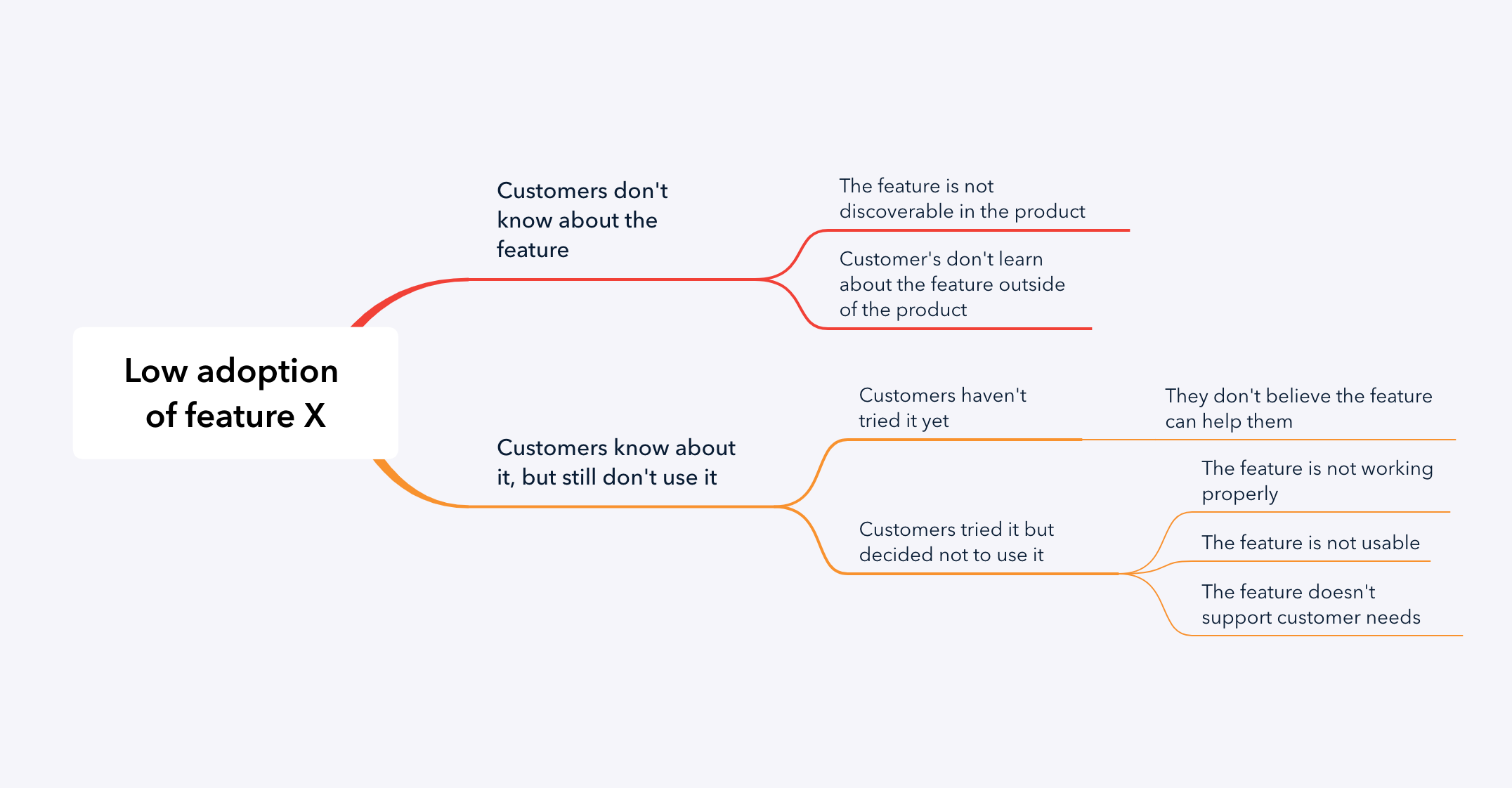
Issue trees are also great for communicating about a problem with others since they provide a map of the problem.
(问题树也是与他人沟通问题的好办法,因为它们提供了问题的地图。)
There are two basic kinds of issue trees:
(有两种基本的问题树。)
- Problem trees – created by answering "Why?"
(问题树--通过回答 "为什么?"来创建。) - Solution trees – created by answering "How?"
(解决方案树--通过回答 "如何 "来创建。)
How to create an issue tree (如何创建问题树?)
Problem tree (问题树)
A good issue tree must cover the whole problem.
(一个好的问题树必须涵盖整个问题。)
It has to be rigorous. Here are some basic principles for creating an issue tree.
(它必须是严格的。以下是创建问题树的一些基本原则。)
1.Start breaking down the problem into separate categories/branches.
(开始将问题分解成独立的类别/分支。)
2.Use the MECE principle: mutually exclusive, collectively exhaustive.
(使用 MECE 原则:相互排斥,集体详尽。翻译不佳)
- Mutually exclusive means there is no overlap between different parts of the tree.
(相互排斥意味着树的不同部分之间没有重叠。)
Collectively exhaustive means they cover the whole problem.
(集体详尽意味着它们涵盖了整个问题。)
3.Do not go into the small details (specific hypotheses):
(不要进入小的细节(具体的假设):)
focus on capturing the broad categories that make up the problem.
(专注于捕捉构成问题的大的类别)
4.Apply the 80/20 rule: focus on the few parts of the problem that are most impactful.
(应用80/20规则:专注于问题中最有影响的几个部分。)
- This is best to base on data, rather than your own hypotheses.
(这最好是基于数据,而不是你自己的假设。)
Solution tree (解决树)
When you have singled out some specific parts of the problem that you want to focus on,
(当你挑出问题的一些具体部分,你想关注的问题 )
you can follow up with creating a solution tree.
(你可以跟进,创建一个解决方案树。)
1.Take the problem part you want to focus on and ask "How might we improve/fix this?"
(拿出你想关注的问题部分,然后问:"我们可以如何改进/解决这个问题?")
2.Map out potential categories of the solution
(绘制出解决方案的潜在类别)
3.Generate ideas within each category
(在每个类别中产生想法)
The advantage of this structured way of thinking is that working with constraints
(这种结构化的思考方式的好处是,与约束条件一起工作实际上)
will actually help you generate more ideas.
(会帮助你产生更多的想法。)
Example
Let's see an example of creating an issue tree.
(让我们看一个创建问题树的例子。)
Suppose you're working on a product and you're seeing customers
(假设你正在开发一个产品,你看到客户)
not adopting one of your key features. That will be the tree starting point.
(没有采用你的一个关键功能。这将是树的起点。)
We'll break it down to smaller branches that cover possible causes: (我们将把它分解成更小的分支,涵盖可能的原因。)
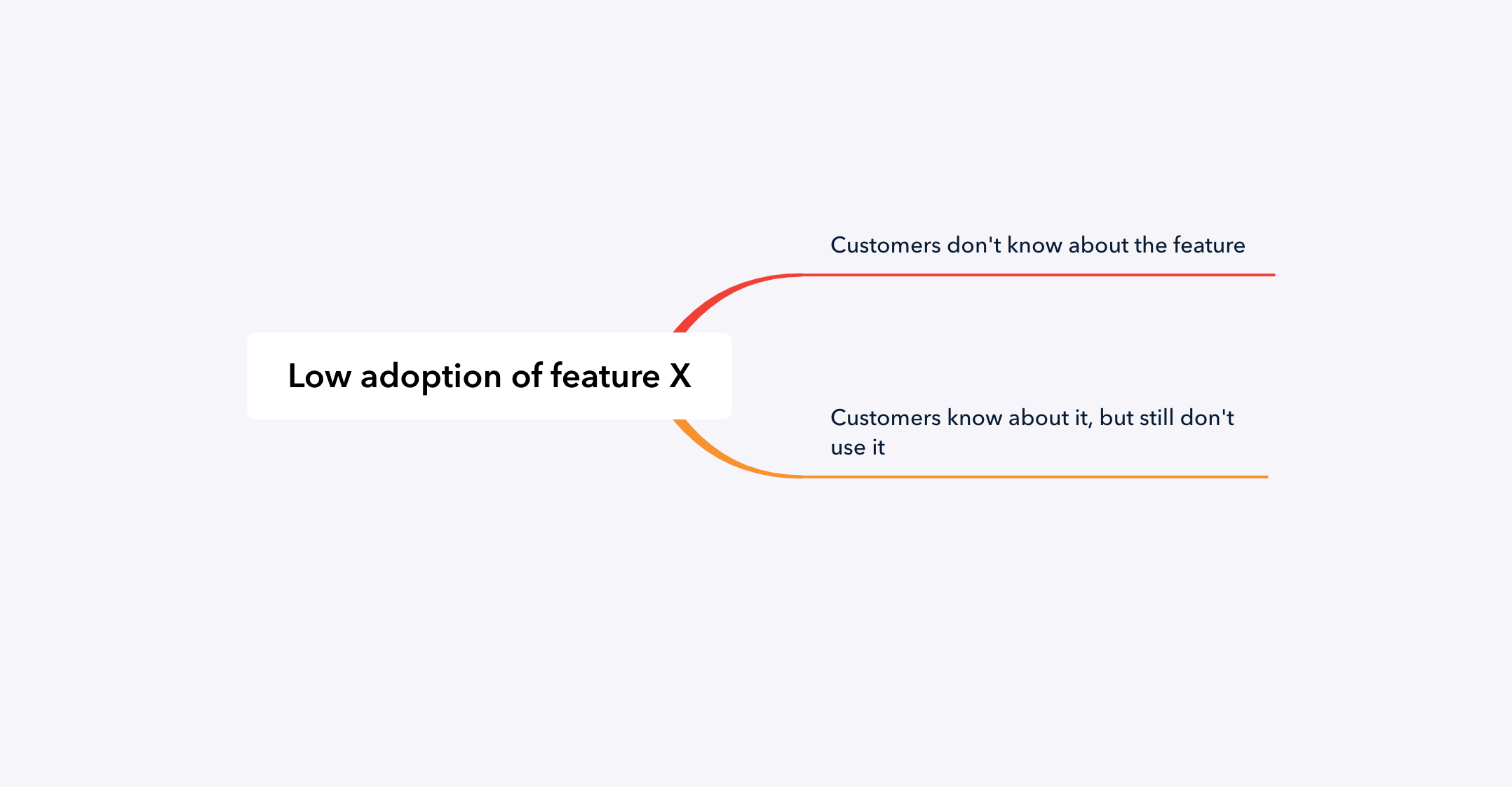
- Low adoption of feature X (功能 X 的采用率低)
- Customers don't know about the feature.(客户不知道这个功能。)
- Customers know about it, but still don't use it.(客户知道它,但仍然不使用它。)
For a first level of the tree, it's incredibly basic, (对于树的第一层来说,这是令人难以置信的基础,)
but it's actually MECE – it's mutually exclusive yet covers the whole problem.(但它实际上是 MECE--它是相互排斥的,但却涵盖了整个问题。)
Branching out further, we can eventually get this tree:(进一步分支,我们最终可以得到这棵树。)

- Low adoption of feature X (功能 X 的采用率低)
- Customers don't know about the feature (客户不知道这个功能。)
- The feature is not discoverable in the product (该功能在产品中无法发现)
- Customer's don't learn about the feature outside of the product (客户在产品之外没有了解到该功能)
- Customers know about it, but still don't use it (客户知道它,但仍然不使用它。)
- Customers haven't tried it yet (客户还没有尝试过该功能)
- They don't believe the feature can help them (他们不相信这个功能可以帮助他们)
- Customers haven't tried it yet (客户还没有尝试过该功能)
- Customers tried it but decided not to use it (客户尝试过,但决定不使用它)
- The feature is not usable (该功能无法使用)
- The feature is not working properly (该功能不能正常工作)
- The feature doesn't support customer needs (这个功能没办法满足客户的需求)
- Customers don't know about the feature (客户不知道这个功能。)
We could investigate even further, but already we can see which part of the problem to start with.
(我们可以进一步调查,但我们已经可以看到应该从哪一部分问题开始。)
In this case, focusing on the knowledge about the feature should be a high priority –
(在这种情况下,关注有关该功能的知识应该是一个高度优先事项--)
there might be nothing wrong with the feature, customers just don't know about it.
(该功能可能没有任何问题,客户只是不知道它)
This is a nice example of how a very simple issue tree can help you break down a problem
(这是一个很好的例子,说明一个非常简单的问题树可以帮助你分解问题)
and give you a starting point for solving it.
(并且给你一个解决问题的起点。)
Takeaway
Issue trees are a great tool for approaching problems systematically
(问题树是系统地处理问题的一个伟大工具)
by breaking them down. You can create problem issue trees (by asking "why?")
(分解它们。你可以创建问题树(通过问 "为什么"?))
or solution issue trees (by asking "how?") depending on where you are in the process of problem-solving.
(或解决方案问题树(通过问 "怎么做"),这取决于你在解决问题过程中的位置。)
Sources
"The Definitive Guide to Issue Trees" on Crafting Cases
First principles 第一原则
Break down complex problems into basic elements and create innovative solutions from there.
(将复杂的问题分解成基本元素,并从中创造出创新的解决方案。)
Sometimes also called "reasoning from first principles", it's a powerful tool for problem-solving.
(有时也被称为 "从第一原理推理",它是解决问题的有力工具。)
Identifying the basic principles of a problem will allow you to come up with innovative solutions.
(确定问题的基本原则将使你能够想出创新的解决方案。)
First principle is a basic principle or truth that cannot be broken down any further.
(第一原则是指不能再进一步分解的基本原则或真理。)
First-principles thinking is about digging deeper until you arrive at the very foundations of a problem.
(第一原则思维是指深入挖掘,直到你到达问题的根本所在。)
How to use it?
Start with your problem and take these two steps:
(从你的问题开始,采取这两个步骤。)
- Break it down to the most basic truths (first principles)
(把它分解成最基本的事实(第一原则)。) - Re-build a solution from those principles
(根据这些原则重新建立一个解决方案)
It sounds simple but requires some focused thinking to really dig deep in the problem and discover those first principles.
(这听起来很简单,但需要一些集中的思考,以真正深入挖掘问题并发现这些第一原则。)
There are some techniques to help you:
(有一些技巧可以帮助你。)
The Five Whys (五个为什么?)
This is a popular technique in user research where a researcher digs deeper by repeatedly asking "why" questions.
(这是用户研究中一种流行的技术,研究者通过反复询问 "为什么 "的问题来进行深入挖掘。)
It enables you to discover the root causes of problems.
(它使你能够发现问题的根本原因。)
Of course, you don't have to stop at five,
(当然,你不必止步于五个问题,)
but it's generally enough to discover a first principle.
(但一般来说,这足以发现第一个原则。)
Socratic questioning (苏格拉底式的提问)
A form of disciplined questioning that enables critical thinking.
(一种能够实现批判性思维的有纪律的提问形式。)
There are six types of questions you can ask to dig deeper for the fundamental truth:
(你可以提出六种类型的问题,以深入挖掘基本真理。)
1.Clarification – "What do you mean by...?"
(澄清--"你说的......是什么意思?")
2.Probing assumptions – "What could we assume instead?"
(探究假设--"我们可以用什么来代替假设?")
3.Probing reasons/evidence – "Why do you think this is true?"
(探究原因/证据--"为什么你认为这是真的?")
4.Implications and consequences – "What effect would that have?"
(影响和后果--"那会有什么影响?")
5.Different viewpoints – "What would be an alternative?"
(不同的观点--"另一种选择是什么?")
6.Questioning the original question – "What was the point of this question?"
(对原始问题的质疑--"这个问题的重点是什么?")
First principles in practice
Let's see first-principles thinking in action.
(让我们看看第一原理思维的实际应用。)
Here's a nice example from Wes O'Haire, designer at Dropbox:
(这里有一个来自 Dropbox 设计师 Wes O'Haire 的好例子。)
"I did this on a project last year where we started with our problem statement.
("我去年在一个项目中这样做了,我们从我们的问题陈述开始。)
From there, I broke it down into its fundamental parts,
(从那里,我把它分解成基本部分,)
then addressed each part, and reconfigured it to build up a solution."
(然后解决每个部分,并重新配置,以建立一个解决方案。")
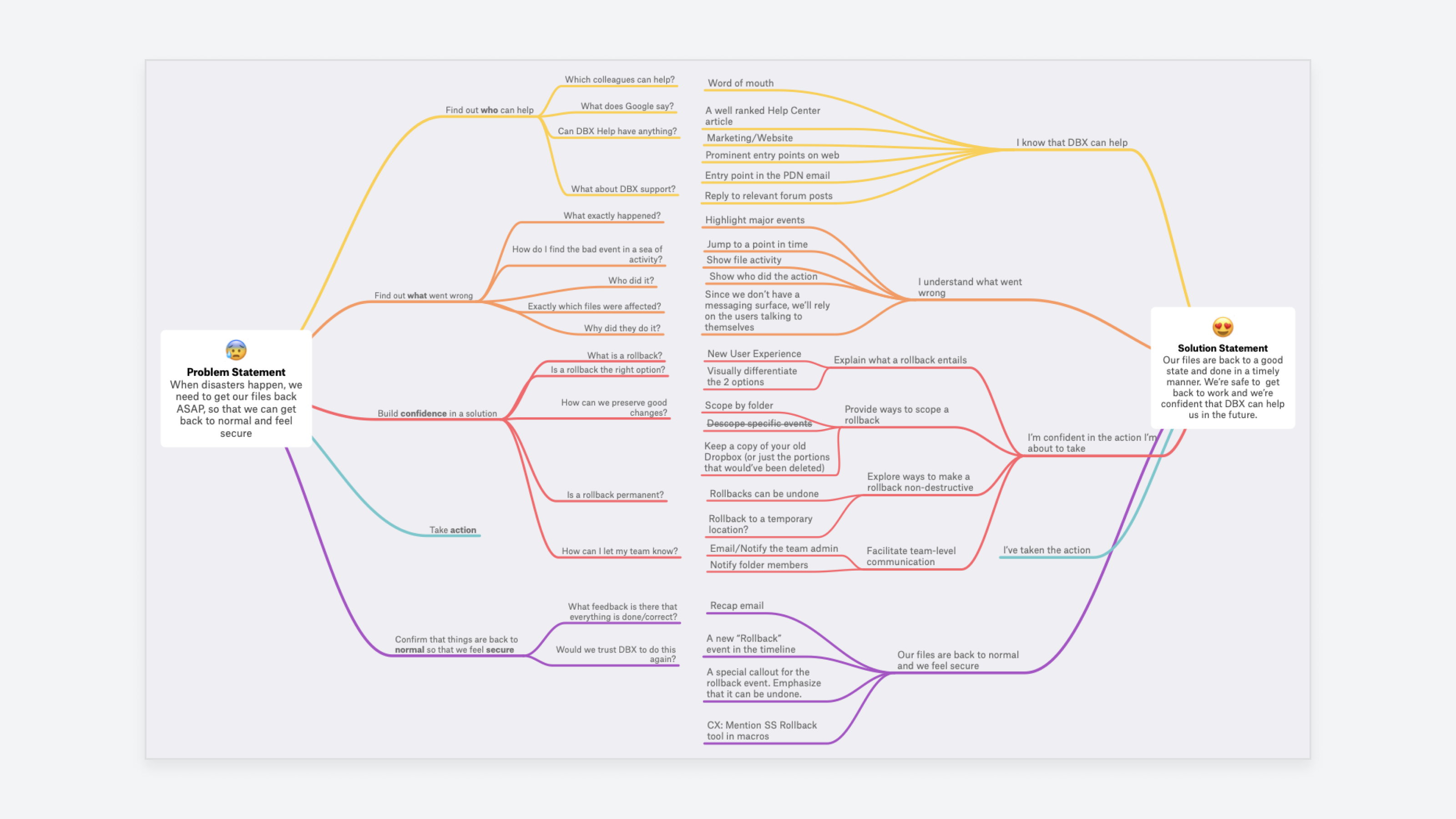
Sources
"Mental models for designers" by Wes O'Haire
"First Principles: The Building Blocks of True Knowledge" by Shane Parrish
婚姻
成就对方, 友谊加爱情.
友谊
不知道为什么有一种无为的感觉,不刻意结交,结交后也不会因此产生亏欠感觉.
政治与经济
历史如摆钟,要是不能悬崖勒马, 则时钟会摆了过去
政治结构入江水河流,自然,且不同
什么是幸福?
忘掉自己,
去行动,
不要一直陷入回忆.
恋爱与牺牲
幻想与现实的交融
让知识和问题的张力从你这里展开
我太渴望被人关注了,但是有害怕被过多关注,事实是没人关注